Pond Management Updates: Our Blog of Weed Treatments, Surveys, Closures, and Observations
Since 2004, the Foster's Pond Corporation has actively managed the Pond, treating for invasive weeds and algae while conducting systematic vegetation surveys to ensure a vibrant ecosystem of native plants. We've chronicled everything. Scroll down to see entries from 2004 through 2019. For more recent entries, 2020 to the present, click here.
2019: Managing With a Delicate Touch
Pond Gets 2d Algae Treatment
DASH Turns Into a Marathon
Dive Teams Set to Hand-Pull Some Fanwort
Pond Treated for Algae and Fanwort
Second Sonar Treatment Is Administered June 20
First Sonar Treatment Is Applied May 20
Treatment Plan Greenlighted by Commission
Conservation Commission Extends FPC Management Program; More Treatments Likely in 2019
2018: Controlling Small Infestations of Invasives and Averting Algae Blooms
Pond Treated for Blue-Green Algae
Benthic Barriers Deployed in Weed Control Experiment
Pond Treated for Weeds July 17; Residents Advised on Irrigation
15 Acres Get First "Booster" Treatment for Fanwort
15 Acres Treated for Fanwort
Weed Treatment Set for May 4
Commission OKs 2018 Weed Program
Annual Survey Recommends Spot-Treatments for Fanwort and Spiny Naiad
2017: Drought Heightens Algae Woes, and Spiny Naiad Returns
Main Pond Treated for Blue-Green Algae
Main Pond Hit With Blue-Green Algae, But Other Basins Stay Clear
Spiny Naiad Treated With Herbicide July 31
Conservation Commission Approves 2017 Treatment Plans
Vegetation Survey Finds Pond Almost Fanwort-Free, But Recommends Treating Another Invasive
2016: Algae Again in the Crosshairs
Pond Gets Season's Second Algae Treatment
New Blue-Green Algae Bloom Triggers Caution for Main Pond
Pond Treated for Blue-Green Algae
Cons Com OKs 2016 Algae Plan
2015: After Four Years, Another Fanwort Treatment
Commission Renews Our Pond Management Program
Treatment Targets Blue-Green Algae
Fanwort Hit With Third - And Likely Last - Treatment
Pond Gets Booster Treatment as Fanwort Fades
Follow-Up Treatment Set for May 27
Weed Treatment Slated to Start May 4
Conservation Commission Authorizes Fanwort and Algae Treatment Plans
Plant Survey Finds Dense Fanwort
2014: Keeping Algae on a Short Leash
Algae Stay Down, but Fanwort's Up
Mother Nature Chills, Keeping Algae Counts Down
After 2013 Success, Conservation Commission OKs 2014 Algae Plan
2013: Can Algae Be Controlled?
Blue-Green Algae Count Plummets After Treatment
Pond Treated for Blue-Green Algae
Health Warning: Keep Kids and Pets Out of the Pond
Conservation Commission Approves Algae Treatment Plan
Corporation Maps Plan to Combat Blue-green Algae
2012: Swimmers, Pets at Risk from Algae
Conservation Commission Expands Order to Include Algae Control
Consultant Recommends Possible Treatments for Algae
Algae Blooms Trigger Health Warnings
2011: First Whole-Lake Fanwort Treatment in Six Years
Post-Treatment Survey Finds No Trace of Fanwort
"PurLoo Beetles" Join Their Cousins to Attack Invasive Weeds
Dug Pond Gets Its Reward
Dug Pond to Be Treated July 7
"Booster" Shot Zaps Weeds; Dug Pond Is Next
Weeds Start to Fade; Pond Will Get "Booster" Treatment June 24
Treatment Starts Under Ideal Conditions
Weed Treatment Set for May 13
Conservation Commission OK's 2011 Treatment Plan
Corporation Sets Sights on Fanwort Treatment This Summer
2010: Focus on the New Invader, Spiny Naiad
Next Up: Consultant Recommends Pond-Wide Fanwort Treatment in 2011
Two Areas of Pond Receive Diquat Treatment
Diquat Treatment Set for July 19, Closing Pond and Limiting Irrigation
Inspection Finds Spiny Naiad and Fanwort
Conservation Commission Approves Diquat Plan
Consultant Submits Diquat Treatment Plan
FPC Board Moves Cautiously to Meet Spiny Naiad Threat
2009: Fanwort Spreads, and New Invader Appears
Conservation Commission Extends Lake Management Program
2009 Survey Finds More Fanwort and Discovers Spiny Naiad
2008: Where Has All the Fanwort Gone?
Weed Survey Shows Sharp Decline in Fanwort After Treatments
With Fanwort Slow to Rebound, Pond Is Surprisingly Weed-Free
2007 Weed Program In Action
Report: Channel Is Fanwort-Free, But Not Main Pond
Channel Gets 2d "Booster" Treatment
Weed Treatment Is Working Wonders
Fanwort Shows Signs of Fading
1st "Booster" Treatment Scheduled for June 25
Weed Treatment Is a (Noisy) Breeze
Fanwort's Up; Treatment Set for June 1
2007 Weed Agenda
With $ Coming In, FPC Board OKs Weed Contract
Conservation Commission Approves '07 Sonar Plan
Consultant Recommends '07 Treatment Plan for Fanwort
2006 Weed Program In Action
Final Report: Sonar KO'd "Dug Pond" Fanwort
Biologist: "Dug Pond" Treatment Is Complete
Inspection: No Fanwort in "Dug Pond" - But Channel Has Some
"Dug Pond" Gets 2d Sonar Treatment
"Weed Watchers" Train for Guard Duty
"Dug Pond" Receives Treatment for Nuisance Weeds
"Dug Pond" Treatment Scheduled for June 5
June 19 "Weed Watchers" Class Almost Full
2006 Weed Agenda
FPC Signs Contract for "Dug Pond" Weed Treatment
Fund Drive Tops Goal; Look Out, Weeds!
"Dug Pond" Fund Drive at 60% of Goal
FPC Kicks Off Fund Drive For "Dug Pond" Treatment
Conservation Commission OKs Glenwood Basin Treatment Plan
Cons Com to Vote Feb. 21 on Glenwood Basin Weeds
Conservation Commission to Consider Glenwood Basin Weeds
Corporation Endorses Treatment of Glenwood Road Basin
2005 Weed Program: Assessing the Progress
Final Report: Sonar Worked, But Keep an Eye Out for Weeds
Biologist Returns for Post-Treatment Assessment (September 2005)
Ask the Biologist
Will hydro-raking spread the cabomba?
What are those huge floating things that look like pineapples?
What can we do to treat the water lilies that come back?
What's the effect of the dead fanwort on the O2 and pH levels?
Why has the Pond become a Gatorade color?
What has the effect been on native plants?
What will the Pond look like over the next few years?
Would a drawdown and hand-pulling have done the job?
Should we train "weed-watchers" to look for fanwort outbreaks?
Why is there increased pondweed in Frye's Brook?2005 Weed Program in Action
As Fanwort Fades, No More Treatments On Tap (August 2005)
Biologist Finds Fanwort Die-Off Throughout Pond (August, 2005)
Weeds Wilt As Sonar Levels Hold Steady (August 2005)
Second Booster Treatment July 14 (July 2005)
Herbicide Starts Its Work: Fanwort Begins to Fade (June 2005)
Booster Treatment #1; Water Use Restrictions in Effect (June 2005)
Sonar Comes in With a Roar (June, 2005)
Stage Set for Sonar Treatment (June, 2005)
Drawdown Commences (May, 2005)
Making It Happen: The Last Few Steps
Fundraising Goal Topped: FPC Raises $43,100 (September 2005)
Sonar Contributions Top $38,500 (June 2005)
Drawdown Slated to Begin May 23 (May, 2005)
Contract Signed, Treatment to Start June 6 (May, 2005)
Corporation Board Says This is the Year (May 2005)
Putting a Program in Place: Getting Approvals
FPC Program Clears Final Regulatory Hurdle (April 2005)
DEP Upholds Corporation Weed Program (March 22, 2005)
DEP Conducts Site Visit (March 15, 2005)
Conservation Commission Issues Order, Resident Appeals (February 2005)
Conservation Commission Votes Final Approval (January 2005)
Conservation Commission Votes Preliminary Approval (December 2004)
Developing a Program: The Study and What it Recommends
Weed Study Submitted: Recommends Sonar and Drawdowns (October 2004)
Read more about the elements of the recommended program:
Herbicide Use
Sonar FAQs
How does Sonar work?
Is there much experience with its use?
What will the effects be on shallow wells?
Are there swimming or fishing restrictions?
Is Sonar a permanent solution?
Drawdowns
Hydro-raking
Control of Nutrient Inputs
Learn More
Biologist Collects Data on the Pond (August 2004)
Pond Gets 2d Algae Treatment
August, 2019
The Main Pond and the Outlet Cove (that's the basin between the Channel and Rock Island) were treated with copper sulfate August 8, a precautionary measure to ward off a hazardous bloom of blue-green algae.
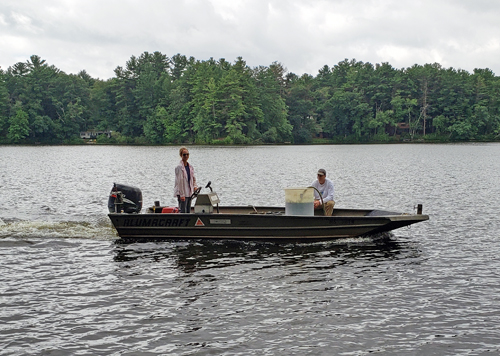
August 8: Solitude Lake Management aquatic biologist Kara Sliwoski (standing), assisted by intern Jacob Girard, slowly navigate the Main Pond diffusing copper sulfate solution to kill blue-green algae.
Volunteers taking water clarity readings around the Pond had noted a marked increase in the murkiness of both areas, and a tell-tale film of blue-green scum was observed in the Main Pond earlier in the week.
Blue-green algae in higher concentrations can cause gastrointestinal distress in kids (who are more likely than adults to swallow water when swimming), and can be fatal to pets.
With continued warm weather in the forecast, the Corporation called in its lake management consultant to treat the two basins.
The Pond has been treated for blue-green algae every year but one beginning in 2013, but this is only the second season that two treatments have been administered. In 2016 - like this year - hot weather and low water levels turned the Pond into a Petri dish for cultivating algae.
Residents and visitors are cautioned even after an algae treatment to look out for thin, blue-green scum floating on the surface, especially where the wind may have blown accumulations to the shoreline. Avoid swimming or letting your pet drink where blue-green surface scum is visible.
DASH Turns Into a Marathon
August, 2019
Diver-assisted suction harvesting - a non-chemical technique for removing invasive weeds - goes by the acronym DASH, but its first-time appearance on Foster's Pond developed into a slow-motion marathon.
Low water and balky equipment slowed DASH to a crawl August 5, and it quickly became apparent that what started as a two-day experiment was likely to extend into the following week.
The target of the experiment was a one-acre stand of fanwort at the mouth of the Mill Reservoir that the FPC intentionally left alone when four other areas were treated with Sonar earlier in the summer.
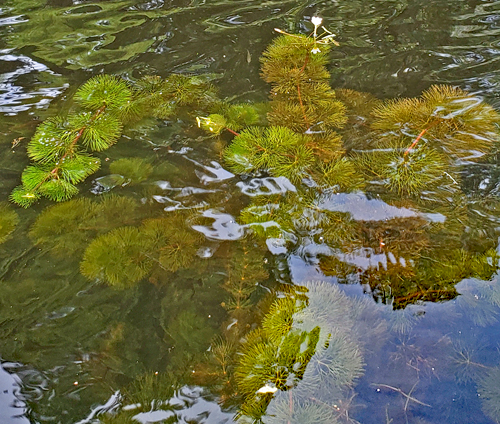
August 6: Fanwort at the mouth of the Mill Reservoir. This colony of the invasive weed, observed in last year's vegetation survey, was intentionally left untreated to test the efficacy of DASH, a non-chemical control technique.
But where the crew applying the herbicide could get on and off the Pond within three or four hours, having treated more than 7 acres, the DASH crew took much longer just to get their gear on the water.
And that was just the beginning.
Foster's Pond is only a couple of feet deep in many areas, including the passageway from the Main Pond to the Mill Reservoir.
And while a jon boat or an airboat dispersing Sonar can skim in and out with ease, not so a Boston Whaler loaded with diving gear and towing a raft-full of suction equipment.
In a scene straight from The African Queen, diver David Armas had to jump into the mucky channel to pull the raft and push the boat for a couple of hundred painfully slow yards.
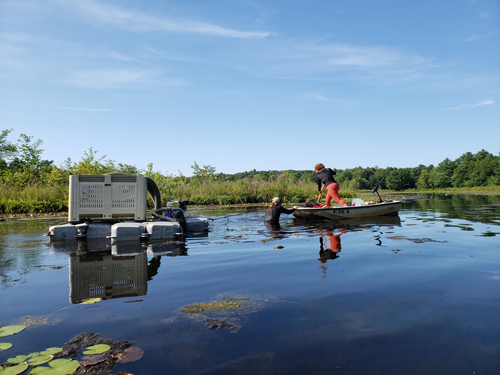
August 5: A remake of The African Queen? With diver David Armas standing in for Humphrey Bogart, assistant Lucy Pereyra poling the boat in place of Katherine Hepburn, and an aging Boston Whaler replacing Bogie's rustbucket African Queen.
Operations finally began late the following morning, only to be brought to a standstill by a temperamental water pump. The brand-new pump had tested perfectly near the shore, but went on strike after just an hour on the job.
Meanwhile, another pair of divers continued hand-pulling fanwort in Dug Pond, a job which began the day before but ran over to Day 2. When they finished that assignment, their next task would be helping out at the DASH site.
Dive Teams Set to Hand-Pull Some Fanwort
August, 2019
Divers will have a go at hand-pulling fanwort in two locations beginning August 5.
The effort is an experiment by the Foster's Pond Corporation with using non-chemical control techniques to supplement the use of herbicides.
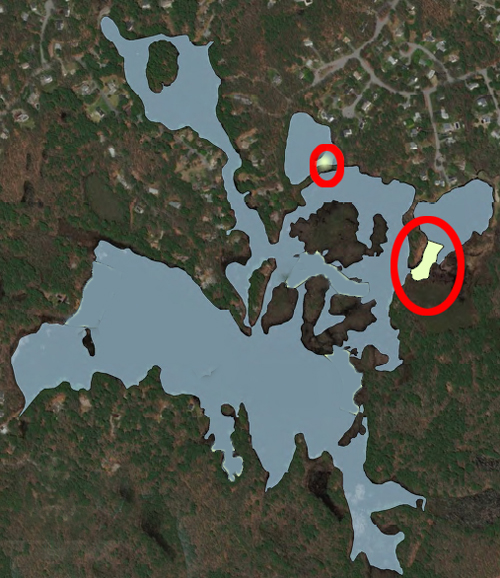
August 5: Divers will remove fanwort from two locations: the mouth of the Mill Reservoir (the larger oval on the right) and a smaller area of Dug Pond.
It's the first time that divers have been deployed against fanwort, a persistent invasive weed which dominated the Pond before the Corporation began a lake management program in 2005.
Earlier this year, about 7.5 acres of the Pond were treated with Sonar, a slow-acting herbicide that successfully controls fanwort. But another one-acre infestation at the mouth of the Mill Reservoir was intentionally left untreated for this test, and that's the primary location divers will focus on.
The divers, employed by Boston-based Aquatic Vision LLC, will use a technique known by the acronym DASH - diver-assisted suction harvesting. A diver gently pulls out the plant while guiding the business end of what amounts to an aquatic vacuum cleaner, carefully feeding the plant, including its roots, into the suction hose. The plant matter is filtered out on the surface, collected, and brought to shore for off-site disposal.
Meanwhile, a second dive team will attack a much smaller infestation of fanwort in Dug Pond. The second team will hand-pull the weeds, but not use the suction mechanism, instead depositing fanwort in a bag before bringing it to the surface for disposal.
Work at the Mill Reservoir is expected to take two days. Removal of fanwort at Dug Pond is expected to take half a day.
Pond Treated for Algae and Fanwort
July, 2019
Foster's Pond was treated for blue-green algae July 17, the day after samples drawn from three locations turned up significant concentrations of the hazardous organism.
Copper sulfate was applied to 60 of the Pond's 120 acres. The treated areas included the Main Pond, the Mill Reservoir, the Outlet Cove, and the Channel.
Water clarity readings on July 16 signaled the potential for dangerous algae blooms. The drop in clarity was particularly evident in the Mill Reservoir, which often escapes algae blooms because of its greater depth than most other parts of the Pond.
Samples from three basins - the Main Pond, the Outlet Cove, and the Mill Reservoir - contained blue-green algae, which can cause gastrointestinal distress in children and be fatal to pets.
The sample from the Mill Reservoir had the highest concentration, likely related to storm water run-off flowing into that basin from Frye's Brook during recent rains.

July 16: Samples drawn from the Main Pond, the Outlet Cove, and the Mill Reservoir contained blue-green algae. The highest concentration was observed in the Mill Reservoir. With continued hot weather in the forecast - perfect conditions for triggering a dangerous algae bloom - the Corporation arranged for a copper sulfate treatment to be administered July 17.
With most of the Pond already slated to close July 17 for the summer's third - and final - fanwort treatment, the Corporation requested its lake management consultant to administer the copper sulfate treatment, as well.
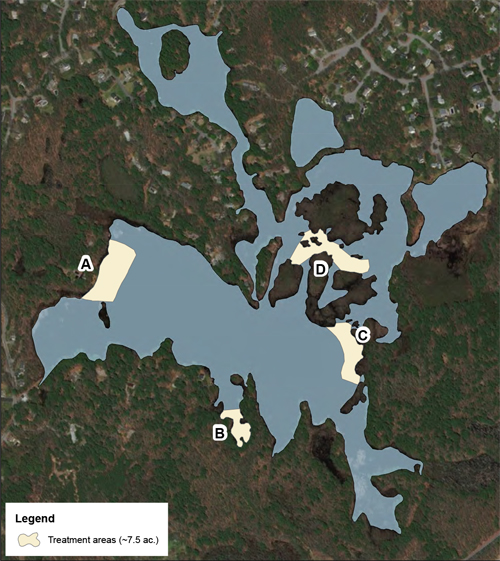
Four areas were targeted for treatment to control fanwort this year, with the third and final treatment administered on July 17. Only the three residences near areas A and B were cautioned to refrain from using Pond water for irrigation for the summer.
The timing was fortunate. It can take days to get a blue-green algae treatment in mid-summer, when demand is high. But the algae won't wait. With weather forecast predicting soaring temperatures over the following week-end, the potential for a massive algae bloom loomed large.
Second Sonar Treatment Is Administered June 20
June, 2019
As rain poured down, technicians from the Corporation's lake management consultant administered the summer's second herbicide treatment to control fanwort. As with the first treatment a month earlier, the Pond was temporarily closed for recreational uses.
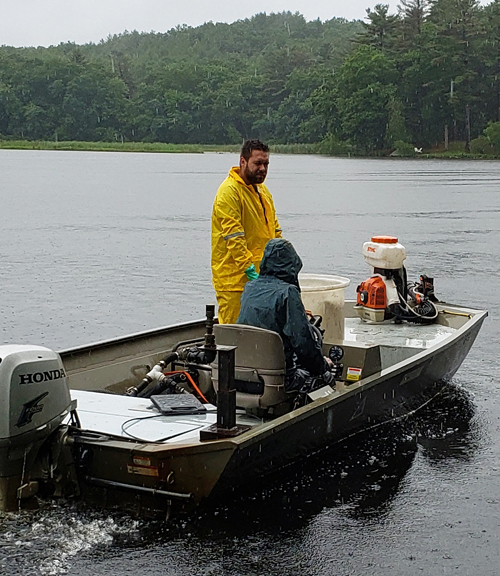
June 20: Aquatic specialist Jim Rullo (standing) and biologist Kara Sliwoski head for one of the target areas in the Main Pond to disperse Sonar-infused clay pellets.
On June 20, herbicide-infused clay pellets were dispersed in the same four areas that were treated in May. The aim of such supplemental treatments is to keep a very low concentration of fluridone - the slow-acting chemical which causes fanwort to bleach out and die - present in water near the invasive weeds for a period of 90 days. But fluridone, sold under the brand name Sonar, has a short half-life, necessitating a couple of "booster" treatments to maintain the concentration. The final treatment will be applied in July.
First Sonar Treatment Is Applied May 20
May, 2019
The first of three treatments to control scattered infestations of fanwort was applied on May 20. The Pond was closed for recreational uses for the day. Dug Pond and the Mill Reservoir were not treated and were not affected by the closure.
Four areas were slated for treatment to control fanwort this year. Only the three residences near areas A and B are cautioned to refrain from using Pond water for irrigation for the summer. Click the image to view a larger map.
The Corporation's lake management consultant applied fluridone, a slow-acting herbicide in four locations - three in the Main Pond and one in a marshy area lying between the Mill Reservoir and the Channel. Only three residences are close enough to a treatment area to be affected by an extended caution to refrain from using Pond water for irrigation through much of the summer.
In all, about 7.5 of the Pond's 120 acres were treated with the herbicide, which is sold under the brand name Sonar. The State deems the chemical safe for use in public drinking water reservoirs. The Sonar was applied in accordance with an Order of Conditions approved by the Andover Conservation Commission.

May 20: Biologist Kara Sliwoski spreads Sonar-infused clay pellets over a fanwort infestation in the Main Pond. Photo by John Lugus.
Solitude Lake Management biologist Kara Sliwoski traversed each of the targeted treatment areas in a small jon boat, disbursing Sonar-infused clay pellets from a portable spreader. She used a hand-held GPS unit and calibration controls on the spreader to determine the right rate of pellet distribution in order to achieve the low Sonar concentration effective for fanwort control.
The pellets sink to the bottom and dissolve slowly, infusing small amounts of Sonar over a three- to four-week period, after which a booster treatment is applied. The low concentration of Sonar must remain in the water for 90 days to kill fanwort.
As with prior uses of Sonar in Foster's Pond, the initial treatment will be followed by two booster treatments spaced about a month apart.
Treatment Plan Greenlighted by Commission
April, 2019
The Andover Conservation Commission approved plans recommended by the Corporation's lake management consultant to treat about 9 acres of the Pond this year to control fanwort. The initial treatment is expected to be applied May 20, with two booster treatments spaced about a month apart.
Additionally, the Commission authorized a separate herbicidal treatment for another invasive, spiny naiad, if infestations are observed.
And if an unhealthful bloom of blue-green algae is detected later this summer, the Corporation is authorized to call in a copper sulfate treatment.
The Commission's unanimous vote to approve the treatment plan came at a meeting on April 16. The Commission also approved hydro-raking 10 shoreline properties.
The Commission vote is in line with its approval last December of a three-year extension of the Order of Conditions which governs the Corporation's lake management program. The OOC requires annual approval of any herbicidal treatment and any change in the list of hydro-raking participants.
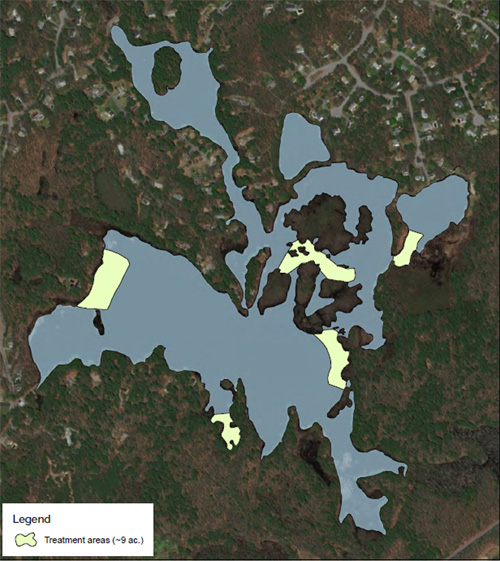
The Corporation's annual vegetation survey last fall identified about 9 acres of fanwort infestation that will be targeted for treatment or DASH this year.
The fanwort treatment calls for the dispersion of clay pellets infused with fluridone, a slow-acting herbicide which interrupts a plant's ability to protect itself from the bleaching effects of sunlight. The herbicide, sold under the brand name Sonar, is employed in low concentrations approved in Massachusetts for use in public water supplies. The Pond will be closed for the day on each occasion when the Sonar pellets are applied, but will re-open the following day.
Although only the treatments and hydro-raking required Commission votes, most of the Commission's discussion centered on new weed-control techniques the Corporation is trying.
The Corporation will continue its experiment with deploying portable, light-proof bottom barriers to snuff out small infestations of invasive weeds.
And the Corporation will for the first time employ diver-assisted suction harvesting (or "DASH") to remove a stand of fanwort. DASH involves a two-person crew using what amounts to an aquatic vacuum cleaner operating on a surface craft. A diver guides the business end of the vacuum, carefully sucking up the individual plants and their roots, trying to ensure that none of the fragile stems drift off to root elsewhere, while a colleague in a boat tends the machine, which filters out the target plant matter for disposal on land.
The technique is far costlier than herbicidal treatment on per-acre basis, but has not previously been tested on Foster's Pond.
Conservation Commission Extends FPC Management Program; More Treatments Likely in 2019
December, 2018
The Andover Conservation Commission unanimously approved a three-year extension of the Order of Conditions which governs the Corporation's lake management program.
The vote came at a Commission meeting December 4. Accepting a recommendation from the Corporation, the Commission approved the addition of two non-chemical measures to control invasive weeds.
One of the new measures is the use of portable light-blocking cloth barriers that can be deployed to smother small stands of invasive weeds. Nine of these "benthic barriers" were laid down by volunteers late this summer on an experimental basis. They were removed on December 5. The results will be evaluated next year, when submerged plants start growing, to see if the fanwort which was targeted re-emerges.
The second control technique authorized by the Commission is diver-assisted suction harvesting ("DASH"). The method employs a sort of aquatic vacuum cleaner mounted on a boat, with its suction hose manipulated by a diver. The hose sucks up plant material, which is filtered out by screens in the boat and collected for on-shore disposal. DASH is slow and expensive, and will likely be tried the year after the entire Pond has been treated for fanwort, when only a few plants re-appear. No whole-lake treatment is presently contemplated.

August 23: As part of the 11th Pond vegetation survey, the FPC's consultant mapped locations of invasive weeds which will require treatment in 2019.
In approving the program extension, the Commission considered the 2018 annual Pond report prepared by the Corporation's consultant, Solitude Lake Management. The 39-page report included results of the 2018 Pond-wide vegetation survey conducted in August. The survey relies on sampling at 61 data points, most of them established at the time of the first survey in 2004. This year's survey was the 11th commissioned by the Corporation.
The survey found fanwort substantially down from 2017, after last summer's spot treatment of 15 acres. But fanwort was detected in about 9 acres that were not treated in 2018 and will require treatment in 2019. Similarly, no spiny naiad was found in the 5.5 acres treated in 2018, but it cropped up in about 7 acres that may require treatment in 2019.
Water quality, according to the survey, generally remained good, in line with results found in previous years. However, fecal coliform was higher than desirable in the Mill Reservoir for the first time since the surveys have been conducted. The consultant attributed the spike to higher than normal rainfall prior to the survey, resulting in stormwater run-off along Frye's Brook, which empties into the Mill Reservoir.
Pond Treated for Blue-Green Algae
August, 2018
Foster's Pond was treated for blue-green algae August 23. Copper sulfate was applied to the Main Pond, the Mill Reservoir, the Channel, and the Outlet Cove. The Pond was closed to fishing, boating and swimming for the day.
Benthic Barriers Deployed in Weed Control Experiment
August, 2018
In an experiment testing non-chemical controls for invasive weeds, volunteers spent several hours on a sultry August morning dropping light-weight barriers on top of fanwort plants in the Main Pond.
The 5' x 5' so-called "benthic barriers" consist of plastic mesh fabric stretched on PVC pipe frames, designed to block sunlight and snuff out the unwanted weeds. A few handfuls of pebbles dredged from the Pond in the course of hydro-raking are enough to hold the barriers in place, and plastic jugs, painted bright orange, mark the locations for future retrieval of the barriers.
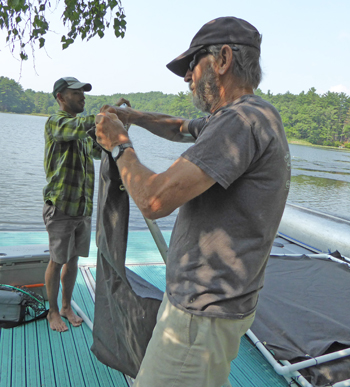 |
| August 16: Volunteers Ethan Davis (left) and John Lugus assemble benthic barriers for deploymnet in the Main Pond. |
Anglers are asked to avoid casting near the orange markers, as lures will snag the barriers, rip the cloth, and ruin the experiment.
In all, nine barriers were deployed, all of them near the northwesterly shore of the Main Pond, closest to White Oak Drive.
It took three volunteers using a canoe and a bass boat to wrestle the barriers into position and steady them as they sank to the bottom. But despite the effort, some of the downsides of using this method of control quickly became evident.
While the barriers were designed to snuff out isolated stands of fanwort, once the volunteers got down in the weeds, as it were, they observed far more fanwort in the Main Pond - which went largely untreated this year - than could be covered by bottom barriers.
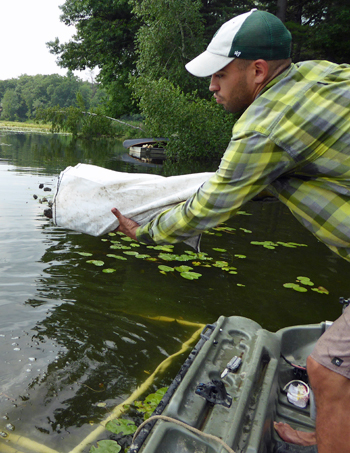 |
| August 16: Ethan Davis spreads a few pebbles to keep the benthic barrier in position. |
Just as discouraging, even careful placement of the barriers caused pieces of the target plants to break off, and fanwort spreads by fragmentation. Even if the target plant dies, the fragments that were dislodged are likely to take root elsewhere.
The barriers will be retrieved in the fall, when fanwort normally goes dormant for the winter. The locations will either be marked with buoys or geolocated with a GPS app. Next spring, when fanwort re-emerges, it should be possible to determine whether the barriers actually killed the plants directly under them.
The Andover Conservation Commission has strongly urged the Corporation to examine the feasibility of non-chemical vegetation controls to supplement or supplant the use of herbicides.
Pond Treated for Weeds July 17; Residents Advised on Irrigation
July, 2018
About 20 acres in scattered parts of the Pond were treated for invasive weeds on July 17, following an inspection by an aquatic biologist from the FPC's lake management consultant the previous week.

July 17: Solitude Lake Management aquatic biologist Kara Sliwoski maneuvers airboat in the Main Pond as treatment gets underway.
Two different treatments were administered, one for fanwort and another for spiny naiad. Both are invasive weeds which, if unchecked, form dense stands that can push out native plants and choke the Pond.
The Pond was closed to swimming, boating, and fishing for the day. Shoreline property owners near the fanwort treatment areas in the Outlet Cove, the Channel, the Azalea Drive basin, and in the southwesterly cove of the Main Pond were again reminded not to use Pond water for irrigation until at least mid-August. Property owners near the spiny naiad treatment areas in the Main Pond - on White Oak Drive, Pomeroy Road, and Willard Circle - should not use Pond water for irrigation until July 23.
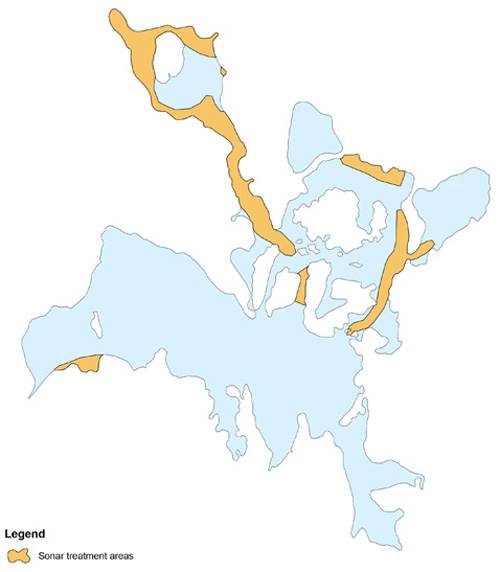
Fanwort treatment areas: Owners of property near these areas, which received a booster treatment of Sonar on July 17, were cautioned not to use Pond water for irrigation until August 17.
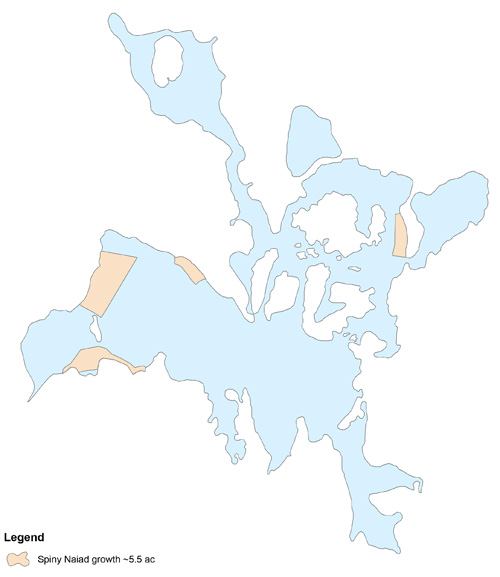
Spiny naiad treatment areas: Owners of property near these areas, which were treated with diquat on July 17, were cautioned not to use Pond water for irrigation until July 23.
Fifteen acres were treated for fanwort, This was the third and last fanwort treatment for the Summer. The same areas were initially treated on May 4, with a booster treatment on June 4. The July 17 treatment used the same herbicide, fluridone, which is sold under the brand name Sonar. It causes the fanwort to bleach out in sunlight and die. In the very low concentrations used in Foster's Pond - and approved for use in public drinking water supplies - the process takes up to 90 days.
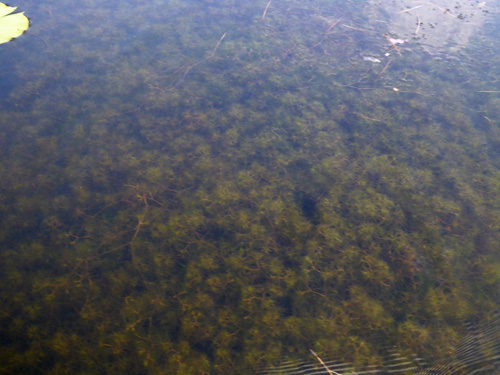
July 11: Spiny naiad in the Main Pond. The invasive can form dense colonies which drive out native plants.
On July 11, when aquatic biologist Kara Sliwoski from Solitude Lake Management toured the Pond to assess results and look for spiny naiad, there was little fanwort growth in the treatment areas, and almost all of the remaining fanwort was exhibiting whitened branch tips that, in healthy plants, would be bright green. The white tips are evidence that the treatment is working.
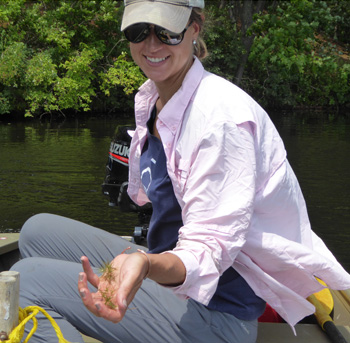 |
| July 11: Aquatic biologist Kara Sliwoski with a strand of spiny naiad taken from the Main Pond. |
About 5 acres were treated for spiny naiad. Some stands, near the mouth of the Mill Reservoir, were already showing signs of succumbing to the Sonar treatment but were hit during the July 17 treatment with a more effective control agent, diquat.
In the Main Pond, outside the Sonar treatment areas, denser colonies of spiny naiad were flourishing and were treated for the first time on July 17. Spiny naiad is an annual that spreads by dropping millions of seeds, some of which can stay viable for more than a year, so it is unlikely that this year's treatment will be the last.
The treatments followed protocols approved by the Andover Conservation Commission under an Order of Conditions that authorizes the Corporation to treat the Pond for invasive weeds.
15 Acres Get First "Booster" Treatment for Fanwort
June, 2018
A month after 15 acres of the Pond were treated for fanwort, the Corporation's lake management consultant was back out administering a "booster" treatment.
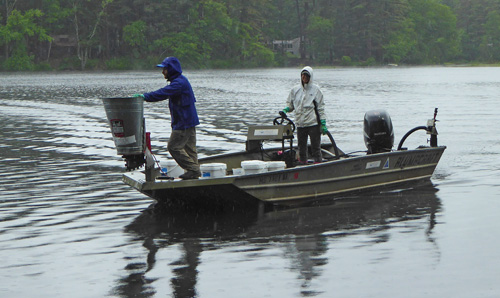
June 4: A team from Solitude Lake Management returned to administer a "booster" treatment for fanwort.
The aim is to maintain a low concentration of the slow-acting herbicide - fluridone, sold under the brand name Sonar - which is the only effective means authorized by the State to control the invasive weed, which once dominated the Pond. Sonar breaks down relatively quickly, and a second "booster" will be applied in July.
The Pond was closed to fishing and boating for the day, and shoreline owners adjacent or near to the treatment areas are advised not to use Pond water for irrigation until at least mid-August.
The treatment areas for the June 4 booster were identical to those treated on May 4.
15 Acres Treated for Fanwort
May, 2018
The Pond underwent its first fanwort treatment in exactly three years on May 4, but only an eighth of its acreage received any of the slow-acting herbicide that controls the invasive weed. A booster treatment was scheduled for June 4, with a second booster to follow about a month after that.
The Pond was largely closed to fishing and boating for the day, and shoreline owners adjacent or near to the treatment areas are advised not to use Pond water for irrigation until at least mid-August. Two booster treatments are slated over the next two months, and it takes about 30 days for the herbicide to completely break down.
About 15 acres of the Pond were treated - one acre in a shallow cove in the western "wing" of the Main Pond, and 14 acres in the Outlet Cove, the Channel, the basin at the end of Azalea Drive, and along the Goldsmith Woodlands shoreline. Dug Pond, the Mill Reservoir, and most of the Main Pond were not treated.
May 4: The gold-shaded areas were treated with clay pellets infused with fluridone, a slow-acting herbicide effective in controlling fanwort. The pellets gradually release the fluridone over time. Two booster treatments are planned. Shoreline owners should not use water from these or near-by areas of the Pond for irrigation until at least mid-August.
Fluridone, sold under the brand name Sonar, works by blocking the plant's production of carotene, a yellow pigment which protects chlorophyll from breaking down under sunlight. Without the pigment, the plant slowly bleaches out and dies. The process (called "chlorosis") can take upwards of 6 to 8 weeks to start - an advantage, since the slow dying avoids the prospect of sudden oxygen depletion (which could result in fish kills) or nutrient release (which could result in algae blooms). The trick is to maintain a low concentration of Sonar in the Pond over a 60- to 90-day period. Since the Sonar itself breaks down, and works at extremely low doses, effective treatment requires monitoring, with one or two "booster" shots as concentrations fall.
The target concentration is between 10 and 20 parts per billion (ppb). Environmental regulators allow concentrations of Sonar up to 20 ppb in public drinking water supplies, and even though Foster's Pond is not used for drinking, the FPC requires the concentration to be kept below this threshold.
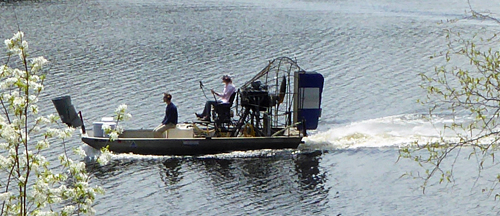
May 4: After treating one acre in the Main Pond, Solitude Lake Management environmental scientist Eric Kuhn and aquatic biologist Kara Sliwoski (at the controls of the airboat) head towards the Channel.
The treatment program is based on recommendations from the Corporation's lake management consultant, and was approved April 17 by the Andover Conservation Commission.
Initial Weed Treatment Set for May 4
April, 2018
About 15 acres of the Pond will be treated with a slow-acting herbicide on May 4, triggering a one-day closure of most access points and an advisory not to use treated water for irrigation.
The treatment - and the closure - will affect the Dam, the Outlet Cove, the Channel, the basin at the end of Azalea Drive, and part of the Goldsmith Woodlands shoreline, including Bessie's Point. A cove off Willard Circle will also be treated. Dug Pond, the Mill Reservoir, and most of the Main Pond will not be treated.

The plan: The initial Sonar treatment for fanwort will spread slow-release pellets in the gold-shaded area, which will be closed to swimming, boating and fishing for the day. Shoreline owners should not use water from these or near-by areas of the Pond for irrigation until at least mid-August.
Owners of shoreline property adjacent to the treated areas are advised not to use Pond water for irrigation until at least mid-August, as the May treatment will be followed by two booster treatments about a month apart.
The target of this round of treatment is fanwort, an invasive weed that once threatened to strangle the Pond. It will be treated with fluridone (sold under the brand name Sonar), which has been used previously in Foster's Pond and, at the low doses that will be employed, is authorized for use in public drinking water reservoirs.
The treatment program is based on recommendations from the Corporation's lake management consultant, and was approved April 17 by the Andover Conservation Commission.
Commission OKs 2018 Weed Program
April, 2018
The Andover Conservation Commission unanimously approved the Corporation's 2018 program for controlling nuisance vegetation.
The program is based on recommendations from the Corporation's lake management consultant, and includes the herbicidal treatment of fanwort, an invasive weed that was once the dominant plant in Foster's Pond.
The fanwort treatment employs extremely low concentrations of a slow-acting agent that has been approved for use in public drinking water reservoirs. Once the treatment begins in May, residents abutting affected areas of the Pond will be advised not to irrigate lawns or gardens with water from the Pond for most of the summer.
The approved program also allows treatment of scattered areas of the Pond for another invasive weed, spiny naiad. But that part of the program won't be implemented unless spiny naiad is detected in a survey tentatively slated for July. If spiny naiad shows up outside the areas that will be treated for fanwort, additional advisories on irrigation will be issued.
And if toxic blue-green algae appear during the summer, the Conservation Commission has authorized the Corporation to administer copper sulfate. The Pond has been treated for blue-green algae several times in recent years.
The Pond is normally closed for the day whenever a chemical is administered. There may be several closure alerts this summer. The treatment regimen for fanwort calls for an initial treatment followed by two "booster" treatments a month apart.
The Commission also gave the green light to this year's hydro-raking program. Thirteen shoreline property owners signed up for hydro-raking, the most participants since 2004. Hydro-raking removes organic sediments which can provide nutrients for algae.
This year, for the first time, the Corporation plans to experiment with deploying portable "benthic barriers" to smother small stands of fanwort. The barriers - light-proof cloth stretched on frames roughly the size of a sheet of plywood - can be dropped on a minor infestation of the invasive weed to stop it from spreading. The Commission strongly encouraged the experiment.
The Commission approved the Corporation's 2018 program at a meeting on April 17. The Corporation carries out its lake management program under an Order of Conditions issued by the Conservation Commission.
Annual Survey Recommends Spot-Treatments for Fanwort and Spiny Naiad
January, 2018
The Corporation's lake management consultant, reporting on a comprehensive late-Summer vegetation survey of the Pond, has recommended planning for spot-treatments of two invasive weeds, fanwort and spiny naiad.
The recommendation is one of several contained in a 41-page report on the survey submitted to the Corporation and the Andover Conservation Commission by Solitude Lake Management, Inc., on January 4.
The report includes data from the tenth in a series of comprehensive vegetation surveys the FPC has commissioned since beginning our lake management program in 2004.
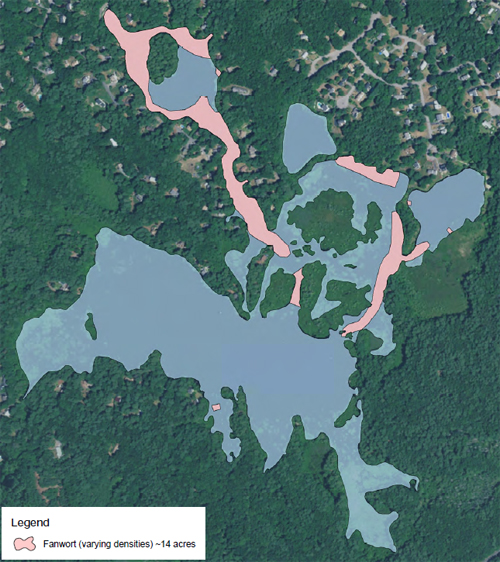
September 11, 2017: Using 56 GPS data points established in prior vegetation surveys, the FPC's consultant recorded the location and density of plants throughout the Pond, including fanwort depicted on this map.
Highlights of the report include the following findings:
- Our 2017 copper sulfate treatment, which was limited to the Main Pond, successfully kept blue-green algae counts below thresholds at which health concerns arise;
- Our 2017 diquat treatment of approximately 10 non-contiguous acres appears to have eliminated spiny naiad in all of the treated areas, but by the end of the summer spiny naiad had emerged in three untreated locations;
- As a result of our 2015 whole-lake fluridone treatment, fanwort remained at reduced levels for the third year in a row, but had re-emerged in about 14 acres, mostly in the Channel, the Outlet Cove, and the channel between the Main Pond and the Mill Reservoir;
- Fecal coliform counts continued to be low throughout the Pond (including Dug Pond);
- Filamentous algae (harmless but a nuisance) was the dominant plant in many parts of the Pond, possibly due to abnormally dry conditions,which lingered well into April; and
- Phosphorous (essential for algae growth) was within desirable levels in Dug Pond and the Mill Reservoir, but in excess of the target threshold recommended in our new Watershed-Based Plan for the Main Pond and the Outlet Cove.
Based on these findings, Solitude recommended that for 2018 we (1) monitor blue-green algae and treat if necessary to forestall a bloom that would likely exceed healthful limits; (2) prepare to treat infestations of spiny naiad that survived our 2017 treatment; and (3) treat portions of the Pond for fanwort before it spreads widely to the Main Pond. The report contains an analysis of non-chemical alternatives for combatting the infestations of spiny naiad and fanwort, but concludes that mechanical alternatives would be infeasible for controlling vegetation extending over several acres.
Solitude also provided information about the use of alum treatments to reduce phosphorous, and recommended that we have sediment samples analyzed for phosphorous content to help evaluate the potential effects of such treatments. The FPC Board has historically been opposed to alum treatments, and last year commissioned the Watershed-Based Plan to explore alternatives to introducing another chemical into the Pond. The Order of Conditions governing our lake management program does not allow the use of alum, and the FPC has not recommended amending it to authorize alum.
The Corporation will review Solitude's report and our new Watershed-Based Plan and will in turn make a recommendation to the Andover Conservation Commission for managing nuisance vegetation in 2018.
Main Pond Treated for Blue-Green Algae
August, 2017
The Main Pond, the largest open water basin of Foster's Pond, was treated with copper sulfate August 9 after two strains of toxic algae were detected in scum along the easterly shoreline.
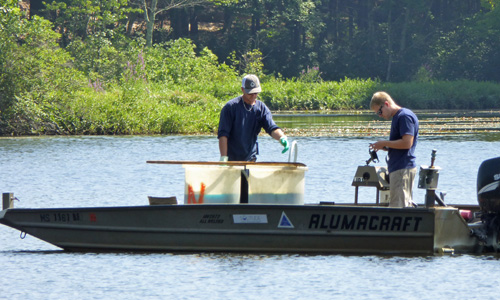
August 9: Technicians from Solitude Lake Management prepare copper sulfate solution for infusion into the Main Pond.
Water samples taken earlier in the week found blue-green algae in the Main Pond, but little or none in other parts of Foster's Pond. Portions of the Pond have been treated for algae in 2013, 2015, and twice in 2016.
The treatment was carried out by the Corporation's long-time consultant, Solitude Lake Management, under a program approved by the Andover Conservation Commission.
Blue-green algae can cause skin rashes, and kids are especially susceptible to gastrointestinal problems. Ingesting the algae - whether by drinking from contaminated water or licking algae from their fur after swimming - can be fatal to dogs.
Main Pond Hit With Blue-Green Algae, But Other Basins Stay Clear
August, 2017
Water samples taken from around the Pond on August 7 indicated the presence of blue-green algae in the Main Pond. While there wasn't much of it in samples taken from the middle of the Pond, a sickly green scum coating the surface along much of the easterly shore - properties facing Pomeroy Road - contained a mix of two strains of the toxic algae.

August 7: This sickly scum extending along the easterly shore of the Main Pond contained two types of blue-green algae, anabaena and microcystis.
Samples drawn from elsewhere around the Pond, including the Mill Reservoir and the basin at the end of Azalea Drive, contained little or no blue-green algae. A sample from the Channel, at its confluence with the Outlet Cove (the basin between the Channel and Rock Island), contained a harmless species of algae, but no blue-green.
A copper sulfate treatment of the Main Pond was set for August 9, in accordance with a plan approved by the Andover Conservation Commission earlier this year.
Residents continued to be cautioned - even after the treatment - to stay out of water exhibiting a blue-green scum, which can accumulate along shorelines anywhere in the Pond. Blue-green algae can cause skin rashes, and - especially in children - gastrointestinal problems. Blue-green algae can be fatal to dogs.
Spiny Naiad Treated With Herbicide July 31
July, 2017
Portions of Foster's Pond were treated with an herbicide on July 31 to control spiny naiad, an invasive weed whose presence was detected in last year's vegetation survey.
The largest concentration of the nuisance weeds was found in the Channel, but a careful examination of shorelines just before the treatment began found infestations in a corner of the Azalea Road basin and a half dozen locations around the Main Pond. None appeared to be growing in Dug Pond or the Mill Reservoir. Diquat (sold under the brand name Reward) was applied to areas where the weed was detected.
Residents and visitors were cautioned not to swim, fish or boat in treated areas July 31; not to use water within 200 feet of those areas for irrigation until August 6; and to keep pets away from treated areas until August 2. The Dam was closed for the day.
The treated areas are shown on this map:
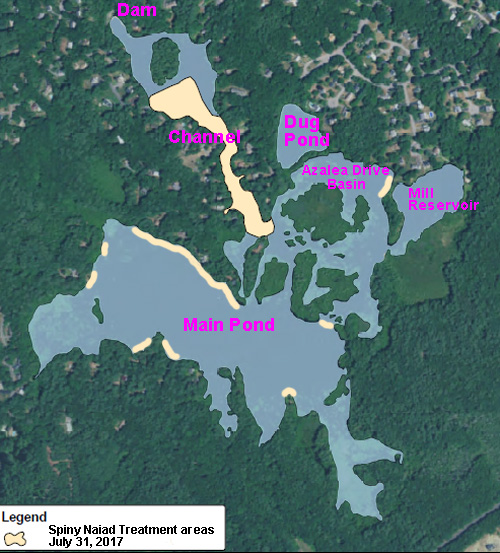
The treatment was carried out by the Corporation's lake management consultant under a treatment protocol approved by the Andover Conservation Commission earlier this year.
Conservation Commission Approves 2017 Treatment Plans
April, 2017
The Andover Conservation Commission approved the Corporation's nuisance weed control plans for 2017, setting the stage for treating a few acres of the Pond to control the re-emergence of an invasive plant this summer.
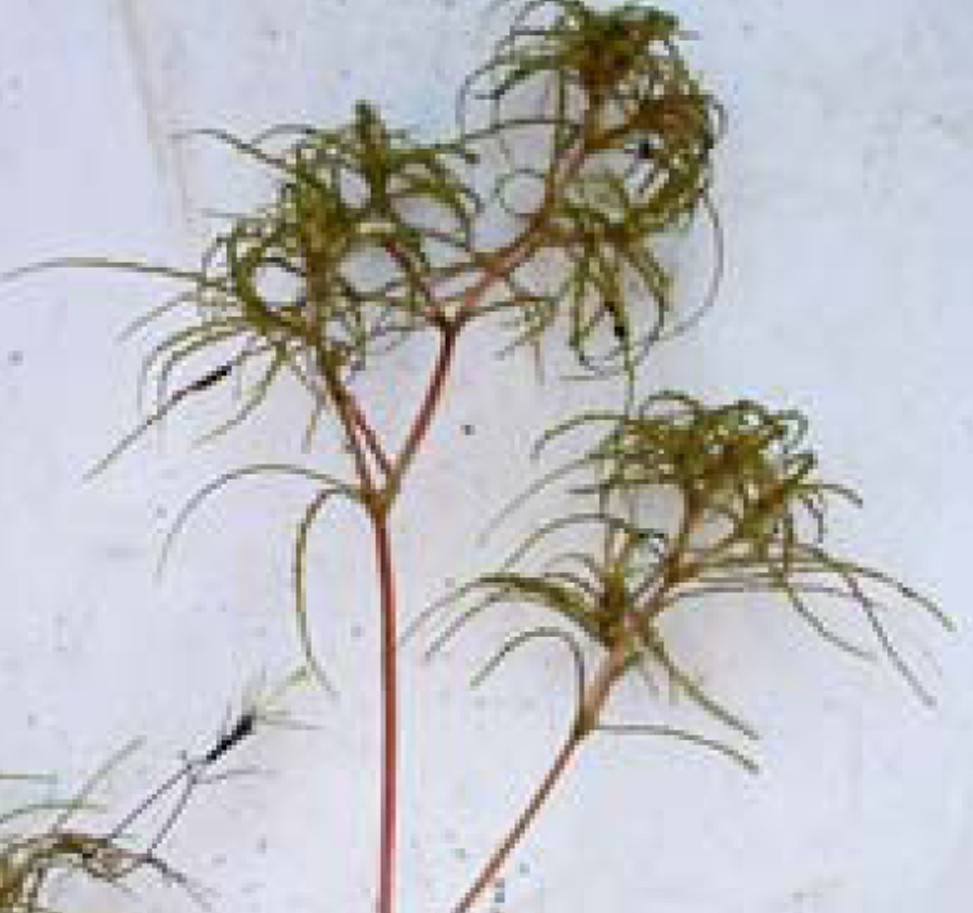 |
| Spiny naiad, also known as European naiad, will be targeted in a treatment set for late June or July. It was detected last year in about 5 of the Pond's 120 acres. |
The Commission's unanimous vote on April 18 also cleared the way for emergency treatments if blue-green algae threaten the Pond as the water warms, and okayed the start of hydro-raking on April 24.
The target of this year's invasive weed treatment is spiny naiad, an annual which repopulates by dropping millions of seeds and can drive out native plants. It was first found in the Pond in 2009, all but disappearing after a 2010 treatment of about 3 acres. Last year, it was detected in about 5 acres, most of it in the Channel.
In accordance with a treatment protocol prepared by the Corporation's consultant, Solitude Lake Management, this year's treatment of spiny naiad is likely to occur in late June or July, after the plants have emerged but before they drop seeds. The Pond will be closed for recreational uses the day of treatment, and adjacent shoreline owners will be advised not to use Pond water for irrigation for five days.
Vegetation Survey Finds Pond Almost Fanwort-Free, But Recommends Treating Another Invasive
February, 2017
A comprehensive survey of vegetation in Foster's Pond late last summer turned up almost no fanwort but detected stands of another unwanted invasive weed, spiny naiad. 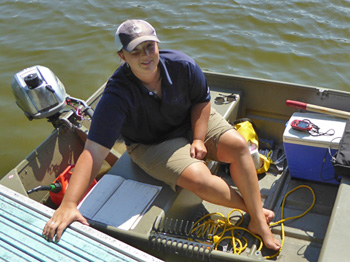
August 26, 2016: Bregieta Arvidson, an aquatic biologist at Solitude Lake Management, after completing the latest vegetation survey of Foster's Pond. Guided by a hand-held GPS locator (the red device resting on the cooler used to hold water samples), she raked up and examined plants growing at 50 data points used in the Corporation's previous surveys.
Data from the most recent survey are set out in a 29-page report submitted to the Corporation on February 10. The survey was conducted by the Corporation's long-time consultant, Solitude Lake Management.
The survey turned up just a few fanwort sprigs here and there, not enough to warrant treatment. However, some of the spiny naiad stands were quite dense, and the Solitude report recommends that the Corporation consider treating the infestations.
Two small areas, amounting to 3.5 of the Pond's 120 acres, were treated for spiny naiad in 2010. Since then, small infestations were detected in several spots during a 2014 vegetation survey, but none was found in 2015. Prior to the 2015 survey, the entire Pond had been treated with Sonar, primarily to control fanwort, but Sonar also reduces spiny naiad and apparently wiped out much of the spiny naiad that had been found the year before.
The Corporation's weed surveys, conducted almost every year since our integrated lake management program began in 2004, sample the same 50 data points, georeferenced in a handheld GPS unit.
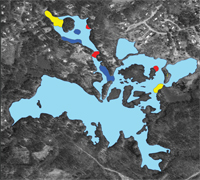 |
| Locations of spiny naiad and fanwort detected in the August survey. Only the spiny naiad was dense enough to warrant possible treatment. Click the map to see a larger image with legend. |
The nearly complete absence of fanwort - once the dominant plant in Foster's Pond - marks the continued success of the Corporation's weed treatment program. Left unchecked, as it was until our first herbicidal treatment in 2005, fanwort forms dense mats that can choke a lake to death. Before the 2005 treatment, fanwort covered nearly 55% of the Pond; last year, according to the new report, fanwort cover was an estimated 0.2%, in line with observations in the three to four years following a treatment. The entire Pond has been treated for fanwort twice since 2005 - in 2011 and 2015 - with a "spot treatment" of 18 acres in 2007.
Other highlights of the report include the following findings:
- Our two 2016 copper sulfate treatments successfully kept blue-green algae counts below thresholds at which health concerns arise;
- Fecal coliform counts continued to be low throughout the Pond (including Dug Pond), and were essentially undetectable anywhere other than the Mill Reservoir, where they are very low;
- Filamentous algae (harmless but a nuisance) was the dominant plant in many parts of the Pond, possibly due to the ongoing drought; and
- Phosphorous (essential for algae growth) was found at a higher-than-desirable level in the Main Pond but within desirable thresholds at other locations.
Based on its findings, Solitude recommended that the Corporation consider options for lowering phosphorous concentrations to limit algae growth. Solitude is expected to submit a proposal for alternative approaches to phosphorus reduction shortly.
Pond Gets Season's Second Algae Treatment
September, 2016
Foster's Pond was treated for blue-green algae for the second time in six weeks, as record-breaking heat and drought triggered unhealthful and unsightly blooms of the microscopic plants.
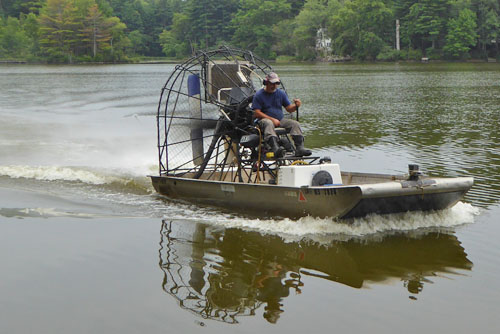
September 1: Dominic Meringolo, senior environmental engineer at Solitude Lake Management, maneuvers the company's 16-foot airboat around the Main Pond, infusing the water with copper sulfate solution to treat blue-green algae.
The September 1 application of copper sulfate extended from the dam through the Channel to the Main Pond, and also included the Mill Reservoir.
Residents and visitors are cautioned even after the algae treatment to look out for thin, blue-green scum floating on the surface, especially where the wind may have blown accumulations to the shoreline. Avoid swimming or letting your pet drink where blue-green surface scum is visible.
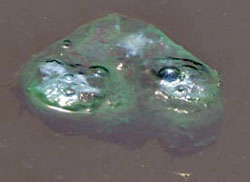 |
| August 31: Small mats of blue-green algae floated to the surface of the Mill Reservoir as record-breaking drought and heat produced ideal conditions for incubating algae. |
 |
| August 31: A sample from one of the Mill Reservoir globs, photographed here through a microscope, showed a mixture of Anabaena (the straight shafts) and Arthrospira (the greenish corkscrews). |
Preliminary analyses of water samples had focused on a soupy green bloom in the Main Pond, but additional samples showed escalating concentrations in other parts of the Pond, as well. Only Dug Pond, fed by its own springs and separated from the rest of Foster's Pond by a narrow berm, seemed to have escaped an outbreak. Dug Pond was not treated.
After the season's first treatment, on July 21, the Pond was visibly clearer. But as the drought dragged on, the Main Pond turned several shades of green, and then the condition of the Mill Reservoir deteriorated noticeably. Just prior to the treatment, the Mill Reservoir began producing small, shiny blue-green globs floating on the surface. Microscopic examination revealed a mix of two blue-green algae species - Anabaena and Arthrospira.
Blue-green algae produce toxins that can cause gastrointestinal problems in children and be fatal to dogs. In recent years, water bodies throughout New England, and elsewhere in the country, have reported increasing incidence of blue-green algae blooms.
Foster's Pond was treated for blue-green algae in 2013 and in 2015. Cooler weather in 2014 kept the algae in check, and no treatment was necessary. This year was the first time that the Pond was treated twice in a single summer. The unprecedented string of sunny days and hot weather combined to turn the Pond into a Petri dish for the cultivation of algae.
Copper sulfate is a widely-used algaecide, employed by the Town of Andover in Haggetts Pond (the Town's drinking water reservoir) and in Pomps Pond (where the Town has its public bathing beach).
Chemical treatments of the Pond are carried out in conformity with an Order of Conditions approved by the the Andover Conservation Commission. The Corporation's long-time lake management consultant, Solitude Lake Management, is licensed to apply the herbicides.
New Blue-Green Algae Bloom Triggers Caution for Main Pond
August, 2016
A preliminary laboratory examination of a sample drawn from the Main Pond on August 23 indicated a sufficiently high concentration of blue-green algae to prompt the Corporation's lake management consultant to advise that swimmers be especially careful not to swallow water and that pet owners should keep dogs out of the Main Pond altogether.
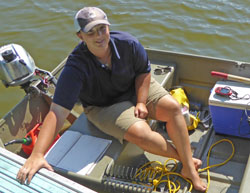 |
| August 26: Biologist Brea Arvidson with some of the tools of her trade, including a throw-rake and a GPS unit, after finishing a vegetation survey of Foster's Pond. |
The caution came from Solitude Lake Management aquatic biologist Brea Arvidson, who examined the sample on August 25 and spent four hours August 26 conducting a vegetation survey of the entire Pond.
The caution does not apply to Dug Pond or other areas of Foster's Pond, including the Mill Reservoir, the Channel, and the Outlet Cove, all of which have remained relatively clear since the July 21 algae treatment of the Pond.
That treatment appears to have virtually eliminated anabaena, a blue-green algae that can produce toxins capable of causing gastrointestinal problems in children, who are more sensitive to the toxins than adults and more likely to swallow water while splashing around. Dogs are even more susceptible, and may die from drinking affected water or licking their fur after a swim.

August 26: Due to Microcystis in the Main Pond, swimmers were advised to be especially cautious not to swallow water, and pet owners were cautioned to keep dogs out altogether. Other portions of the Pond, including the Mill Reservoir, the Channel, the Outlet Cove, and Dug Pond, appeared to be clear of toxic algae.
But while the anabaena disappeared after July's copper sulfate treatment, a different specie of blue-green algae, Microcystis, has emerged in the Main Pond, and that strain produces toxins, too. It was the discovery of Microsystis in the sample, together with the biologist's first-hand examination of the entire Pond, which triggered the cautionary advice.
Meanwhile, water samples have been sent out to a laboratory which will conduct a formal count of the algae concentration, a more elaborate process that will determine whether the Pond requires another copper sulfate treatment.
This year's record drought means that there is no water flowing through or out of the Pond to flush away algae, and the summer's high temperatures and abundant sunlight are just what algae need to bloom.
In addition to evaluating the algae situation, Arvidson completed a comprehensive survey of vegetation in the Pond. raking up and examining the plants growing at more than 50 data points throughout the water body. The survey, the 9th conducted by the FPC since our lake management program began in 2004, will be used to determine whether the Pond requires treatment for invasive plants next year. The last survey was conducted in 2015.
The survey report from Solitude is due to be submitted later this year.
Pond Treated for Blue-Green Algae
July, 2016
Foster's Pond was treated for blue-green algae on Thursday, July 21. The Pond was closed for the day for all recreational uses. The copper sulfate treatment was aimed at forestalling a bloom of the toxic algae, which can cause gastrointestinal problems in children and be fatal to pets. Hot weather can trigger an algae bloom, and observations of water clarity leading up to the treatment indicated a growing likelihood of a hazardous outbreak. Technicians from the Corporation's lake management consultant treated the Main Pond, the Channel, and the Outlet Cove (the area between the Channel and the Dam), but clarity readings taken before they began the operation indicated that no treatment was needed in Dug Pond and the Mill Reservoir.

July 21: As in 2015, copper sulfate was used to treat algae in the Main Pond, the Channel, and the Outlet Cove. No treatment was needed in Dug Pond, the Mill Reservoir, and the cove between Dug Pond and the Mill Reservoir at the foot of Azalea Drive.
The decision to treat parts of the Pond was based on water clarity readings, since laboratory analyses of water samples drawn the previous week had not yet been completed. The results later confirmed the presence of blue-green algae. The blue-green algae count in the Main Pond, in a sample taken on July 13, was 3,200 cells per milliliter. In a second sample, taken just before the July 21 treatment, the count had nearly doubled, to 5,200 cells/ml. While that count was well below the threshold of 70,000 cells/ml at which health authorities advise against having contact with the water, a looming heat wave would likely have produced an explosion in the concentrations. Even at lower counts, guidelines published by the Massachusetts Department of Public Health suggest that some individuals who spend over an hour in water containing more than 5,000 blue-green algae cells/ml may experience mild symptoms.
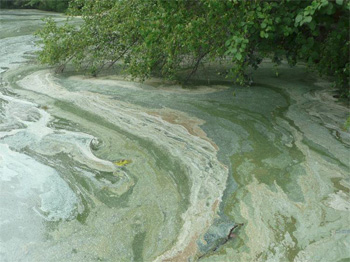 |
| August 14, 2011: An uncontrolled algae bloom in the Main Pond, before the Corporation added algae treatment to our lake management program. |
The treatment should keep algae within safe levels throughout the Pond, but as warm weather continues, residents and visitors are cautioned to keep an eye out for blue-green surface scum, particularly in shallow areas where currents and wind can drive algae towards the shoreline. Avoid contact with (and keep kids and pets away from) water which exhibits a blue-green paint-like scum.
The treatment was conducted in accordance with a regimen approved by the Andover Conservation Commission earlier this year and employed in algae treatments of the Pond in 2013 and 2015.
Cons Com OKs 2016 Algae Plan
April, 2016
The Andover Conservation Commission unanimously approved the Foster's Pond Corporation's contingency plan to treat for blue-green algae in 2016.
The plan calls for monitoring algae concentrations as the weather warms, and bringing in the Corporation's lake management consultant to administer copper sulfate if a dangerous bloom appears imminent.
The Pond has been plagued in recent years by blue-green algae, which can cause gastrointestinal distress in children and be fatal to pets. Other water bodies in the area have also experienced blooms, causing a number of Massachusetts lakes - including Foster's Pond in 2012 - to be temporarily closed to recreation during periods of high concentration.
The Corporation successfully treated the Pond for algae in 2013 and 2015. A blast of cool weather in 2014 suppressed algae growth, obviating the need for treatment.
The plan for 2016, which the Conservation Commission approved at its April 5 meeting, follows the same protocol as the two previous treatments. The protocol for algae treatment in Foster's Pond was first approved by the Conservation Commission in 2013.
Commission Renews Our Pond Management Program
November, 2015
The Andover Conservation Commission has extended the program under which the Foster's Pond Corporation manages the Pond and maintains the 160-year-old Foster's Pond Dam.
The Commission took the action at its November 17 meeting, voting unanimously to approve the three-year extension. The FPC's program operates under an Order of Conditions which was scheduled to expire on January 4, 2016. The Order will now expire January 4, 2019, the maximum extension allowed by law.
The Order of Conditions authorizes hydro-raking and herbicidal treatments for invasive weeds and algae. It also allows winter drawdowns and maintenance work on the dam. The Order designates the FPC as responsible for implementing the lake management program, which includes efforts to educate residents and visitors on best practices for protecting the Pond.
The original order dates to 1992. It has been revised and extended from time to time to embrace a broader arsenal of methods to safeguard the Pond's ecology.
Prior to the vote, the FPC submitted to the Commission a report on 2015 treatment efforts. The 25-page report was prepared by the FPC's lake management consultant, Aquatic Control Technology.
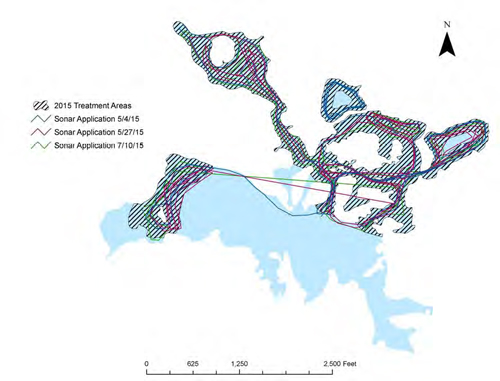
The 2015 treatment to combat fanwort focussed on areas where the invasive weed had been detected in a 2014 vegetation survey. Using a calibrated applicator linked to a GPS tracker, technicians infused a slow-acting herbicide in three stages. No fanwort was detected in the post-treatment survey.
The report includes a comprehensive vegetation survey, the 8th conducted by the FPC since the program began in 2004. The survey, which uses a consistent set of GPS 50 data points around the Pond, found no fanwort after the 2015 treatment. The Pond's last fanwort treatment was administered in 2011, and the persistent weed, which is almost impossible to eradicate entirely, had started to make a comeback. ACT's 2014 vegetation survey had estimated fanwort cover at about 11 per cent of the Pond's open water - well below the 50 per cent cover before treatments began a decade ago, but high enough to warrant a Pond-wide herbicide application.
The report also found that blue-green algae concentrations had gotten close to unhealthful levels in late July, but plunged in the wake of an algaecide treatment on July 31.
Overall, the report found water quality in the Pond to be within acceptable parameters.
The report echoed prior observations about the need for continual management:
Given the trophic state of Foster's Pond and the presence of invasive, non-native aquatic vegetation, specifically fanwort, it is likely that Foster's Pond will continue to suffer from problematic aquatic weed growth in the future. Well-timed management efforts to date have successfully helped curb fanwort spread while maintaining a diverse native plant assemblage Future management work will be required to maintain gains from earlier management efforts. We recommend that the Foster's Pond Corporation continue monitoring vegetation in the lake annually to assess fanwort re-growth and watch for other unwanted plant introductions.
Although some of the Pond's oldest residents have fond recollections of childhood swims in gin-clear waters, contemporaneous records of neighborhood meetings reflect complaints about weeds in the Pond going back to 1935. Weed growth in the Pond was an inevitable result of the pre-Civil War construction of the Foster's Pond Dam, which flooded nutrient-rich wetlands as it enlarged the Pond from 50 acres to 125. Most of the newer acreage is quite shallow, allowing all manner of weeds to flourish, including non-native invasives that were introduced later.
Treatment Targets Blue-Green Algae
July, 2015
About half the Pond was treated with copper sulfate July 31 to control blue-green algae (cyanobacteria), which in high concentrations can cause gastric distress in children, and can be fatal to pets.
The treatment, carried out under a lake management program approved by the Andover Conservation Commission, came a day after laboratory examination of water samples from the Main Pond confirmed the presence of Anabaena, a genus of cyanobacteria that produces neurotoxins.
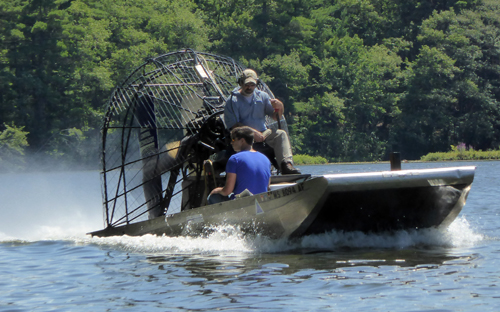
July 31: Dominic Meringolo, Aquatic Control Technology's senior environmental engineer, steers the company's 16-foot airboat around the Main Pond, as an assistant watches over the equipment infusing the water with copper sulfate solution.
Precise counts of the algae concentration could not be obtained on short notice, but warm weather had brought on a sudden algae bloom, resulting in a sharp drop in water clarity throughout the Main Pond. With more heat in the forecasts, experts recommended treating the Pond without waiting for the inevitable explosive growth in algae populations.
Residents and visitors are cautioned even after the algae treatment to look out for thin, blue-green scum floating on the surface, especially where the wind may have blown accumulations to the shoreline. Avoid swimming or letting your pet drink where blue-green surface scum is visible.
Some areas of the Pond did not require treatment. A water sample from Dug Pond revealed no harmful algae. And water clarity observations in the Mill Reservoir and in the cove at the end of Azalea Drive, just prior to the treatment, indicated the presence of very little algae. No copper sulfate was applied in these areas.

July 31: Copper sulfate was used to treat algae in the Main Pond, the Channel, and the Outlet Cove. No treatment was needed in Dug Pond, the Mill Reservoir, and the cove between Dug Pond and the Mill Reservoir at the foot of Azalea Drive.
Technicians from the Corporation's lake management consultant, Aquatic Control Technology, took about two hours to treat the targeted areas - the Main Pond, the Channel, and the Outlet Cove, roaring repeatedly back and forth from the Main Pond to the dam in a 16-foot airboat.
The Pond has been treated for blue-green algae only once previously, in 2013. In 2012, Foster's Pond joined a growing list of water bodies in the region found to contain blue-green algae, and the Pond was closed to swimming because of health concerns. The 2013 treatment successfully knocked down an algae bloom, keeping the Pond open. In 2014, Mother Nature took a hand in controlling the algae, send cool weather just in time to keep a bloom below the limits set by health experts.
Fanwort Hit With Third - And Likely Last - Treatment
July, 2015
The final act of this year's weed-control program played out under sunny skies, as technicians circled the Pond applying a combination of pelletized and liquid herbicide.

Fanwort at the entrance to the Mill Reservoir showing signs of "chlorosis," the bleaching effect of Sonar that eventually kills the plant. Lilies in the Pond are also being cut back by the treatment, but the lilies will start to rebound next year. This photo was taken June 26.
It was the third treatment of the Summer, and experts from the Corporation's lake management consultant, Aquatic Control Technology, reported at the end of the three-hour effort that it was unlikely that any further booster applications would be needed.
The targeted weed, fanwort, has already been sharply reduced following treatments on May 4 and May 27. As of July 10, when the third treatment was administered, the remaining plants were pale and sickly. Between 95 and 99 per cent of the non-native invasive - which was once the dominant plant in the Pond and is almost impossible to eradicate entirely - will be eliminated by this year's treatment. The last treatment of the entire Pond held fanwort well below nuisance levels for four years.
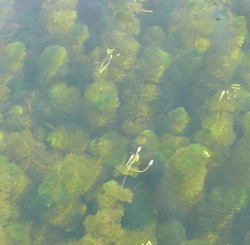 |
| Dense stand of fanwort - as it would appear this time of year in the absence of treatment. |
The treatment utilizes fluridone, sold under the brand name Sonar. At the concentrations used in Foster's Pond, it is allowed by State and Federal regulators in public drinking water reservoirs. The key to its success is maintaining low concentrations in the water over an extended time period. It has a relatively short half-life, which is why it must be reapplied at intervals.
Fanwort is particularly susceptible to Sonar, while native plants are able to survive. Fanwort, left unchecked, pushes out native species that provide better habitat for fish and wildlife. Fanwort can form thick mats which clog, and can eventually kill, a lake.
Pond Gets Booster Treatment as Fanwort Fades
May, 2015
For the second time this Spring, a 16-foot airboat roared around the Pond applying a slow-acting herbicide to combat invasive weeds.
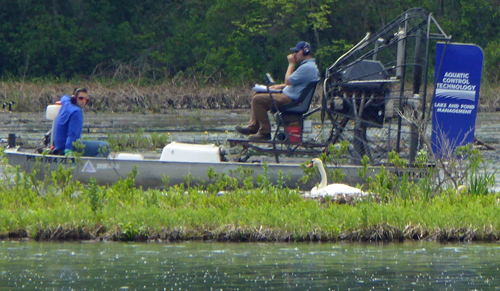
May 27: A nesting swan in the Main Pond keeps an eye on the airboat applying Sonar as part of the Corporation's invasive weed control program.
Before starting the treatment May 27, technicians from the Corporation's long-time lake management consultant, Aquatic Control Technology, took FPC President Steve Cotton on an inspection tour to examine effects of the first herbicide infusion earlier in the month.
It was evident that the fluridone (sold under the brand name Sonar) was already beginning to work.
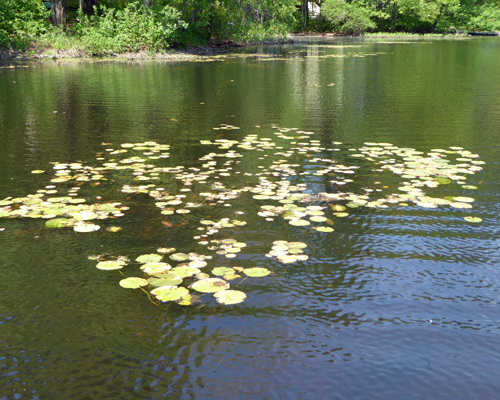
May 27: Lilies in the Channel showing signs of chlorosis even before the "booster" treatment. Lilies will survive the treatment regimen, but will be thinned in many parts of the Pond.
The targeted nuisance weed - fanwort - was poking through the bottom sediment in numerous locations, but the emerging plants showed signs of "chlorosis," the fading effect that Sonar causes, eventually killing susceptible plants. Lily pads were also looking washed-out, and while past experience shows that plenty of lilies will survive the treatment, few boaters will mourn a reduction in the many dense lily colonies in the Pond's shallow coves.
This year's weed treatment is being conducted in accordance with a plan approved by the Andover Conservation Commission. The entire Pond was last treated for fanwort in 2011.
Follow-Up Treatment Set for May 27
May, 2015
With a Pond-wide herbicidal treatment earlier this month beginning to show effects on invasive weeds, a follow-up "booster" dose will be applied on May 27.
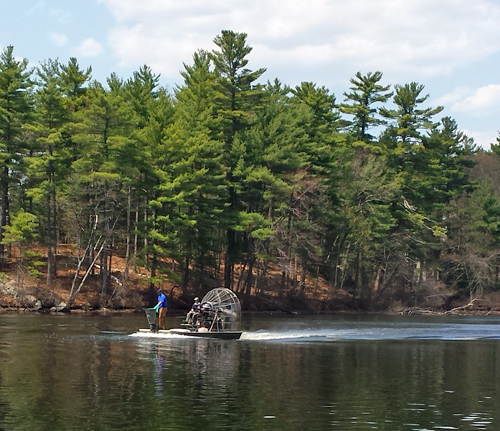
May 4: Airboat in the Channel applying herbicide-infused clay pellets to combat invasive weeds. The broadcast mechanism in the bow of the boat is controlled through a GPS system calibrated to achieve the target concentration of the slow-acting chemical. (Photo by Dave Brown)
As with the first treatment, the Pond will be closed for swimming, fishing and boating for the day. Shoreline owners are advised not to use water from the Pond to irrigate for 30 days following each application. Since there are likely to be additional treatments, a month or less apart, the no-irrigation advisory will be in effect through most of the Summer. These cautions will apply throughout Foster's Pond, including Dug Pond.
The initial treatment on May 4 took about three hours. Using a 16-foot airboat - a craft more familiar in the Florida Everglades than on a New England lake - technicians circled the entire Pond spreading clay pellets infused with fluridone. Sold under the brand name Sonar, fluridone is the only state-approved aquatic herbicide which can effectively control widespread infestations of fanwort, the most pernicious invasive weed in Foster's Pond.
The herbicide acts by preventing the plant's production of yellow pigments which protect chlorophyll from breaking down under sunlight. Without their yellow pigments, plants bleach out and die. The process (called "chlorosis") is slow, taking upwards of 6 to 8 weeks. The slowness is considered an advantage by ecologists, since a rapid die-off of plants could deplete oxygen in the water (causing a fish kill) or a sudden nutrient release (causing an algae bloom).
Very low concentrations of Sonar are effective in killing fanwort. The target concentration for Sonar in the Pond, during the treatment period, is between 6 and 12 parts per billion. State and Federal regulators allow Sonar treatment of public drinking water reservoirs at concentrations up to 20 ppb. While no shoreline homes draw their drinking water from Foster's Pond, the low target concentrations reflect the Corporation's concern for public safety.
Sonar degrades rather quickly in sunlight, with a half-life of about 20 days. That is why repeated "booster" treatments are needed to maintain an effective concentration for 60 to 90 days.
The Corporation posts the Pond as closed to fishing, swimming, and boating on the day of treatment. The principal concern is not that the treated water is particularly harmful, but that the airboat operators have enough on their plate without encountering kids, pets, or small craft in the Pond's hidden coves.
Treatment Slated to Start May 4
April, 2015
The first whole-lake weed treatment of Foster's Pond since 2011 is scheduled to start on May 4.
The Pond will be closed for swimming, fishing and boating for the day. Shoreline owners are advised not to use water from the Pond to irrigate plants once treatment starts and for 30 days following the final application. Since there are likely to be multiple "booster treatments" a month or so apart, the no-irrigation advisory will be in effect through most of the Summer. These cautions will apply throughout Foster's Pond, including Dug Pond.
The treatment date could change, depending on weather conditions and the extent of weed growth observed later this month.
The weed treatment will follow plans approved earlier this year by the Andover Conservation Commission.
Conservation Commission Authorizes Fanwort and Algae Treatment Plans
March, 2015
The Andover Conservation Commission has approved plans to treat Foster's Pond for invasive weeds this Spring. The Commission also authorized the FPC to administer a treatment for blue-green algae, if densities later in the Summer approach levels which health authorities consider unsafe.
The Commission's unanimous vote came at a meeting on March 3. The treatment plans were outlined in a January report prepared by the Corporation's long-time lake management consultant, Aquatic Control Technology.
The target of the weed treatment is fanwort, a persistent and easily-spread invader that can crowd out native plant species, forming dense mats so dense that they can suffocate a lake. Before the Foster's Pond Corporation initiated a lake management program in 2005, fanwort had become the dominant plant in Foster's Pond.
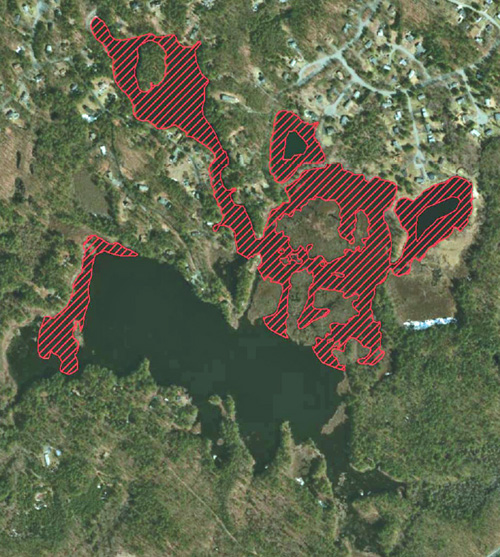
August, 2014: Distribution map from ACT's January, 2015, report to the Corporation shows the areas of sparse to dense fanwort growth last Summer.
The plan approved by the Conservation Commission will use the same chemical control - fluridone, sold under the brand name Sonar - which was administered in 2005 and 2011, the two prior occasions when the entire Pond was treated for fanwort. Sonar is a slow-acting herbicide that prevents green plants from producing yellow pigments which keep chlorophyll from breaking down under sunlight. Without the yellow pigments, the plants slowly bleach out and die. The process (called "chlorosis") can take upwards of 6 to 8 weeks. The slow pace of the die-off is an advantage, lessening the prospect of sudden oxygen depletion (which could result in fish kills) or nutrient release (which could trigger algae blooms).
The Sonar will be applied through a combination of liquid formulations delivered from subsurface hoses and time-release clay pellets placed in areas of dense fanwort growth. A series of three or four applications, space three to four weeks apart, will start in mid to late April, when fanwort emerges. The Pond will be closed for swimming, fishing and boating the day a treatment is applied. Shoreline owners are advised not to use water from the Pond to irrigate plants once treatment starts and for 30 days following the final application. These cautions will apply throughout Foster's Pond, including Dug Pond, where fanwort was also observed during ACT's survey last summer.
Sonar is approved for use in public drinking water reservoirs, and can be applied close to potable water intakes pipes. The treatment protocol for Foster's Pond calls for extremely low concentrations, under the 20 parts per billion allowed in public drinking water. Computer-controlled equipment, mounted on an ACT boat, is used to disperse the Sonar. The equipment is linked to a GPS system that calibrates the flow to take account of the speed and location of the boat.
The decision on whether to treat Foster's Pond for blue-green algae will depend on observations made by volunteers as the weather warms. Last year, volunteers kept a close watch on water clarity, sending water samples for laboratory analysis when murky water indicated that algae might be approaching unhealthful densities.
But cool weather kept the algae in check, and the Corporation did not to treat the Pond with copper sulfate in 2014 as concentrations stayed just below the thresholds that can cause gastrointestinal distress in kids and prove fatal for pets.
Plant Survey Finds Dense Fanwort
January, 2015
A systematic survey of plants growing in Foster's Pond has confirmed that, in the four years since the entire water body was last treated for invasive weeds, the most persistent non-native species has rebounded to the point where another treatment will be needed to keep it in check.
A report submitted to the Corporation in January recommends starting the treatment in April, using the same low-concentration herbicide that was last employed in 2011. The 21-page report was prepared by the Corporation's lake management consultant, Aquatic Control Technology, and was based on a vegetation survey conducted in August.
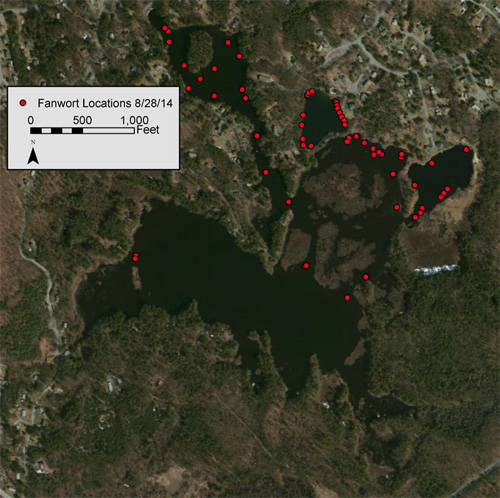
August, 2014: Fanwort was found in multiple locations last summer, covering about 10 per cent of the Pond. That's one-fifth of the area fanwort covered a decade ago, when the Corporation conducted its first survey and launched a lake management program. Periodic weed treatments have kept the invasive weed in check.
The problem, and the solution, are all familiar territory for Pond residents and long-time visitors, and there is no surprise in the call for a weed treatment every few years.
The unwelcome invader is fanwort, a common aquarium plant that is native to the Southern states but can flourish in Northern ponds. It was probably introduced into Foster's Pond decades ago by someone setting a pet goldfish free. By 2004, when the Foster's Pond Corporation launched its lake management program with its first aquatic vegetation survey, fanwort was the dominant plant in the Pond, covering more than half of the open water.
Fanwort can become so dense that it chokes out native species, and decaying mats of the stuff can suck the oxygen from a water body and trigger fish kills. Fanwort can be controlled, but it is almost impossible to eradicate.
 |
| A dense stand of fanwort |
The only practical solution allowed in Massachusetts is periodic treatment with fluridone, an aquatic herbicide sold under the trade name Sonar. It is applied - through time-release pellets or in liquid form - at extremely low concentrations of less than 20 parts per billion. Sonar is considered so safe that it is allowed in public drinking water reservoirs.
Sonar is also used to control spiny naiad, a second invasive weed that was detected during the August vegetation survey.
All 125 acres of Foster's Pond were treated with Sonar for the first time in 2005 and then again in 2011. In between, Dug Pond was given its own treatment in 2006, and parts of Foster's Pond got a "spot treatment" in 2007. The recommendation for a 2015 treatment extends to both Foster's Pond and Dug Pond.
Any weed treatment must conform to strict protocols contained in an Order of Conditions that the Andover Conservation Commission has issued to govern the Corporation's lake management program.
Algae Stay Down, but Fanwort's Up
August, 2014
With cool nights continuing to keep algae in check, it is becoming less and less likely that the Corporation will need treat Foster's Pond this Summer.
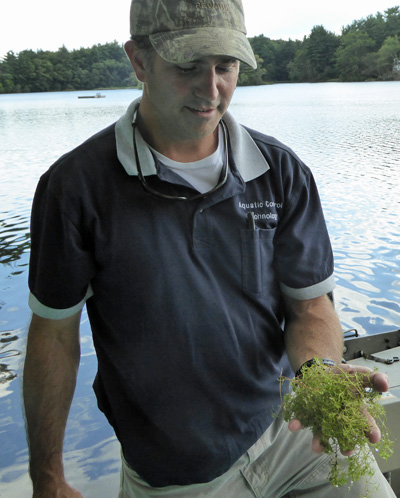 |
| August 28: Biologist Marc Bellaud displays a handful of spiny naiad growing in the Main Pond. |
But there's not much doubt that the Pond will require a treatment regimen next year to tame two familiar invasives which have begun to clog the Channel and other locations.
Those are the preliminary conclusions of the FPC's lake management consultant following a systematic survey of the Pond's vegetation on August 28.
Aquatic Control Technology president Marc Bellaud spent nearly three hours crisscrossing the Pond to inspect vegetation at the 50 data points he has used since the FPC's lake management program began in 2004. The survey points are logged in a portable GPS unit to ensure comparability of the information collected in the assessments. The surveys include Dug Pond.
This month's survey was the seventh in the last 11 years. The surveys, which have usually been conducted in August, entail raking vegetation samples from the Pond bottom at each data point and visually determining which species are present. In addition, an underwater camera is used to estimate densities of the plant varieties. Bellaud also employed a Secchi disk for water clarity readings, as FPC volunteers have been doing throughout the summer. And he collected samples for laboratory analysis of water quality.
All the information will be presented to the FPC later this year in a written report, which will also outline treatment recommendations for next year.
In a debriefing after he had completed this year's survey, Bellaud indicated that he had found dense colonies of fanwort and spiny naiad in the Channel, the Outlet Cove, the passage between the Main Pond and the Mill Reservoir, and at several spots along the shoreline in the Main Pond.

August 28: Treatable densities of fanwort and spiny naiad were found in the Channel, the Outlet Cove, the passage between the Main Pond and the Mill Reservoir, and at several spots along the shore of the Main Pond.
Fanwort has long been the chief enemy of a healthy Foster's Pond, having been the dominant plant species before the Corporation began a management program. Fanwort, a non-native invader that likely was introduced into the Pond by someone emptying an aquarium, is controlled by a low-concentration herbicide with the trade name Sonar. The entire Pond was treated with Sonar in 2005, and again in 2011, with 18 of the Pond's 120 acres given a "spot treatment" in 2007. Left alone, fanwort can multiply to choke a lake, getting to the point where it depletes the oxygen and causes massive fish kills.
The second invader Bellaud found, spiny naiad, was detected in multiple locations in the Channel and the Main Pond. A survey first found spiny naiad in just two locations in 2009, and both locations were treated in 2010. Those colonies appeared to have been wiped out, but others have since sprung up. Spiny naiad can, like fanwort, also be tamed with Sonar, so next year's program will be timed to target both species.
Mother Nature Chills, Keeping Algae Counts Down
August, 2014
To treat or not to treat? That's been the question, as volunteers have kept a close eye on algae in Foster's Pond throughout the summer.
Beginning in June, residents have been out in canoes taking readings of water clarity, an indicator of whether algae are getting dense enough to raise health concerns. Last year in July, blue-green algae - which can cause intestinal problems in kids and be fatal to dogs if they drink too much - soared above the counts which health authorities consider dangerous, and the FPC treated the Pond with copper sulfate to bring the concentration down to safe levels. The Andover Conservation Commission approved a similar plan for this year.
But rainfall and temperatures have been different this year, and Mother Nature has taken over the job of taming the algae.
Local residents John Lugus, Al Barber and FPC Weed Committee Chair David Adilman have been monitoring the algae, with Lugus and Barber taking turns measuring water clarity in various parts of the Pond. The key tool is a Secchi disk, named for the Italian astronomer and meteorologist Angelo Secchi, who invented it in 1865. The modern version (consisting of a black and white disk suspended on a measuring tape) provides a crude but effective way of detecting changes in the transparency of the water that - in Foster's Pond - is closely related to algae growth.
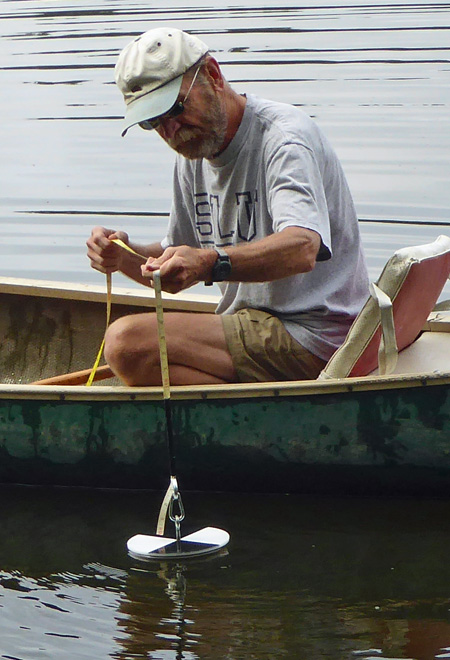 |
| August 22: Pond resident John Lugus prepares to lower the Secchi disk to measure water clarity. |
Readings throughout this summer have remained pretty consistent, never dropping to the pea-soup opacity the Pond experienced in mid-July last year. That's when algae counts - determined by laboratory examination of water samples - exploded, triggering health warnings. Last year, as soon as those counts were reported, the FPC arranged to treat the Pond.
This year, the volunteers took clarity readings nine times in June and July, observing relatively clear conditions compared to last year. To get more precise data, on August 5 the volunteers gathered water samples and sent them out for laboratory examination. The results confirmed the Secchi disk readings: algae counts were well within healthful limits.
The highest counts were found in the Main Pond, where samples taken from two locations on August 5 registered 25,000 cells per ml. and 31,000 cells per ml. - far below the 70,000 cells/ml. considered unhealthful. In the Mill Reservoir, the count was a comfortable 11,000 cells/ml., and Dug Pond had less than 1000 cells/ml. No blue-green algae were detected in a sample from the Channel.
By contrast, last year the Pond produced samples in mid-July topping 85,000 cells/ml., including one from the Channel with 95,000 cells/ml. Those counts prompted last year's treatment.
So what explains the lower counts this year? Most likely, a couple of heavy rains at just the right time, along with some unseasonably cool nights and unusually few 90-degree days, all combining to prevent the algae from getting out of control.
But the FPC will do its best to keep an eye on the situation. A new batch of water samples was dispatched to the lab on August 19, and John Lugus was back out on the Pond on August 22, taking yet another set of Secchi disk readings.
After 2013 Success, Conservation Commission OKs 2014 Algae Plan
February, 2014
The Andover Conservation Commission unanimously approved the FPC's plan to treat Foster's Pond for blue-green algae in 2014, if concentrations rise to levels which public health authorities consider dangerous.
The Commission's unanimous vote came on February 4, following the submission of a report by the FPC's lake management consultant on the results of last year's treatment.
The report, prepared by Aquatic Control Technology, called the 2013 treatment "very effective, providing complete control of the dominant cyanobacteria within four days." ACT treated 60 of the Pond's 120 acres last July with a dilute solution of copper sulfate, the most common algaecide.
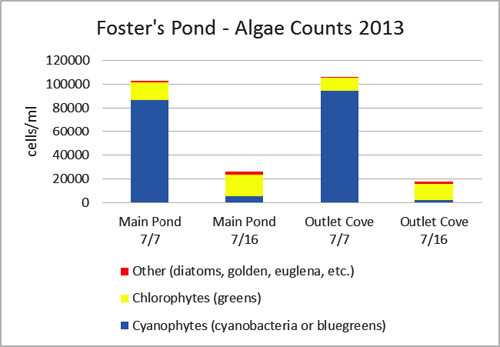
This chart from ACT's report on the 2013 algaecide treatment compares algae counts before and after copper sulfate was applied on July 12, 2013. Blue-green algae (cyanobacteria) can cause gastrointestinal distress in children and can be fatal to some animals, including dogs, at concentrations exceeding 70,000 cells/ml.
Under the approved treatment plan, which is the same as last year's, volunteers will keep track of water clarity as the weather warms. When the water begins to get murky, samples will be collected for laboratory observation, and if a bloom of blue-green algae is detected, the Pond will be treated with copper sulfate.
Blue-Green Algae Count Plummets After Treatment
July, 2013
Unhealthful levels of blue-green algae came to an abrupt end after the Pond received its first-ever algaecide treatment.
Within hours of the July 12 treatment, the Pond began to look less like a bowl of pea soup and more like a cup of tea, displaying the naturally brownish color which is attributable to tannins in the water.
On July 16, FPC president Steve Cotton took a biologist from the Corporation's lake management consultant, Aquatic Control Technology, on a canoe tour, drawing water samples for laboratory examination.
The results, which were reported to the FPC on July 19, showed a dramatic reduction in blue-green algae, which had risen to unhealthful levels just before the treatment. All of the post-treatment counts were far below the threshold for closing public bathing beaches.

July 16: Post-treatment water samples taken from the Main Pond, the Channel, the Outlet Cove and the Mill Reservoir showed low levels of blue-green algae. In earlier sampling, no blue-green algae were found in Dug Pond.
Before the Pond was treated, blue-green algae counts from various locations had ranged between 71,000 and 118,000 cells/ml, triggering health warnings. After the treatment, the highest count was under 9,000 cells/ml, found in a sample taken in the Main Pond near the community raft. Nearer the shore, close to the Tyler dock, the count was under 3,000 cells/ml. A similar count was found in the middle of the Outlet Cove. Fewer than 1500 cells/ml were found in the Channel. In the Mill Reservoir, only 740 cells/ml were detected.
The Massachusetts Department of Public Health and the World Health Organization recommend swimming restrictions when counts exceed 70,000 cells/ml.
Because the Pond has never been treated before for algae, there is no way of knowing how long this first treatment will last. A diluted solution containing 225 pounds of copper sulfate was infused into 60 acres of the Pond. Depending on weather conditions, it is not uncommon for lakes and ponds to be treated for algae more than once a season.
Pond Treated for Blue-Green Algae
July, 2013
A day after laboratory results showed unhealthful levels of blue-green algae in samples taken from Foster's Pond, experts were out on the water administering the Pond's first-ever algaecide treatment.
They began in the Main Pond, slowly guiding their flat-bottomed motorboat in concentric circles while discharging a weak solution of copper sulfate from a pair of hoses rising from the stern. The Channel, the Outlet Cove, and the Old Mill Reservoir were also treated.
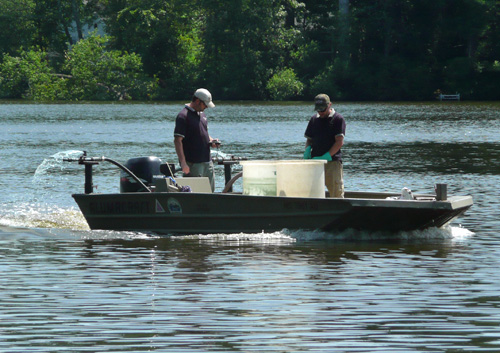
July 12: Biologist Michael Lennon (left) and senior field technician Drew Kelosis, from Aquatic Control Technology, use a computer-calibrated discharge system to administer copper sulfate in the Main Pond. The diluted algaecide is discharging from two hoses in the stern.
The Pond was closed to all recreational uses for the day. As soon as the Foster's Pond Corporation received the lab results on July 11, residents and visitors were advised to stay out of the water, and keep their kids and pets away, until at least 24 hours after the treatment.
Even after the treatment, you should avoid contact with water that has a surface scum. Don't let your pet drink or swim in such water, either. Only half of the surface area of the Pond was treated, and algae may accumulate, particularly close to shore in spots that were not treated.
The Foster's Pond Corporation began laying the groundwork for the quick response to this year's algae bloom a year ago, when the Pond was closed for swimming because of the algae. Blue-green algae can cause gastrointestinal distress, especially in children, and can be fatal to dogs and other animals.
The Corporation, which works closely with the Andover Conservation Commission to manage Foster's Pond, secured an amended Order of Conditions to allow copper sulfate treatments. The FPC and its lake management consultant, Aquatic Control Technology, developed a quick-response plan to treat the Pond this Summer if the algae came back, and the Commission gave its okay to the plan last month.
FPC volunteers have been monitoring the Pond, checking the clarity of the water, and sent samples to ACT for laboratory analysis as the clarity dropped. As soon as the presence of the algae was confirmed, the FPC and ACT moved swiftly to treat the Pond.
Copper sulfate is a widely-used algaecide. Earlier this year, the Town of Andover engaged ACT to use copper sulfate in Haggetts Pond (the Town's drinking water reservoir) twice and in Pomps Pond (where the Town has its public bathing beach).
The Foster's Pond treatment used about 225 pounds of copper sulfate, aimed at attaining a concentration of 0.3 parts per million in the treated areas. Sixty of the Pond's 120 acres were treated. The State requires that only half of a water body be treated at a time, so that the dying algae don't deplete so much oxygen that a fish kill results.
Health Warning: Keep Kids and Pets Out of the Pond
July, 2013
Examination of water samples taken from Foster's Pond has indicated concentrations of blue-green algae well above the levels considered safe for swimming. Blue-green algae can cause gastrointestinal distress in children and can be fatal to dogs and other animals.
You are advised not to swim in the Pond, or to let your pet swim or drink from the Pond, until Saturday afternoon, July 13, at the earliest. This warning does not apply to Dug Pond.
Samples collected from the Pond on July 7 were sent to the Corporation's lake management consultant, Aquatic Control Technology, for analysis. The results, which were reported to the Corporation on July 11, showed high concentrations of blue-green algae in the Main Pond and the Outlet Cove area between the Channel and Rock Island. No blue-green algae were detected in Dug Pond.

July 7: Water samples taken from the Outlet Cove and the Main Pond showed high concentrations of blue-green algae. No algae were detected in a sample from Dug Pond.
The Corporation has scheduled treatment of the Pond on Friday, July 12. The Pond will be closed for fishing and boating - as well as swimming - for the day.
Under state regulations, only half the surface area of the Pond can be treated. That restriction is designed to minimize the potential for depleting oxygen in the water and triggering a fish kill. The shorelines of the Main Pond and the Outlet Cove will be treated. The Mill Reservoir will also be treated, if a visual inspection reveals heavy concentrations of algae. Dug Pond will not be treated.
Following the treatment, the pea-soup green open water is expected to go through some color changes and increase in clarity, as algae die and settle to the bottom. However, don't expect the Pond to turn gin-clear like a mountain stream. The Pond has tannins in the water, giving it a natural color akin to weak tea.
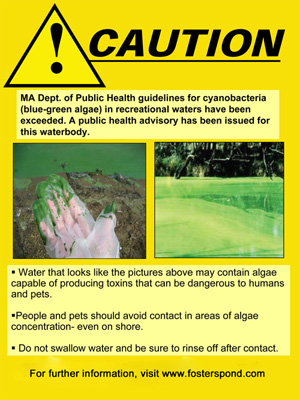 |
| This warning, adapted from a poster issued by the Massachusetts DPH, summarizes the advice to keep in mind for now. |
In all, five water samples were taken and sent to the lab. Two samples from the Main Pond showed blue-green algae counts of 80,000 and 93,000 cells/ml. Two samples from the Outlet Cove contained 71,000 and 118,000 cells/ml. ACT's biologist noted no blue-green algae in a sample taken from the shoreline of Dug Pond. The Massachusetts Department of Public Health and the World Health Organization recommend swimming restrictions when counts exceed 70,000 cells/ml.
The Andover Conservation Commission last month unanimously approved a plan recommended by the Foster's Pond Corporation to treat the Pond for blue-green algae with copper sulfate, setting the stage for a quick response to the elevated algae counts.
Volunteers had been taking readings of water clarity to determine if algae were building up. With the clarity dropping in the face of an early-July heat wave, FPC Weed Committee Chairman David Adilman collected the samples and dispatched them for laboratory examination.
Conservation Commission Approves Algae Treatment Plan
June, 2013
The Andover Conservation Commission unanimously approved a plan recommended by the Foster's Pond Corporation to treat the Pond for blue-green algae this summer. The vote came during a Commission meeting on June 18.
Volunteers have already begun taking readings of water clarity to determine if algae are building up in the Pond. As clarity starts to drop (expected to occur when the water warms), water samples will be sent to the Corporation's lake management consultant, Aquatic Control Technology.
ACT will determine whether the samples contain significant concentrations of blue-green algae. If so, the Corporation will authorize a copper sulfate treatment to kill the algae, which can cause gastrointestinal distress in children and can be fatal to dogs and other animals.
Corporation Maps Plan to Combat Blue-green Algae
June, 2013
The Foster's Pond Corporation has recommended that the Andover Conservation Commission approve a plan to treat the Pond for blue-green algae this summer.
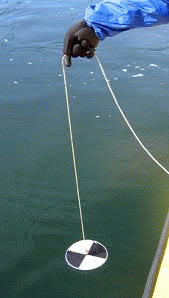 |
| A Secchi disk is one of the tools volunteers will use to determine the timing of an algae treatment. |
The treatment plan, developed by the Corporation's lake management consultant Aquatic Control Technology, depends on local volunteers to monitor water quality as the summer progresses. If significant densities of blue-green algae are detected, ACT will apply copper sulfate, a widely used algaecide that is commonly employed in drinking water reservoirs, including Lake Cochichewick in North Andover.
The idea is to kill the algae before there's a massive bloom. Once the algae get too dense, treatment can result in a sudden drop in the Pond's oxygen levels, causing fish to die.
The Corporation is authorized to use copper sulfate under an amended Order of Conditions approved by the Conservation Commission last year, but that order requires that the Commission approve a specific plan for each year's proposed treatment. The Commission is expected to consider the 2013 plan at its June 18 meeting.
This would be the first time Foster's Pond has ever been treated for algae. While the Pond has for decades experienced algae, some varieties turning the Main Pond, in particular, a pea-soup green and others forming filamentous mats which float on the surface, outbreaks of blue-green algae are something new.
A massive bloom in 2011 in the Main Pond appeared to last only a few days, but in 2012, testing revealed concentrations that in some cases exceeded health guidelines for swimming, and the Pond was closed for much of the summer. Blue-green algae can cause gastrointestinal distress in children, and can be fatal to dogs and other animals.
Foster's Pond was not alone in experiencing unprecedented outbreaks of blue-green algae. According to news reports, ponds in North Andover, Newton, Barnstable, Eastham, Mashpee, Brewster, Winchester, Woburn and Halifax were also forced to close.
Conservation Commission Expands Order to Include Algae Control
December, 2012
The Andover Conservation Commission has extended and expanded the lake management program for Foster's Pond.
The Commission on December 13 adopted an amended Order of Conditions under which the Foster's Pond Corporation conducts weed treatments, maintains the Foster's Pond Dam, and performs annual winter drawdowns. The amended Order will also allow the Corporation, for the first time, to treat the Pond with copper sulfate in the event of another outbreak of blue-green algae.
 |
| August 14, 2011: An algae bloom in the Main Pond. |
The Order of Conditions is the Commission's comprehensive directive for managing Foster's Pond. First put in place in 1992 to allow hydro-raking, the Order was expanded into a full-blown lake management program in 2005, allowing herbicidal treatments to control non-native invasive weeds. The Order was again extended in 2009 for three years, the maximum allowed by State regulations.
The latest extension, which was approved by a unanimous vote, will keep the program in place through 2015.
The Order designates the Foster's Pond Corporation to be responsible for implementing the lake management program, which includes educating residents and visitors on watershed management practices.
The Pond was closed to swimming last year after tests revealed unhealthy concentrations of blue-green algae, which can sicken people and kill dogs and other pets which drink too much of it.
Copper sulfate is the most common algaecide, as well as the least expensive. It is widely used in ponds and drinking water reservoirs.
Although using copper sulfate is now authorized under the Order of Conditions, individual residents are not authorized to use it. Under the Order, the Foster's Pond Corporation must present a specific plan of use to the Conservation Commission. The algaecide can only be put in the Pond by a licensed applicator, and a State permit is required for each use.
The Corporation's Board of Directors has not decided whether to treat the Pond for algae, but sought approval from the Conservation Commission in order to have the option available if needed.
Consultant Recommends Treatments for Algae
November, 2012
The Corporation's long-time lake management consultant has recommended consideration of a couple of possible responses to the blue-green algae bloom which shut down the Pond for swimming in 2012.
Both alternatives involve treating the Pond with copper sulfate, the most widely used algaecide. One would also make use of a treatment which reduces phosphorus in the water. Tests indicated that Foster's Pond has phosphorus levels that exceed the concentration needed by algae to thrive.
The recommendations were included in a 15-page report submitted to the Corporation by Aquatic Control Technology on November 7. The report was based on a survey of aquatic vegetation and water quality samples taken on August 23.
Overall, the report contained good news about the health of the Pond ecosystem. The survey found fanwort - an invasive weed which once dominated the Pond and had been targeted in whole-lake treatments in 2005 and 2011 - in only two spots. A small stand of fanwort in Dug Pond was removed by hand, but a scattering of fanwort growing at the mouth of Mill Reservoir was interspersed with dense growth of native plants and could not be removed.

August 23: After the 2011 weed treatment, fanwort has vanished from most of the Pond. A small stand was removed by hand from Dug Pond, but scattered growth in the channel near the mouth of Mill Reservoir was too interspersed with native plants for roots to be plucked out.
The survey found that purple loosestrife in the area from the Mill Reservoir to Azalea Drive had been decimated by "purloo beetles" released in 2011, a welcome demonstration of the effectiveness of biological controls in fighting certain invasive weeds.
Water quality samples from around the Pond found no detectable E. coli bacteria in most locations. Near Azalea Drive, E. coli were detected, but at "a low, background concentration" that was less than 10 per cent of the threshold for closing an accredited bathing beach.
The report offered no easy answers to the algae problem, which affected the water's clarity and color and shortened the 2012 swimming season. The report noted:
Algae growth is seasonal and usually varies considerably from year to year. . . . In systems like Foster’s Pond that receive a sizeable percentage of total inflow from surface water runoff, dry summer weather conditions often reduce the amount of flushing and can stimulate algal blooms.
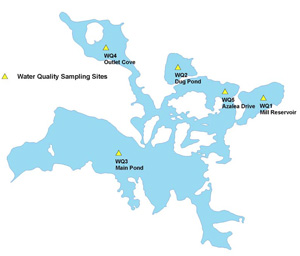 |
| Water quality was tested at five locations around the Pond. The vegetation survey sampled plant growth at about 50 data points established for the FPC's first survey in 2004. The 2012 survey is Corporation's 6th. |
The report notes that algae blooms are triggered in warm weather by excessive nutrient levels, including phosphorous exceeding .02 mg/L. The water samples from Foster's Pond last August showed two to three times that level everywhere but Dug Pond.
Reducing phosphorus levels in the Pond will be "challenging," says the report, because it is likely coming from two sources that are almost impossible to manage: storm run-off into streams which feed the Pond and natural nutrients in the sediments which underlie most of the water body.
ACT recommends that the Corporation consider using copper sulfate to treat algae, but notes that algaecides treat "the symptom, rather than dealing with the cause." Copper sulfate is widely used in ponds and drinking water reservoirs, and is relatively inexpensive. ACT also recommends use of a newly approved algaecide, SeClear, which contains both copper sulfate and an agent which binds with and removes phosphorus from the water.
Algae Blooms Trigger Health Warnings
August, 2012
Blue-green algae have been found in Foster's Pond in concentrations high enough to prompt warnings that swimmers and pets should stay out of most parts of the Pond.
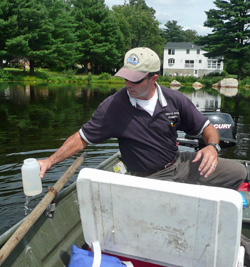 |
| August 20: Senior biologist Marc Bellaud draws a water sample from the cover near Azalea Drive - one of the few areas with little algae. |
Foster's Pond in August joined a list of water bodies in the region which have exhibited unusually dense concentrations of the cyanobacteria Anabaena, which is known to produce a toxin that can sicken people and can be deadly to dogs and other pets which drink too much of it.
Blue-green algae often shows up as a thin scum on the surface of the water. If you see a blue-green scum on the water, or blue-green swirls near the surface, stay out and keep your pet away.
And an algae bloom can occur overnight, so one day's tests showing low levels of algae may be obsolete in a matter of hours. Moreover, the toxin may linger even after the algae disappear, so health authorities caution against going into the water for at least a week or two after tests prove negative.
On August 20, the Foster's Pond Corporation commissioned sampling in several areas of the Pond - the Main Pond (near the community raft), Dug Pond, the Mill Reservoir, the Outlet Cove (between the Channel and Rock Island), and the cove at the end of Azalea Drive. The water samples were drawn and examined by Marc Bellaud, senior biologist for the FPC's lake management consultant, Aquatic Control Technology. The results, provided to the FPC on August 22, were as follows:
| Main Pond | 62,000 cells/ml |
| Dug Pond | 0 cells/ml |
| Mill Reservoir | 44,000 cells/ml |
| Outlet Cove | 63,000 cells/ml |
| Azalea Drive | 1,000 cells/ml |
Surface samples were also taken from visible scum in the Channel, near the Dam, and along the easterly shore (the Pomeroy Road shore) of the Main Pond. The cells in these samples were, in Bellaud's words, "almost too numerous to count." He estimated that these samples contained "several hundred thousand cells/ml."
According to Bellaud, "The World Health Organization recommends swimming restrictions if the cyanobacteria counts exceed 70,000 cells/ml." The Massachusetts Department of Public Health uses the same standard. (To read an MDH brochure on blue-green algae, click here.)
Given the relatively high counts in the Main Pond, the Outlet Cove (including the Channel), and the Mill Reservoir, the advice the FPC has received is that people and pets should stay out of the water in these areas.

Relatively high concentrations of blue-green algae were found in the Main Pond, the Outlet Cove, the Channel, and the Mill Reservoir. Only Dug Pond and the unnamed area at the end of Azalea Drive -between Dug Pond and the Mill Reservoir - were found to have little or none of the noxious cyanobacteria.
At least for now, it appears that both Dug Pond and the cove at the end of Azalea Drive are pretty much algae-free. But as warm, dry weather continues, that could change, so residents and visitors are advised to look before you (or your pets) take a plunge.
Health warnings like this are a first for Foster's Pond. The FPC has never previously tested for cyanobacteria, so there is no baseline information from prior years.
With climate change, it appears that area water bodies are exhibiting more severe algae blooms. On August 9, the Boston Globe reported on algae blooms in nine area lakes, including Stevens Pond in North Andover.
 |
| This warning, adapted from a poster issued by the Massachusetts DPH, has been put up by the FPC at strategic locations around the Pond. |
The Globe article, and the scum she saw near her dock, caused one Pond resident to collect a water sample and get it tested. That test, and a follow-up test the next week, showed high enough concentrations of blue-green algae to prompt the FPC (after consulting with experts) to post warnings around the Pond and arrange for more comprehensive sampling.
The water samples taken August 20 have been sent to a lab for additional water quality tests.
What's the solution? There's no easy answer. Algae feed on phosphorous, so Pond-side residents must do their part to keep phosphorous from leaching into the water. Use phosphorous-free fertilizers and cleaning products so that you don't feed the algae!
Many lakes experience algae blooms because of faulty septic systems near-by, but septic systems in the Foster's Pond watershed have already been upgraded over recent years.
There's no practical way to eliminate all the nutrients in the Pond's sediments, which means that there is no way to completely starve the algae.
Treatment is one possibility in future years. Copper sulfate is the most common and least expensive algaecide. It has never been used in Foster's Pond. Treating an algae bloom is not recommended, however, because a massive and sudden algae die-off can deplete the oxygen in the water, causing a fish kill. Moreover, the dying blue-green algae would release their toxins all at once, and that could cause additional problems. So copper sulfate is usually recommended when algae are just beginning to appear.
Post-Treatment Survey Finds No Trace of Fanwort
December, 2011
The Foster's Pond Corporation's lake management consultant slowly wound his way around the Pond in a small boat in September, examining the results of this year's weed treatments. At 50 locations, he dragged a rake across the bottom and tallied the vegetation it picked up.
The good news: He found a healthy variety of native plant species. The even better news: He didn't find fanwort and Brazilian elodea, two non-native invasives that were targeted in herbicidal applications earlier in the summer.
 |
| September, 2010: Fanwort in the Channel. |
The last time the entire 120-acre Pond had been treated was 2005, when fanwort had overwhelmed native species to become the dominant plant throughout Foster's Pond. In 2007, 19 acres were spot-treated. Pond-wide surveys in 2009 and 2010 found only small fanwort colonies in the Main Pond, but by then it was growing densely throughout much of the Channel. The 2011 treatment was aimed at controlling the fanwort before it again took over the entire Pond.
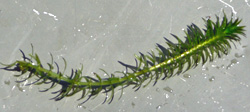 |
| July 7: Brazilian elodea from Dug Pond, just before treatment. The non-native invasive had become widespread in Dug Pond, but had not yet moved to adjacent Foster's Pond. |
In addition, another non-native was found in 2010 carpeting the bottom of Dug Pond, the Town-owned 3.9-acre swimming hole which drains into Foster's Pond and is separated from the larger water body by a narrow berm. Dug Pond was also targeted for treatment in 2011.
On May 13 and again on June 24, technicians from the Corporation's lake management consultant, Aquatic Control Technology, zoomed around the Pond in an18-foot airboat applying time-release pellets and a liquid formulation of fluridone (sold under the brand name Sonar), the only registered for aquatic use in Massachusetts that is effective in controlling fanwort. They airboat was equipped with a calibrated spreader and pumping unit, linked to a GPS unit which was used for navigation to ensure that the herbicide was applied in the right concentration.
 |
| GPS track of the airboat on its June 24 run. Click on the image above to see an enlargement. |
A key to effective use of Sonar is maintenance of a low but consistent concentration of the slow-acting chemical in the water over an extended period. The target concentration, in parts per billion, is lower than that allowed in public drinking water supplies. Sonar prevents green plants from producing yellow pigments which protect chlorophyll from breaking down under sunlight. Without the yellow pigments, the plants slowly bleach out and die. The process (called “chlorosis”) can take upwards of 6 to 8 weeks - an advantage, since the slow dying avoids sudden oxygen depletion (which could result in fish kills) or nutrient release (which could result in algae blooms).
 |
| Map of the 50 data collection points, established in 2004, for consistent monitoring of vegetation in the Pond. Click on image above to view an enlargement. |
The results could hardly have been better. Fanwort was already showing signs of Sonar exposure within a month after the first 2011treatment, and chlorosis progressed throughout the summer. ACT conducted comprehensive post-treatment survey on September 19, using a set of 50 data points established in the Corporations 2004 vegetation survey and utilized in four subsequent surveys. The consultant’s final 14-page treatment report, which was submitted to the FPC on December 20, states that during the September 19 comprehensive survey, “no viable fanwort was found anywhere in Foster’s Pond.”
The Brazilian elodea in Dug Pond (which had no fanwort to speak of) was treated on July 7 with a different herbicide, diquat (sold under the brand name Reward). ACT reported that this “treatment worked very well,” and that “[n]o Brazilian elodea was found in Dug Pond following treatment.”
No further weed treatments are planned for 2012, but the Corporation will closely monitor aquatic vegetation in the Pond. After earlier treatments, the range and variety of native plants increased, providing better habitat for fish and wildlife and a more balanced ecosystem.
"PurLoo Beetles" Join Their Cousins to Attack Invasive Weeds
July, 2011
The Foster's Pond Corporation has turned to nature for help in combating purple loosestrife, a widespread invasive weed that has been expanding along the shores of the Pond, driving out native species such as cattails.
Hand-pulling the deeply-rooted plants is virtually impossible when there are acres of them to deal with, and herbicides are a last resort. The solution recommended by the FPC's lake management consultant: beetles.
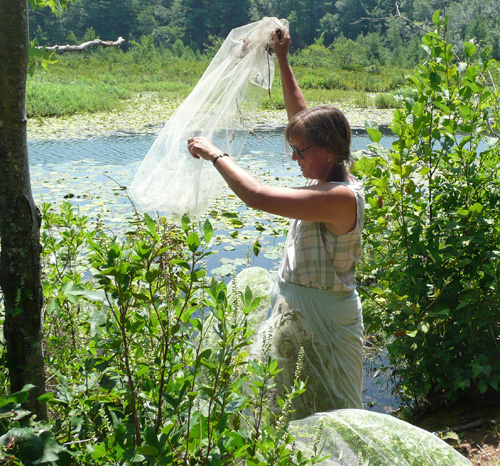
July 22: Beetle wrangler Suzanne Robert lifts a net from a potted purple loosestrife plant, freeing the "PurLoo beetles" she has raised. The nearest patch of their favorite food is a stand of purple loosestrife choking an area between Azalea Drive and the mouth of the Mill Reservoir.
"PurLoo beetles," as they are called by environmentalists who advocate their use, prefer purple loosestrife to all other plants, and although they have been known to dine on the occasional rosebush, they will return to the purple loosestrife to lay their eggs. And there's plenty of purple loosestrife around Foster's Pond to keep them happy.
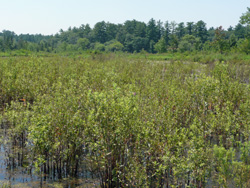 |
| About 3/4 of an acre of purple loosestrife took over the passage between Azalea Drive and the mouth of the Mill Reservoir last summer. |
With the help of Andover's Conservation Department, the FPC teamed up with "beetle wrangler" Suzanne Robert. A scientist at the Massachusetts Department of Environmental Protection's Drinking Water Program, Ms. Robert has been raising "PurLoo beetles" on her own time for the last three years, working with municipalities and environmental organizations to release them in various wetlands.
She collects beetles and larvae in the wild, placing them on potted purple loosestrife plants surrounded by netting. When the larvae have sufficiently matured, the pots are set on dry land near the targeted patches of purple loosestrife, the netting is removed, and the beetles are free to dine. They can range up to half a mile in search of their favorite meal.
Some purple loosestrife plants, unfortunately, have a built-in advantage that lets them survive the beetle. The beetles propagate twice each summer, and to do so, they must climb down the host plants to the soil. But if those host plants are rooted in standing water, the beetles will drown or get eaten by predators - and a lot of the purple loosestrife in Foster's Pond grows in standing water.
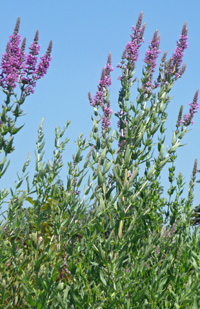 |
| Purple loosestrife on the shore of the Main Pond. It's an invasive weed which drives out native species and is very difficult to control. |
Last summer, dam repairs and an ensuing drought exposed an area between Azalea Drive and the the old Frye's Dam at the mouth of the Mill Reservoir, leaving that area high and dry. Purple loosestrife took root and flourished. It now covers upwards of three-quarters of an acre in that area alone, but with normal water levels restored, the plants are in standing water. As a result, even though many of them are being eaten by "PurLoo beetles," those beetles are doomed as the summer wears on.
That's where Ms. Robert's home-grown beetles come in. With help from FPC President Steve Cotton, she brought five potted plants to the area, each hosting beetles she had raised in her driveway. They were positioned on the peninsula directly across from Bessie's Point, and as she removed the netting and merrily encouraged the beetles to take wing, she estimated that there were about 200 of them to join those already attacking the target plants. The difference is that the newcomers are likely to return to the potted plants on which they were raised and will not drown in the course of producing a new generation. The pots will be left in place over the winter, so that another generation will get an early start attacking purple loosestrife in the vicinity next spring.
Ms. Roberts suggested that to make a real dent in the purple loosestrife infestations around the Pond, area residents should raise and release the beetles, which she said is a pretty simple and inexpensive task. She offered to provide instruction to volunteers next spring. She added that she is an avid organic gardener, and that even though the beetles sometimes get loose, she has never seen damage to any of her flowers or vegetables.
Dug Pond Gets Its Reward
July, 2011
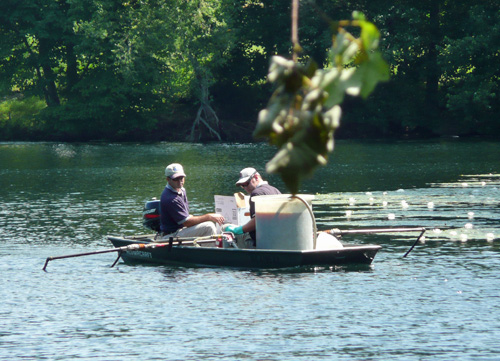
July 7: Technicians from Aquatic Control Technology treat Dug Pond. The herbicide is infused into the water from hoses trailing on both sides of the boat.
Dug Pond was treated with diquat (sold under the brand name Reward), in an effort to rid the 3.9-acre swimming hole of Brazilian elodea, a non-native invasive weed.
 |
| July 7: Brazilian elodea from Dug Pond, just before treatment. The non-native invasive had become widespread in Dug Pond, but had not yet moved to adjacent Foster's Pond. |
Technicians from the Foster's Pond Corporation's lake management consultant, Aquatic Control Technology, circled Dug Pond in a small boat trailing hoses to infuse the pond with a dilute formulation of the herbicide, which is expected to kill the weed over the next several weeks. Native species in Dug Pond will rebound following the treatment.
The Town-owned basin on Glenwood Road Extension feeds into the rest of Foster's Pond, and if left untreated the Brazilian elodea would almost certainly find its way into the larger water body. A common species in home aquariums, Brazilian elodea can spread quickly in the wild, driving out native plants.
Dug Pond was treated on July 7. It was closed for the day to boating, swimming and fishing. Residents were advised not to use treated water for irrigation for five days.
Dug Pond to Be Treated July 7
July, 2011
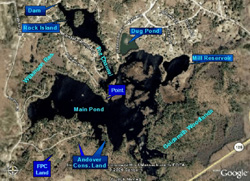 |
| Dug Pond lies on the right shoulder of the flying duck. For an enlarged map, click on the image above. |
Dug Pond will be treated July 7 to combat a spreading infestation of Brazilian elodea, an invasive weed that last year spread throughout the 3.9-acre swimming hole just off Glenwood Road Extension.
The Town-owned basin is part of the Foster's Pond watershed, and empties into the larger water body. Dug Pond is separated from Foster's Pond by a narrow berm.
Dug Pond will be closed to fishing, boating and swimming for the entire day. Residents are advised not to use treated water for irrigation for five days.
 |
| Brazilian elodea taken from "Dug Pond" in 2006. A Sonar treatment aimed primarily at killing fanwort also slowed the Brazilian elodea that year, but since then it has spread. Diquat will be used this time, as it is more effective against Brazilian elodea. |
Dug Pond will be treated with diquat (sold under the brand name Reward), the mostly widely used aquatic herbicide in Massachusetts and other Northeastern states. Diquat has been used previously in Foster's Pond. It was applied to 3.25 acres of the Main Pond last year to spot-treat for spiny naiad. Diquat is registered for use in the vicinity of shallow wells; it binds quickly with sediments, so that it does not travel through soils.
The treatment is part of a plan approved by the Andover Conservation Commission.
"Booster" Shot Zaps Weeds; Dug Pond Is Next
June, 2011
The Pond received a second dose of Sonar on June 24, six weeks after an initial treatment of the herbicide had begun to decimate nuisance weeds that were staging a comeback.
Technicians roared over the Pond in an 18-foot airboat, dragging hoses that diffused low concentrations of the slow-acting weed-killer, the only approved means of controlling the Pond's most menacing invasive, fanwort.
Residents are advised not to use Pond water for irrigation until August 14. Swimming, boating and fishing are allowed at the low concentrations used for treating fanwort.

June 24: Airboat skims the Main Pond, injecting a "booster" treatment of Sonar below the surface.
As expected, Brazilian elodea has re-appeared in Dug Pond, and a treatment with diquat is tentatively scheduled sometime during the week of July 4. Following that treatment, water from Dug Pond should not be used for irrigation for 5 days.
These treatments are taking place in accordance with a plan approved by the Andover Conservation Commission.
Weeds Start to Fade; Pond Will Get "Booster" Treatment June 24
June, 2011
The Pond will be closed for boating, fishing and swimming on June 24, when the airboat will return for a "booster" treatment with the slow-acting herbicide that is already bringing a faded look to fanwort and water lilies throughout the Pond.
This year's Pond-wide treatment of nuisance weeds has sharply reduced problem vegetation, just six weeks into a three-month regimen. Fanwort - which, without the treatment, would appear a luminescent green and by now be choking the Channel - instead is showing sickly white tips. Lily pads are pallid, too, and both species are growing much more slowly than usual.
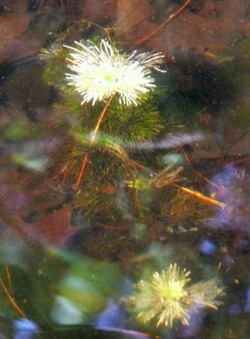 |
| June 21: Fanwort in the Channel showing signs of chlorosis - the bleaching effect triggered by Sonar. Nuisance weeds throughout the Pond are fading. |
It's all due to Sonar, the slow-acting herbicide the Corporation is using to combat fanwort. Sonar works by interfering with the plants' ability to produce yellow pigments which protect chlorophyll from breaking down under sunlight. Without the yellow pigments, the plants slowly bleach out and die. The process (called "chlorosis") can take upwards of 6 to 8 weeks to start - an advantage, since the slow dying avoids the prospect of sudden oxygen depletion (which could result in fish kills) or nutrient release (which could result in algae blooms).
The trick is to maintain a low concentration of Sonar in the Pond over a 60- to 90-day period. Since the Sonar itself breaks down, and works at extremely low doses, effective treatment requires monitoring, with one or two "booster" shots if concentrations fall too far.
Last week, the Corporation's lake management consultant, Aquatic Control Technology, sampled the Pond and found concentrations of 10.6 parts per billion (ppb) near the dam and 17ppb in the Channel. The target concentration is between 10 and 20 ppb. Environmental regulators allow concentrations of Sonar up to 20 ppb in public drinking water supplies, and even though Foster's Pond is not used for drinking, the FPC requires the concentration to be kept below this threshold.
Still to come as part of the FPC's 2011 weed program: treatment of Dug Pond with diquat, if Brazilian elodea re-emerges this year; and release of beetles which dine on purple loosestrife, which last year began to choke the passage between Azalea Drive and the mouth of the Mill Reservoir.
Treatment Starts Under Ideal Conditions
May, 2011
Mother Nature could hardly have been more cooperative as technicians launched their airboat to begin the Corporation's 2011 assault on fanwort.
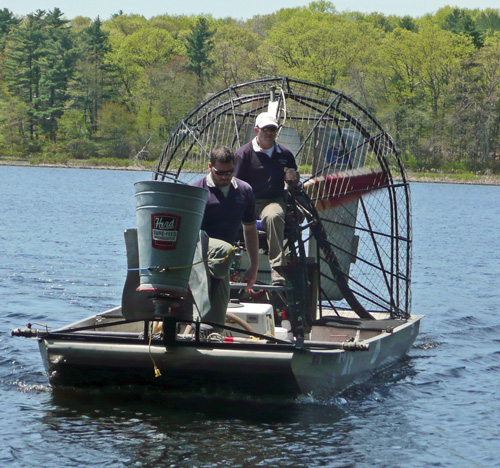
May 13: Sonar treatment of Foster's Pond begins under cloudless skies.
Under sunny skies, Aquatic Control Technology senior biologist Marc Bellaud gunned the prop, steering the craft into the Pond's shallowest coves as it sprayed herbicide-laced pellets into the areas of heaviest fanwort concentration. The pellets release the herbicide over an extended period.
The entire Pond was treated in accordance with a plan approved by the Andover Conservation Commission. Most of open-water areas were infused with a liquid solution of the slow-acting weed-killer, the only effective method authorized in Massachusetts for controlling the invasive weed which once dominated the Pond.
The Pond was closed to fishing, boating and swimming for the day. Pond water should not be used for irrigation for the next 90 days, but there are no restrictions on recreational uses of the Pond after the day of treatment. At the low concentrations at which the Sonar was applied - less than 20 parts per billion - it is permitted in municipal drinking water reservoirs.
Weed Treatment Set for May 13
May, 2011
Foster's Pond will be treated for invasive weeds on Friday, May 13. Fishing, boating and swimming will be prohibited throughout the Pond for the day. Signs will be posted at strategic locations warning visitors and residents to stay out of the water.
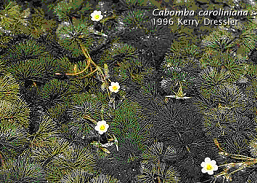 |
| Fanwort in full bloom. |
Residents are also advised not to use Pond water for irrigation until August 14. A low concentration of Sonar herbicide will be maintained throughout the 90-day treatment period, and using treated water on tender land plants is not recommended.
At the concentration used in the Pond - under 20 parts per billion - Sonar is permitted in public drinking water supplies, and it is OK to fish or swim in the treated water after the first day of application.
An inspection of the Pond on May 6 found the target weed, fanwort, was actively growing. The ideal time to begin treatment is when the plant starts emerging in the Spring.
A decision will be made on Friday whether to treat Dug Pond for fanwort. If no plants are visible, no Sonar will be applied. Dug Pond will be treated later for another invasive, Brazilian elodea.
This year's treatment - the first time in six years that the entire Pond has been treated for invasive weeds - is being undertaken in accordance with a plan approved by the Andover Conservation Commission.
Conservation Commission OK's 2011 Treatment Plan
April, 2011
The Andover Conservation Commission has unanimously approved the FPC's plan for treating Foster's Pond and Dug Pond this Summer to control invasive weeds.
The routine vote, which was expected, clears the way for the first whole-lake treatment of the Pond in six years.
The plan calls for treating all 120 acres of Foster's Pond in mid- to late May with a low doses of liquid fluridone (sold under the brand name Sonar), the only herbicide approved in Massachusetts for the control of fanwort. Areas of the Pond showing the highest density of fanwort will simultaneously be treated with slow-release pellets. In addition, Dug Pond will be treated for another invasive weed, Brazilian elodea.
Corporation Sets Sights on Fanwort Treatment This Summer
March, 2011
The Foster's Pond Corporation has endorsed a plan to treat the entire Pond this Summer - the first whole-lake weed treatment in six years - to control the spread of fanwort. The plan also calls for treating Dug Pond to rid it of another invasive weed, Brazilian elodea.
The treatment program will cost about $50,000, all of which will be paid by the Corporation.
Map from the treatment plan for 2011 shows concentrations of fanwort near the dam, throughout the Channel, and along the shoreline near the foot of Snowberry Road. Some stands were also found in the Main Pond, though nothing like the densities seen in 2005. To view a larger image, click on the map.
The treatment plan, approved by the Corporation's Board of Directors in January, has been submitted to the Andover Conservation Commission. The Corporation has been designated by the Conservation Commission to undertake an integrated lake management program to protect Foster's Pond.
The treatment plan was prepared by the Corporation's lake management consultant, Aquatic Control Technology.
The plan calls for treating all 120 acres of Foster's Pond in mid- to late May with a low doses of liquid fluridone (sold under the brand name Sonar), the only herbicide approved in Massachusetts for the control of fanwort. Areas of the Pond showing the highest density of fanwort will simultaneously be treated with slow-release pellets.

The treatment plan for 2011 calls for the areas outlined in red - which have the highest densities of fanwort - to be treated with slow-release pellets. The entire Pond will be treated with liquid Sonar, as well.
The aim is to maintain a low but steady concentration of Sonar in the Pond for several weeks. It is anticipated that one or two "booster" treatments of Sonar will be needed to maintain a target concentration of 5 to 12 parts per billion. That level, which is sufficient to kill fanwort, is far below the 20 ppb concentration allowed by regulatory agencies for use in public drinking water supplies. Even though no residents use the Pond directly for their drinking water, the Corporation seeks to use the minimum dose needed to control nuisance invasives.
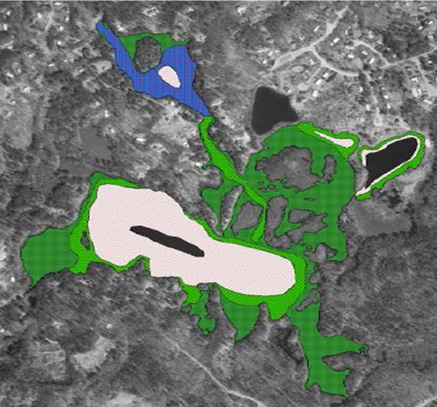 |
| 2004: Pink, blue and lighter green areas are mostly fanwort. The darker green denotes water lilies. Black is open water. (Dug Pond wasn't surveyed in '04). |
 |
| 2008: The greenish areas denote water lilies. The blue is open water. That little spot of pink is the only significant colony of fanwort. (Click the images for larger maps.) |
Sonar was used to treat the entire Pond in 2005, when fanwort had become the dominant plant in most of the Pond, covering nearly half of the open water. Left unchecked, fanwort can literally choke a Pond to death. The results of that first treatment were astonishing, virtually eliminating fanwort throughout the Pond.
But any such treatment is a temporary fix, and many water bodies must be treated every two or three years to keep fanwort from taking over. In Foster's Pond, 18 acres between Mill Reservoir and the dam were re-treated in 2007, though the rest of the Pond remained almost fanwort-free. An aquatic plant survey in 2008 found fanwort in less than 1% of the Pond (as opposed to 50% before the 2005 treatment), and in 2009 it covered just 6.1% (one-ninth of its pre-treatment infestation). In 2010 - three years after the "spot" treatment - fanwort was returning to nuisance levels in the Channel. It was also showing up in the Main Pond. But five years after only one treatment, fanwort levels in the Main Pond have remained far below their pre-treatment densities.
Previous fanwort treatments have had no adverse effects on fish or wildlife, and have allowed beneficial native plants to re-establish themselves. The 2009 plant survey found 23 native submersed or floating plant species, compared to 11 found in 2004. Native plant species provide better habitat for fish and wildlife than fanwort, which grows in thick mats which overpower other plants.
 |
| Brazilian elodea taken from "Dug Pond" in 2006. A Sonar treatment aimed primarily at killing fanwort also slowed the Brazilian elodea, but since then it has spread. Diquat will be used in 2011 to control this invasive in Dug Pond. |
The treatment plan also calls for a single application of diquat (sold under the brand name Reward) in Dug Pond during June to control Brazilian elodea. Diquat is the mostly widely used aquatic herbicide in Massachusetts and other Northeastern states, and was applied to 3.25 acres of the Main Pond last year to spot-treat for spiny naiad. Diquat is registered for use in the vicinity of shallow wells; it binds quickly with sediments, so that it does not travel through soils.
The treatment program will require temporary water use restrictions this summer. Although not required by the EPA product labels, all of Foster's Pond and Dug Pond will be closed for swimming, boating, and fishing on the day of any treatment. Water from Dug Pond should not be used for irrigation (or for drinking or watering livestock) for five days following treatment with diquat; water from Foster's Pond should not be used for any of these purposes for 30 days following the final application of Sonar.
Next Up: Consultant Recommends Pond-Wide Fanwort Treatment in 2011
December, 2010
The Corporation's lake management consultant has recommended treating Foster's Pond next Summer to control fanwort, which has slowly grown back to nuisance levels in the Channel and has begun to re-establish itself throughout the Pond.
A report presented this month by Aquatic Control Technology's senior biologist Marc Bellaud shows "moderate to abundant densities" of fanwort near the dam, throughout the Channel, and along the shoreline at the foot of Snowberry Road. Colonies of the weed - which once dominated the Pond - were also found in the Mill Reservoir and among dense water lily beds in the Main Pond.
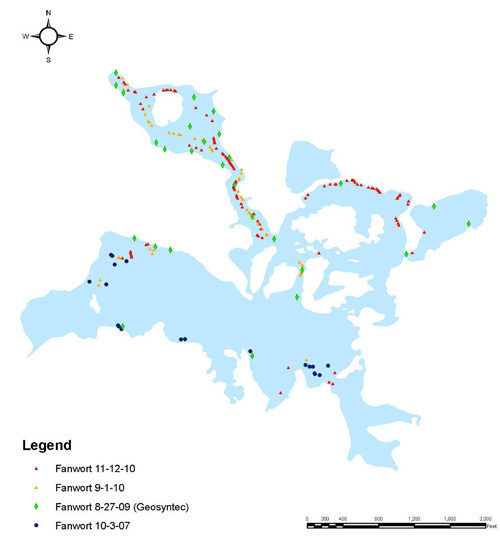
Map from ACT's 2010 report shows concentrations of fanwort near the dam, throughout the Channel, and along the shoreline near the foot of Snowberry Road. Some stands were also found in the Main Pond, though nothing like the densities seen in 2005.
The report notes that fanwort remains far less dense than it was in 2005, when the 120-acre Pond was choking on the non-native invader. Fanwort (Cabomba caroliniana) is an aquarium plant that, once it finds its way into a New England pond, can take over, driving out native plants, destroying habitat, and eventually becoming so dense that fish suffocate and the lake dies. A treatment of the whole Pond in 2005, followed by a "spot" treatment of 18 acres in the Channel in 2007, kept the fanwort in check. Since many ponds require re-treatment every couple of years to stop the spread of fanwort, a six-year span between whole-lake treatments is regarded as an excellent result.
 |
| 2005: Fanwort in the Main Pond prior to treatment |
Only one herbicide is currently approved in Massachusetts for the treatment of fanwort. Fluridone (marketed under the brand name "Sonar") works by blocking the plant's production of yellow pigments which protect chlorophyll from breaking down in sunlight. Without the yellow pigments, the chlorophyll bleaches out, the plant can't produce the food it needs, and it dies. The process is called "chlorosis," and it takes at least 6 to 8 weeks to kill the plant. Biologists regard the slowness of the process as a good thing, since a more rapid die-off would run the risk of depleting oxygen in the Pond. Sonar is applied both in spray form and through slow-release pellets.
After the 2005 treatment, no adverse effects were observed in fish or wildlife, and native plants re-established themselves in greater density and variety than before the treatment.
Sonar, at the concentrations used for fanwort treatment, is considered by regulators to be safe for use in public drinking water reservoirs right up to the intake pipes.
The ACT report was based on surveys of the Pond conducted on September 1 and November 12.
 |
| Brazilian elodea taken from "Dug Pond" in 2006. A Sonar treatment aimed primarily at killing fanwort was also taking out the Brazilian elodea. Healthy plants are bright green, with no pink or white. Fanwort disappeared from Dug Pond,but the Brazilian elodea hung on. |
The survey found no fanwort in Dug Pond, the 3.9-acre Town-owned swimming hole separated from the rest of Foster's Pond by a narrow berm. But Bellaud found "healthy growth" of another invasive weed, Brazilian elodea, which had been detected in small amounts in previous years. Brazilian elodea carpeted stretches along the shoreline, leading ACT to recommend treating Dug Pond with a different herbicide, diquat (marketed as "Reward"). Diquat is less expensive than Sonar, and may be more effective against Brazilian elodea,but diquat has no effect on fanwort. Two areas of the Pond were treated last Summer with diquat in order to wipe out newly-discovered colonies of yet another invasive weed, spiny naiad. The report notes that the treatment for spiny naiad appeared to have been successful.
Treating Foster's Pond for fanwort, and Dug Pond for Brazilian elodea, could cost upwards of $50,000. The Foster's Pond Corporation has been collecting contributions from area residents in preparation for just such an effort over the last few years. The Board of Directors will consider the ACT recommendations and decide how to proceed. If the recommendations are adopted, the Corporation will seek approval from the Andover Conservation Commission, which can authorize weed treatments under an ongoing Order of Conditions that governs the Corporation's stewardship of the Pond.
Two Areas of Pond Receive Diquat Treatment
July, 2010
Two areas of Foster's Pond were sprayed with an herbicide on July 19, in an effort to eradicate a potentially troublesome invasive weed that was discovered in the Pond for the first time last year.
The new pest, spiny naiad, was found in the Channel and on the north shore of the Main Pond. A fast-acting contact herbicide, diquat, was applied to both infestations. Altogether, about 3.5 of the Pond's 120 acres were treated. The Pond was closed to fishing, boating, and swimming for the day, and residents living near the treatment areas were advised not to use Pond water for irrigation for the next five days.
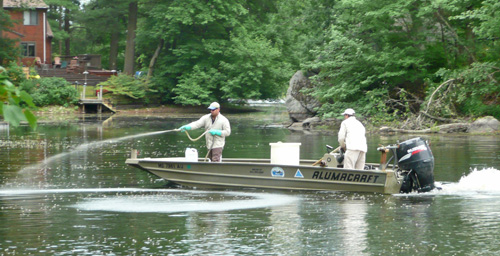
July 19: Technicians spray diquat in the Channel, in an effort to control spiny naiad. A small section of the Main Pond was also treated.
The mid-day spraying operation took less than two hours, as a pair of technicians from the Corporation's lake management consultant, Aquatic Control Technology, passed back and forth in the treatment areas in a motorboat, using a GPS device to track their progress.
The herbicide, diquat, is said to the most commonly used aquatic weed-killer in Massachusetts. It is sold under the brand name Reward.
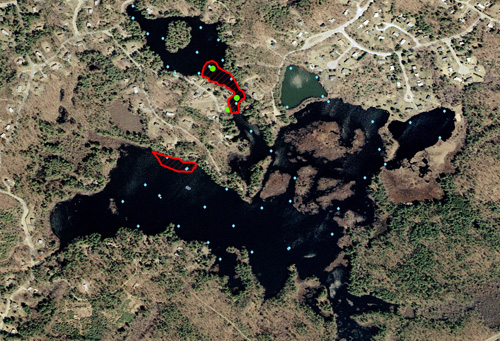
Two areas of the Pond, marked in red, were treated with diquat on July 19.
ACT senior biologist Marc Bellaud, who oversaw the operation, said he expected that the target species in the treatment zones will begin to die off in about a week, and be pretty much gone in about two weeks. The diquat is also expected to kill ribbonleaf pondweed, a native plant which has covered several patches in the Channel due to the low water level in the Pond.
The diquat will not, however, kill fanwort, which has returned in force this year after having been largely beaten down by a weed treatment administered in 2005. Fanwort had before that treatment become the dominant weed in the Pond. The Corporation is planning another whole-lake treatment next year aimed at the fanwort, but that will require the use of a different herbicide, Sonar (fluridone).
Diquat Treatment Set for July 19, Closing Pond and Limiting Irrigation
July, 2010
A chemical herbicide will be applied to two areas of the Pond - one in the Channel and another on the northerly shore of the Main Pond - on July 19. As a precaution, the Pond will be closed to fishing, boating, and swimming for the day, and residents along the shorelines abutting the treated areas are cautioned not to use Pond water for irrigation until July 25.
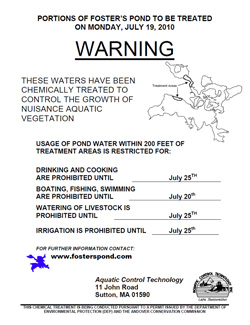 |
| July 19: Pond will be closed for one day. Water from treatment areas should not be used for five days. Click on poster to see full-sized image. |
A total of approximately 3.5 of the Pond's 120 acres will be treated in an effort to keep a newly-discovered invasive weed, spiny naiad, from spreading. The non-native invader, first discovered in an inspection last year, is capable of producing millions of seeds and taking over a pond ecosystem.
Licensed applicators from the Corporation's lake management consultant, Aquatic Control Technology, will spray the herbicide from a small boat in the areas where spiny naiad has been found. They will be using diquat (sold under the brand name Reward), said to be the most widely used aquatic herbicide in Massachusetts. The spraying plan was approved earlier this year by the Andover Conservation Commission, and a license for next week's treatment has been issued by the State Department of Environmental Protection.
Warning posters will be put up in various locations with access to the Pond, closing the Pond for boating, fishing and swimming on July 19. The closure does not apply to Dug Pond or the Mill Reservoir, which will not be affected by the treatment. The posters also warn that Pond water within 200 feet of the treatment areas should not be used for drinking, cooking, livestock watering, or irrigation until July 25.

Two areas of the Pond, totaling about 3.5 acres, are slated for treatment with diquat on July 19. The chemical will be applied from a small boat.
Diquat binds to sediments, which render the chemical biologically inert. That is one reason the chemical may be used near shallow wells. Nevertheless, owners of shallow wells near the treatment areas have been cautioned to use bottled water, or water that has passed through a charcoal filter, if they want to feel absolutely secure.
No one gets their drinking water directly from the Pond, but some residents use Pond water for irrigating lawns or gardens, and they are cautioned not to use water in the treatment areas for five days - or they may find their lawns going the way of the spiny naiad.
Diquat will also reduce some other weeds in the treatment areas, including ribbonleaf pondweed which has prospered in the unusually low water level this Summer. Diquat will not, however, have much effect on fanwort, the long-term non-native weed which once dominated the Pond and has returned in thick colonies this year. A treatment of the entire Pond next year with another herbicide, Sonar, will be needed to get rid of fanwort.
Inspection Finds Spiny Naiad and Fanwort
July, 2010
As the thermometer hovered at 100 degrees, biologist Marc Bellaud rowed the shoreline of Foster's Pond, occasionally reaching deep into the water to grab a handful of weeds.
What he found was no surprise. Fanwort has spread in shallow waters throughout the Pond, and a newer invader - spiny naiad - has established a toehold in a couple of acres of the Channel.
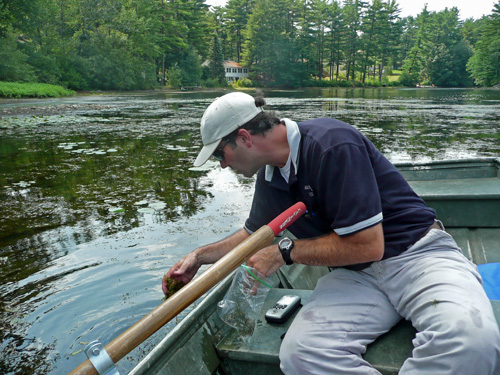
July 6: ACT senior biologist Marc Bellaud collects weed samples from the Channel. Most of the floating weeds in the background are ribbonleaf pondweed, a native plant that expanded this year due to low water levels in the Pond. Spot treatment for spiny naiad this year, and Sonar treatment of the whole Pond next year for fanwort, will also reduce the ribbonleaf pondweed.
Bellaud, who is senior biologist for the Corporation's long-time lake management consultant Aquatic Control Technology, has been surveying weeds in Foster's Pond since 2004, and has systematically assessed the effects of weed treatments that were begun in 2005.
Accompanied by FPC President Steve Cotton, Bellaud on July 6 maneuvered a rowboat into the two shoreline areas where spiny naiad was detected last year. And he rowed around much of the Pond, to determine which areas should be treated with an herbicide. Under a plan approved this Spring by the Andover Conservation Commission, the Corporation will spot-treat areas of naiad infestation before the unwanted annual can drop millions of seeds that would sprout next year.
Not much spiny naiad was visible in the Main Pond, but significant stands were evident in the Channel, mixed in with fanwort and a lot of native plants, including coontail and ribbonleaf pondweed.
Bellaud noted that the ribbonleaf pondweed appears to have expanded in a few spots in the Channel as a result of the low water level in the Pond, occasioned by work to repair the dam.
Bellaud collected samples to confirm the identification of target species back in his lab.
 |
| Spot treatments to reduce spiny naiad are now slated for July 19. The Pond will be closed for fishing, boating and swimming for the day. |
In accordance with this year's treatment plan, Bellaud will prepare a map showing the areas that will be spot-treated with diquat, a fast-acting contact herbicide which will kill not only the spiny naiad but also ribbonleaf pondweed.
The tentative date for the diquat treatments - expected to cover three to five acres of the 120-acre Pond - is July 19. The Pond will be posted as closed to fishing, boating, and swimming for the day. Treated water should not be used for drinking, watering animals, or irrigation for five days following treatment.
Diquat binds to sediments, and so does not travel thought soils. That's why it can be used in areas with shallow drinking water wells. It is probably the most widely used aquatic herbicide in Massachusetts, and has been used at three other ponds in Andover, including Pomp's Pond, where the Town maintains a public beach.
Next year, the Corporation will treat the entire Pond with Sonar (fluridone), the only herbicide licensed in Massachusetts which is effective against fanwort. Sonar will also sharply reduce water lilies, ribbonleaf pondweed, and any remaining spiny naiad.
Conservation Commission Approves Diquat Plan
March, 2010
The Andover Conservation Commission unanimously approved a plan prepared by the Foster's Pond Corporation's lake management consultant to treat portions of the Pond this Summer in an effort to kill newly-discovered colonies of spiny naiad.
The Commission's vote came at a meeting March 17, following presentations by FPC President Steve Cotton and Marc Bellaud, senior biologist for Aquatic Control Technology. Bellaud had prepared the treatment plan, which calls for the use of diquat on two colonies of the non-native weed, which was found during a survey of the Pond's aquatic vegetation last Summer.
Under the plan, ACT will inspect the Pond in late June, when the fast-spreading annual begins to grow. Infestations will be treated with low doses of the fast-acting herbicide shortly after the locations are verified. The aim is to kill the plants before they drop their seeds. If not controlled, the weed has the potential to take over the Pond, driving out native species.
Consultant Submits Diquat Treatment Plan
February, 2010
Aquatic Control Technology, the Foster's Pond Corporation's long-time lake management consultant, has prepared a plan to employ low doses of a widely-used herbicide to treat infestations of spiny naiad this year.
Spiny naiad is a non-native invasive weed which was discovered in the Pond for the first time last Summer. It is an annual which drops millions of seeds each year, from which new plants grow the following season. If not controlled, it could take over the Pond, much as fanwort did in past years.
Under the plan developed by ACT senior biologist Marc Bellaud, two infestations - one in the Channel and another in the Main Pond - would be spot-treated with diquat, a contact herbicide which Bellaud described as "probably the most widely used aquatic herbicide in Massachusetts and other Northeastern States."
 |
| Spiny naiad, which drops millions of seeds each year, could take over the Pond if not treated, according to experts advising the Corporation. |
While diquat (which is marketed under the trade name Reward) has not been used previously in Foster's Pond, it has been employed in three other Andover water bodies, including Pomp's Pond, where the Town maintains a public beach. Because diquat does not migrate through soil, and has a half life of only 1 to 2 days, it is allowed in water bodies that are close to drinking water wells. There are a handful of shallow wells still in use around Foster's Pond, though only a couple are anywhere near the spiny naiad infestations that would be treated.
Diquat is usually applied at a rate of 1 gallon per acre in water averaging four feet deep, resulting in a concentration of 0.1 parts per million. The chemical is quickly absorbed by plants. What isn't absorbed by the targeted vegetation sinks to the bottom and binds to sediments, becoming "biologically unavailable" to other organisms, according to Bellaud.
In Foster's Pond, the chemical will not spread far from the anticipated treatment areas, which together total about 5 acres. The Pond is 120 acres. Although there are no restrictions on swimming, boating or fishing on the product label prescribed by the Environmental Protection Agency, the Pond will be closed to these activities on the day of treatment, under the proposed plan.
Treated water should not be used for drinking or cooking for 3 days, irrigating turf or food crops for 5 days, or watering livestock for 1 day. None of these restrictions has much application in Foster's Pond, but they will be posted around the Pond on the day of treatment.
The ACT plan was developed in consultation with FPC Board members Amy Janovsky and David Adilman, who were asked by the FPC Board to look more closely at the use of diquat before the Board determines to go ahead with any treatment. Although diquat use in Foster's Pond has been authorized by an Order of Conditions approved by the Andover Conservation Commission in December, the Commission must still sign off on the treatment plan before diquat can be employed this year.
Spiny naiad starts to grow in June, so a mid-June inspection of the Pond will be needed to verify the locations to be treated. The treatment must be undertaken in the following couple of weeks, before the plants mature and drop their seeds.
FPC Board Moves Cautiously on Spiny Naiad Threat
February, 2010
The Foster's Pond Corporation's Board of Directors has voted to proceed cautiously with herbicidal treatment of spiny naiad, a non-native invasive weed first observed in the Pond last Summer.
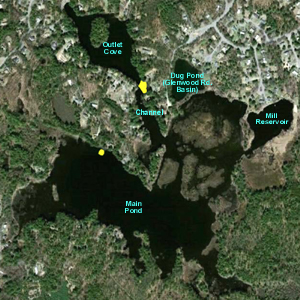 |
| The August, 2009, weed survey detected a new invasive, spiny naiad, in the two areas shown in yellow. Click the image to view a larger map. |
Meeting in January, the Board voted to move forward with securing permits to apply diquat to approximately five acres of the Pond - the course of action recommended by the consultant who performed a comprehensive survey of the Pond's vegetation in August. But the Board held off making a final decision on whether to make use of the permit, while it gathers more information on diquat.
Diquat (which is marketed under the trade name Reward) is one of the oldest and most widely-used herbicides approved by State regulators for use in lakes and ponds, and is approved for use in reservoirs which feed public water systems. It has previously been used in Pomps Pond, where Andover has its Town beach. However, since the chemical has not been used before in Foster's Pond, the FPC Board decided to look more closely before committing to spot-treat two colonies of spiny naiad.
The Board designated two of its members - Amy Janovsky and Weed Committee Chair David Adilman - to investigate further. They were to interview Bob Hartzel, the independent consultant from Geosyntec who detected the spiny naiad and recommended using diquat, as well as Marc Bellaud, senior biologist at Aquatic Control Technology, the FPC's lake management consultant who would apply the chemical if the FPC decides to proceed with a treatment. Amy is also undertaking her own review of scientific literature on diquat.
 |
| Spiny naiad, also known as European naiad, was discovered in Foster's Pond in August. The FPC's consultant has recommended treating the two infestations with diquat in 2010. |
Spiny (or European) Naiad is a hardy weed with narrow 1-inch long lime-green leaves which are brittle and curved. As noted in Hartzel's report to the Corporation last October, "This invasive plant has the potential to grow densely in shallow areas and can create monoculture stands that out-compete native species." Hartzel found stands of spiny naiad in the Channel and in on the northwest shore of the Main Pond. He recommended that the Corporation arrange for spot-treating these infestations with diquat in 2010.
According to ACT biologist Bellaud, spiny naiad is an annual. It drops seeds - by the millions - which sprout the following year. The strategy for eradicating it is to kill young plants with an herbicide before they can produce seeds. One problem: Seeds which fail to sprout one year can survive in lake-bottom sediments and sprout the next year - or the next - so that successive treatments may be needed to beat back the weed.
Until now, the main threat to the Pond's health has come from fanwort, an invasive weed that became the dominant plant in much of the Pond until the Corporation stepped in with Sonar, a different herbicide which is the only effective way to counteract fanwort. Sonar treatments had spectacular results, virtually eliminating fanwort for several years while allowing native plant species to rebound.
But, as expected, the fanwort has returned, and another whole-lake Sonar treatment is likely to be needed, perhaps in 2011. A major worry now that spiny naiad has appeared is that the next Sonar treatment will clear the way for spiny naiad seeds to sprout with no competition - allowing the new invader to take over the Pond. A 2010 diquat treatment of today's relatively small spiny naiad infestations would block new seed production, so that the only seeds that would sprout in 2011 would be those left over from last year. Sonar treatment in 2011 would take out spiny naiad growing from the left-over seeds, along with the fanwort, giving native plants the upper hand. Neither Sonar nor diquat kills the seeds.
As the FPC Board continues its study of diquat, the Corporation will seek approval from the Andover Conservation Commission for using the chemical this year. The Commission has already voted to approve a three-year Order of Conditions which allows diquat use in Foster's Pond, but must give its okay to a specific treatment plan before the herbicide can be utilized.
The Board has invited ACT biologist Bellaud to the Corporation's Annual Meeting on April 12 to explain the treatment program and answer questions.
Conservation Commission Extends Lake Management Program
December, 2009
The Andover Conservation Commission has extended, through 2012, its approval of the lake management program under which the Foster's Pond Corporation conducts periodic weed treatments and annual winter drawdowns.
The Commission voted unanimously on December 1 to keep in place an Order of Conditions that covers hydro-raking, treating the Pond with Sonar to control fanwort, drawing down the water level every winter, maintaining the Foster's Pond Dam, and educating residents and visitors on watershed management practices. The Order was amended to allow the use of another herbicide, diquat, to control a newly-discovered invasive weed, spiny naiad.
The Order of Conditions is the Commission's detailed directive for regulating the management of Foster's Pond. It dates from 1992, when the Commission first authorized the use of hydro-raking to control nuisance weeds and remove muck from shoreline areas. In 2005, after extensive public hearings, the original Order was extended through 2009 and expanded to put in place a wide-ranging program that included herbicide treatment to eradicate non-native weeds such as fanwort. The Foster's Pond Corporation was designated as responsible for implementing the program.
With the 2005 Order scheduled to expire on January 4, 2010, the Commission voted this month to keep the program in place for another three years, the maximum presently allowed by State regulations.
The vote approved the recommendation of FPC President Steve Cotton, who briefly addressed the Commission and thanked members for their long-standing support of efforts to protect and preserve Foster's Pond.
 |
| The August, 2009, weed survey detected a new invasive, spiny naiad, in the two areas shown in yellow. Click the image to view a larger map. |
The inclusion of diquat in the arsenal of weed treatments permitted under the Order opens the way for a 2010 spot-treatment of spiny naiad, detected for the first time last August during a comprehensive survey of aquatic vegetation in Foster's Pond conducted by Geosyntec.
While the survey also documented the re-emergence of fanwort, Geosyntec recommended that the FPC limit treatment efforts in 2010 to the spiny naiad and delay considering a whole-lake assault on fanwort until 2011. A preliminary cost estimate of the diquat treatment is approximately $4,000; a fanwort treatment of the entire Pond is expected to cost more than ten times that amount.
The FPC Board of Directors has not yet made a decision on whether to treat the spiny naiad in 2010. And before any treatment can be undertaken in 2010, the Conservation Commission must sign off on a schedule and treatment program for the year.
Diquat is marketed under the trade name "Reward." According to Marc Bellaud, senior biologist for Aquatic Control Technology - the FPC's long-time lake management consultant - diquat is a "widely used contact herbicide" that "is applied to lakes and ponds throughout North America to control nuisance submersed aquatic plants." While effective for control of spiny naiad and some other invasive weeds, diquat does not kill fanwort. Among the herbicides permitted in Massachusetts, only Sonar works on fanwort.
Diquat is typically applied in late June or early July, within two weeks of the time that the spiny naiad starts growing. Spiny naiad is an annual that develops from seeds each year.
Although the product label prescribes no restrictions on swimming, fishing, or other recreational activities in treated water, ACT recommends the following temporary water use restrictions for diquat: no boating, fishing or swimming in the treated water on the day of treatment, and no use of treated water for drinking, watering livestock or irrigation for five days.
Based on the extent of spiny naiad observed by Geosyntec in August, it is estimated that approximately 5 acres of the 120-acre Pond would require treatment. Spiny naiad was found in the Channel and at one location along the northeasterly shore of the Main Pond.
2009 Survey Finds More Fanwort and Discovers Spiny Naiad
October, 2009
Four years after the entire Pond was treated with herbicide, and two years after a "spot" treatment was applied to the Channel, fanwort - the invasive weed which had become the dominant plant in most of the Pond - has begun to re-establish itself.
Pond residents were reporting fanwort sightings throughout the Summer of 2009, and their observations were confirmed by a systematic study conducted by Geosyntec, an environmental consulting firm retained by the Foster's Pond Corporation.
On August 27, Geosyntec Senior Water Resources Scientist Bob Hartzel took vegetation samples at 50 locations, pulling up plants with a grappling hook to identify submerged species. The samples were taken from the same locations that FPC consultants have inspected in previous studies.
"Fanwort was present at over half of the sampling stations and was distributed throughout the pond, compared to 2008 when Fanwort was observed at less than 10% of the sampling stations," Hartzel wrote in his 11-page report, which was provided to the Corporation on October 15.
Hartzel warned that "recent history clearly indicates that the conditions in Foster's Pond are well suited for dense growth of Fanwort over much of the pond's littoral zone (area of rooted plant growth). As such, the widespread nuisance Fanwort growth that characterized Foster's Pond prior to the 2005 Sonar herbicide treatment appears likely to recur over the next several years if additional herbicide applications are not conducted."
But Hartzel suggested that the Corporation refrain from treating the Pond in 2010. "Given that Fanwort was either absent or growing in very low densities (<5%) at a vast majority (78%) of the sampling stations, Geosyntec recommends that summer 2010 whole-lake Sonar treatment is not warranted at this time," he wrote in his report. "Given the wide distribution of Fanwort around the lake, spot treatment is not warranted at this time."
Hartzel further noted in his report, "It is encouraging that the whole-lake Sonar treatment in 2005 (and follow-up 2007 spot treatment) has yielded such a high degree of Fanwort control over a four-year period."
In a telephone conversation with FPC President Steve Cotton following submission of the Geosyntec report, Hartzel urged the Corporation to "be a little on the conservative side" in considering when to treat the Pond with Sonar again. He suggested that holding off on Sonar treatment for another year would be beneficial for the health of the Pond, as well as more economical for Pond residents. He also said that he would be "surprised" if the Pond did not need a Sonar treatment in 2011.
 |
| Spiny naiad, also known as European naiad, was discovered in Foster's Pond in August. The FPC's consultant has recommended treating the two infestations with diquat in 2010. |
Hartzel's survey also detected a new invader, Spiny (or European) Naiad, a hardy weed with narrow 1-inch long lime-green leaves which are brittle and curved. As noted in Hartzel's report, "This invasive plant has the potential to grow densely in shallow areas and can create monoculture stands that outcompete native species." Hartzel found stands of spiny naiad in the Channel and in one location on the northwest shore of the Main Pond. He recommended that the Corporation arrange for spot-treating these infestations in 2010 with diquat.
Hartzel also found a third invasive, Brazilian elodea, persisting in Dug Pond. This aquarium plant, which had been detected in prior surveys, has the potential to become a problem. Hartzel reported that the Dug Pond infestation "may be the only known occurrence of Brazilian Elodea in Essex County," and indicated that the State may be interested in trying to eradicate it before it spreads further.
Hartzel is the former Lakes and Ponds Program Coordinator at the Massachusetts Department of Conservation and Recreation. David Adilman, a member of the FPC Board of Directors and Chairman of the FPC's Weed Committee, arranged for Hartzel to conduct this year's survey at the request of the FPC. Adilman is a senior hydrogeologist at Geosyntec.
Weed Survey Shows Sharp Decline in Fanwort After Treatments
December, 2008
Back in 2004, when the Foster's Pond Corporation commissioned a comprehensive survey of vegetation in the Pond, the results were appalling: 79 per cent of the Pond was covered by plants of some type, and by far the most abundant was fanwort - a non-native, water-clogging invasive weed that covered more than half the surface. Virtually anywhere you stuck a pitchfork into the Pond, you'd come up with a clump of the stuff.
That's all changed. This year, after herbicidal treatments in 2005 and 2007, the Corporation contracted for a follow-up survey, and the results, contained in a just-completed 13-page report, are pretty close to miraculous: plant cover has shrunk to just under 16 per cent (that's only one-fifth of the area that was covered by weeds in 2004), and fanwort dominated less than 1 per cent of the Pond.
 |
| 2004: Pink, blue and lighter green areas are mostly fanwort. The darker green denotes water lilies. Black is open water. (Dug Pond wasn't surveyed in '04). Click the images for larger maps.) |
 |
| 2008: The greenish areas denote water lilies. The blue is open water. That little spot of pink is the only significant colony of fanwort. |
In 2004, fanwort was everywhere. At 39 locations in the Pond, a biologist dragged the bottom and analyzed the plants; fanwort was the prevalent species in 35 locations. In 2008, using a portable GPS unit, the biologist returned to the exact same locations, plus 10 new ones. Fanwort turned up at only 3 locations (4 if you count the one where a fragment was spotted floating in the water).
Only one spot had a thick colony of fanwort - the mouth of the Mill Reservoir. Although this spot was treated both in 2005 and 2007, it's a narrow channel through which all the water entering Mill Reservoir from Frye's Brook, and from springs which feed Dug Pond, flow into the main water body. One effect may have been to flush away the herbicide, letting deeply-buried root balls of the fanwort survive just in this area.
Marc Bellaud, senior biologist at Aquatic Control Technology, Inc., conducted both surveys for the Corporation, and oversaw the weed treatments as well. He concluded that there is not enough fanwort in Foster's Pond to warrant treatment in 2009.
Both surveys were conducted at nearly the exact same time of the year. The 2004 survey was done on August 16, and the 2008 survey on September 2.
 |
| 2005: Fanwort in the Main Pond prior to treatment |
The survey also included water quality sampling for the Main Pond, the Mill Reservoir, the Outlet Cove (between the Channel and Rock Island), and Dug Pond. In all locations, coliform bacteria were below laboratory detection limits.
In the Mill Reservoir and Dug Pond, phosphorous was below detection limits. There was more phosphorous in both the Main Pond and the Channel - levels, said that report, that are "sufficient to support nuisance algal blooms."
And the report noted a good deal of algae suspended in the water. The good news is that the algae may have blocked enough sunlight to keep down the growth of weeds. The bad news is that algae can get out of hand, too.
The phosphorous finding underscores a lesson for all residents on the Main Pond and the Channel: don't use fertilizers containing phosphorous, and use low-phosphate detergents, even in your dishwasher.
With Fanwort Slow to Rebound, Pond Is Surprisingly Weed-Free
August, 2008
Marc Bellaud was amazed. The biologist who back in 2004 conducted the most comprehensive weed survey ever of Foster's Pond, and has combed the Pond for invasive weeds every year since, was back at it on a gorgeous September afternoon, dragging a rake again and again across the bottom, pulling it up for examination, and finding - absolutely nothing.
Bellaud's four-hour canvas of the Pond took him to each of the 39 "data points" - located by GPS - at which he had recorded what aquatic plants were present in 2004. In addition, this time he collected weed data from Dug Pond, and took water quality samples in the Mill Reservoir, the Channel, Dug Pond, and the Main Pond.
In 2004, fanwort - a non-native invasive often found in home aquariums - was the most common plant in the Pond, driving out native plants and covering over half of the Pond's open water. It was then the most prevalent plant in 34 of the 39 data point locations.
What a difference some Sonar makes! Sonar is the trade name for the low-dose herbicide (fluridone) that is the only known treatment to get rid of fanwort. The Corporation contracted with Bellaud's employer - Aquatic Control Technology, Inc. - to treat Foster's Pond with Sonar in 2005. The following year, the Corporation treated near-by Dug Pond, and in 2007 re-dosed the Channel and the passage between the Main Pond and the Mill Reservoir.
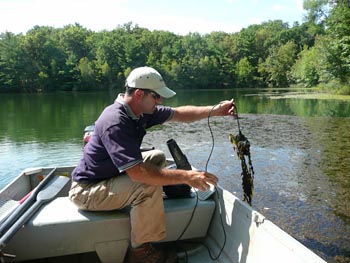 |
| September 2, 2008: ACT senior biologist Marc Bellaud pulls up his underwater video camera, along with a clump of bladderwort, in Dug Pond. The mat of floating bladderwort next to the boat doesn't appeal to some residents, but it's a native species that most biologists regard as just part of the natural ecosystem. |
Bellaud's survey this month - conducted at the same time of the year as the 2005 study - was commissioned by the Corporation to yield a systematic view of Pond vegetation in the wake of all these treatments.
There were two key questions the survey was designed to answer: What are the enduring effects of these treatments, and will another treatment be needed in 2009?
The answers came up in each sample that Bellaud raked from the bottom, along with his careful observations from the surface and through an underwater video camera. He found a few pockets of fanwort concentrated in widely spread colonies - notably, the mouth of Mill Reservoir, and in two coves at opposite ends of the Main Pond - as well as isolated sprigs in various locations, but there is far too little fanwort anywhere in Foster's Pond to warrant treatment next year.
Since at least two of the fanwort colonies had been observed last fall - triggering the Corporation's concern that it would be prudent to undertake a systematic survey this year - Bellaud was astonished that the weed had not spread further. Indeed, the colonies seemed a bit smaller than they had appeared last year.
Bellaud had a theory. High water levels, coupled with algae in the water that is blocking sunlight to the bottom, may have suppressed the spread of fanwort. And last year's use of pelletized Sonar - slow-release bits of Sonar-infused clay resting on the bottom - may have prolonged the fanwort's exposure to the herbicide, completely killing the root systems and preventing fragments from re-establishing a foot-hold.
Whatever the reason, the results could not be more stark - or more welcome. To the delight of many Pond users, water lilies - which are native, and which are also susceptible to Sonar - have disappeared from much of the Channel, as well as from the passage between the Main Pond and the Mill Reservoir, leaving wide open expanses the likes of which haven't been seen in decades. In 2008, for the first time in years, shoreline property-owners in the Channel saw no reason to call in the hydro-rake. There are too few lilies to bother with.
Native species that are not considered pests have repopulated some areas of the Pond formerly dominated by fanwort.
Some residents have been put off by the appearance of large, brown floating mats in Dug Pond, but Bellaud said that they are composed of bladderwort, a native plant whose tiny "bladders" allow it to float on the surface. It is not usually regarded as a nuisance weed, and is not normally treated, though it can easily be cleared from the surface by hand raking if anyone has the energy or inclination.
Bellaud's detailed written report on the survey is expected before the end of the year.
Report: Channel Is Fanwort-Free, But Not Main Pond
December, 2007
The 2007 Sonar treatment of 18 acres of Foster's Pond left no traces of fanwort in its wake.
The persistent, non-native weed - which by 2004 had become the dominant plant in the Pond - had all but vanished after the entire Pond was treated in 2005, but re-emerged by the end of 2006 in shallows from the dam through the Channel, and between the Mill Reservoir and the Main Pond.
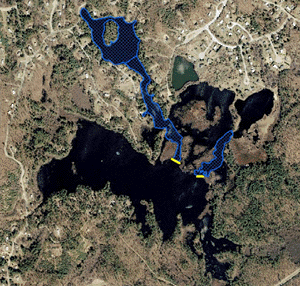 |
| The 2007 treatment area (in blue) totaled 18 acres. Water-impermeable barriers (in yellow) kept the Sonar from dissipating in the Main Pond. Click on the image above for a larger view. |
It was those areas that the Corporation zapped in 2007, this time using a pelletized formulation of the slow-acting herbicide, which concentrated the treatment at the roots of plants which had evidently survived the 2005 treatment. Water-impermeable barriers kept the chemical in the treatment area and out of the Main Pond, where the Sonar would have quickly been diluted and where no new fanwort had been observed. Until this year.
In an October inspection that covered both the treatment area and the rest of the Pond, the Corporation's lake management contractor - Aquatic Control Technology, Inc. - found no fanwort in the northerly half of the Pond, but in several locations along the western, southern, and southeastern shorelines of the Main Pond.
ACT delivered a written report on its findings to the Corporation in December. (To read the full text, click here.) The report states, "The extent and distribution of this fanwort regrowth suggests that it is regrowing from stem and/or root tissue that was not completely controlled following the 2005 treatment."
The report identifies two five-acre areas - at each end of the Main Pond - where most of the new fanwort is growing, though the actual extent of fanwort within those areas is only an acre each. Isolated stands of fanwort were detected elsewhere along the shore, and their locations were plotted by GPS on a map included in the report.
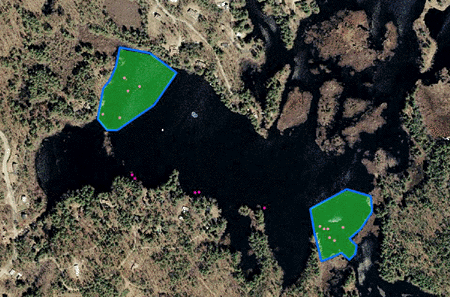 |
| The purple dots are GPS locations of fanwort colonies observed by ACT in October. Most of the fanwort was growing within the 5-acre areas shaded green, although the total fanwort coverage was estimated at 1 acre in each zone. Click the image above for a larger view. |
ACT recommended monitoring the fanwort, rather than attempting to treat it, in 2008. "Our experience treating small portions of large, open-water basins with Sonar pellets at other lakes have been largely disappointing," wrote ACT's senior biologist Marc Bellaud.
"For the 2008 season, we would recommend monitoring the fanwort growth in the Main Pond and educating FPC members, lake residents, and lake users to avoid excessive disturbance in areas of heavy fanwort growth (to the extent that is practical) to help minimize fragmentation," wrote Bellaud.
Bellaud also recommended a late-summer survey of weeds in the Pond to monitor expansion of fanwort - and see what is happening in areas treated in 2006 and 2007. The FPC's Board of Directors intends to implement this recommendation in 2008.
One possible outcome: another treatment in 2009. Whether a treatment will be needed, and where, will depend on how fast the fanwort spreads, and whether it gets back into portions of the Pond which are now fanwort-free.
Despite the persistence of the fanwort, one thing is certain. There is far less of it, and it covers far less area, than before control measures were instituted in 2005. Residents along the Channel have marveled all summer at the absence of the weeds which used to clog the area, and anglers have exulted at the areas now accessible for fishing. And the raft in the Main Pond has never, in recent memory, had a busier or more weed-free swim season.
Channel Gets 2d "Booster" Treatment
July, 2007
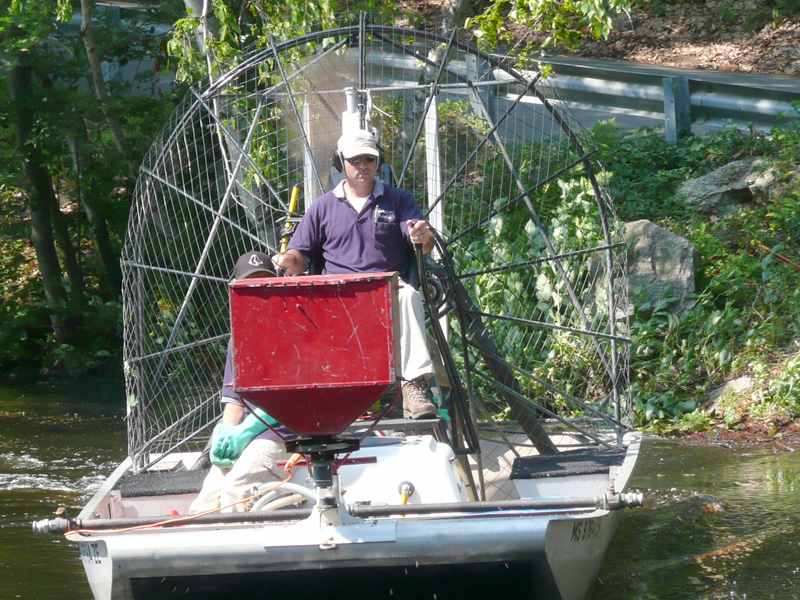 |
| July 27: Marc Bellaud, senior biologist from Aquatic Control Technology, guides the airboat past the dam. |
For the third - and most likely the final - time this summer, the roar of the airboat reverberated across the Pond, as technicians applied another dose of Sonar herbicide to nuisance vegetation in an 18-acre treatment area. It took about an hour for the powerful craft to zoom in and out of coves from the dam to the two temporary barriers near the Main Pond that were put in place earlier this year to keep the chemical from dissipating into the larger basin.
As the boat followed its winding route, a spreader on the bow broadcast tiny herbicide-infused clay pellets - about the size of a grain of rice - into the water. As the pellets break down, they release the chemical. The idea is to maintain a steady concentration of the slow-acting herbicide.
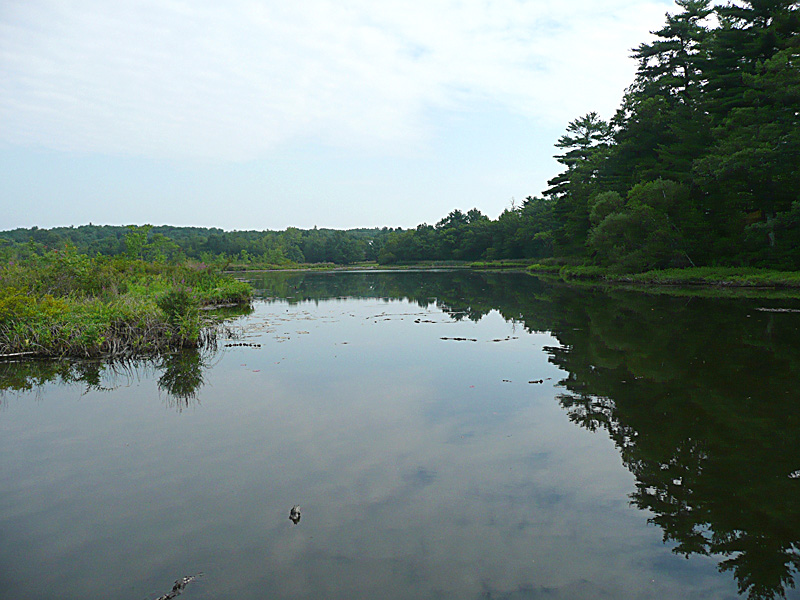 |
| July 27: Nuisance weeds, including lilies, have nearly vanished from the channel between the Main Pond and the Mill Reservoir. |
The treatment is showing dramatic results. The primary target, fanwort, would have clogged the Channel with bright green mats by now; instead, the stunted plants are visible a foot below the surface, their tips a sickly pale color, and stems already beginning to decay. Water lilies have almost vanished from much of the treatment area, leaving vast expanses of open water. The native lilies, however, are expected to rebound.
Weed Treatment Is Working Wonders
July, 2007
If you live on the Channel, or have been fishing from the dam, you already know this. This year's weed treatment has reduced nuisance weeds to barely-noticeable stands of sickly stubble, leaving the 18-acre treatment area astonishingly clear.
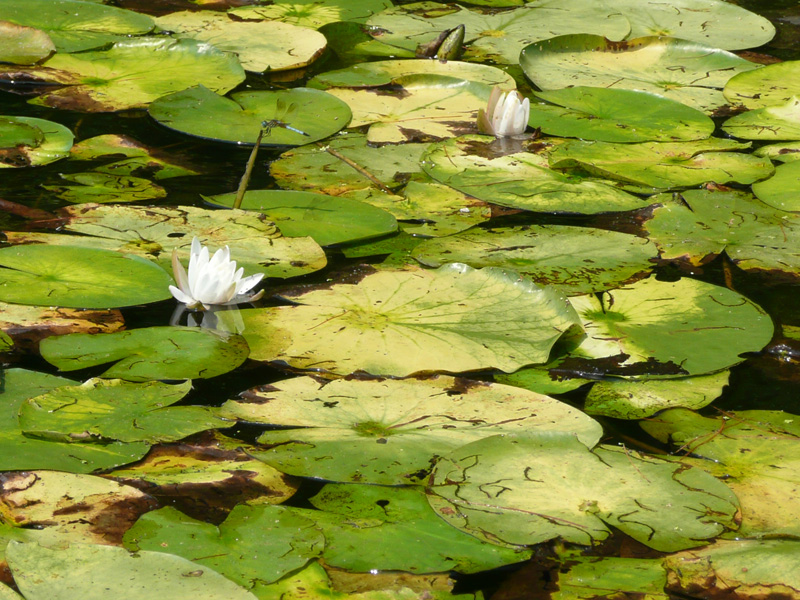 |
| July 15: Lilies in the treatment area showing signs of "chlorosis." Although they're not the target of the weed treatment, residents are delighted that dense stands are thinning out, even if the effect will be temporary. |
Fanwort, which is the Pond's most dangerous invader, would have exploded by now into impenetrable mats clogging much of the Channel - a condition with which residents and visiting anglers were all too familiar before the 2005 treatment of the entire Pond. That treatment virtually eliminated the non-native weed, but significant stands began to re-emerge late last summer.
This year's partial-lake treatment, designed to beat back the weeds before they could take over the entire Pond again, has left them reeling. Sonar, the slow-acting herbicide used in the treatment, renders the plants vulnerable to a process called "chlorosis" - bleaching of their chlorophyll, leaving the plants unable to produce nutrients. Now, a foot or more beneath the surface, it is possible to see hundreds of fanwort plants, their normally bright-green tips a sickly shade of pale, their remaining leaves brown and dying.
Pond lilies, too, are taking a hit - much to the delight of residents who prefer the lilies in lesser densities. The lilies, which are native, will rebound after the treatment, as will other indigenous plants.
Fanwort Shows Signs of Fading
June, 2007
We may not know what happened to Tony Soprano, but the handwriting is on the wall for fanwort in the Channel.
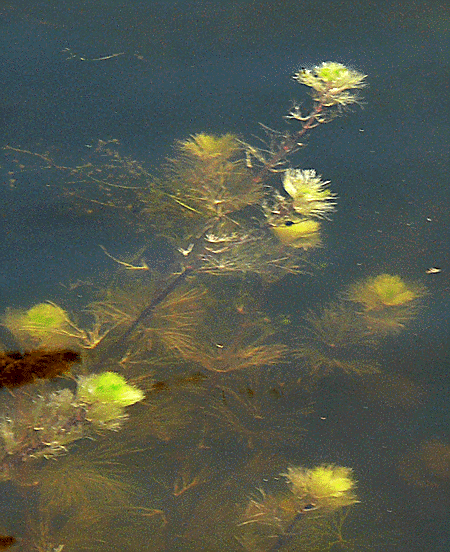 |
| June 25: Fanwort near the dam begins to show signs of "chlorosis." The tips have started to bleach out as a result of the herbicide treatment. |
A little more than three weeks after treating 18 acres of the Pond with a slow-acting herbicide, Aquatic Control Technology's senior biologist Marc Bellaud pointed to the tell-tale signs that the nuisance weeds are beginning to succumb. The tips of the feathery plants, normally bright green in healthy specimens, are starting to bleach out to a pinkish white.
Bellaud and an assistant were back on the Pond June 25 to administer a second dose of the herbicide. The initial treatment was applied June 1.
Fanwort is a non-native aquatic weed that had become the dominant plant in the Pond until the Foster's Pond Corporation had the entire 120-acre water body treated two years ago. Some of the oldest plants, with their basketball-sized root structures, apparently survived that assault, and this year the Corporation is treating only the areas where the fanwort came back.
ACT, the Corporation's lake management consultant, uses fluridone (sold under the brand name Sonar) to kill fanwort. That is the only effective method allowed by environmental authorities in Massachusetts. It is also the least toxic aquatic herbicide that is permitted in the State's lakes and ponds. Sonar does not migrate through soil, does not bioaccumulate in wildlife, and has a short half-life. At the concentrations employed in Foster's Pond, it is allowed in the State's public drinking water reservoirs right up to the intake pipe.
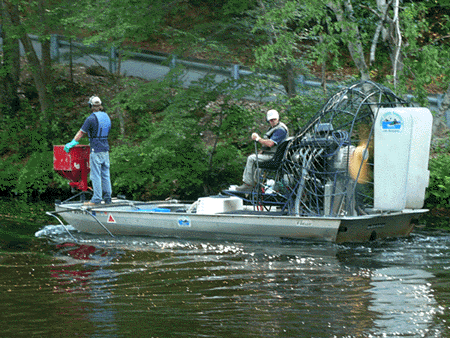 |
| June 25: The airboat makes the turn at the Foster's Pond Dam. The red spreader at the bow is dispersing Sonar-infused pellets, while hoses trailing along the side are infusing liquid Sonar into the water. |
Sonar works by blocking the plant's production of yellow pigments which protect chlorophyll from breaking down in sunlight. Without the yellow pigments, the chlorophyll bleaches out, the plant can't produce the food it needs, and it dies. The process is called "chlorosis," and it takes at least 6 to 8 weeks to kill the plant. Biologists regard the slowness of the process as a good thing, since a more rapid die-off would run the risk of depleting oxygen in the Pond.
Fanwort is particularly susceptible to the low concentrations - 10 to 20 parts per billion - used for the weed treatment. Native plants are hardier, although they do thin out as a result of the treatment. The effects are quite noticeable on the Pond's lilies, though many residents welcome a reduction in lily density. The lilies rebound in a year or two.
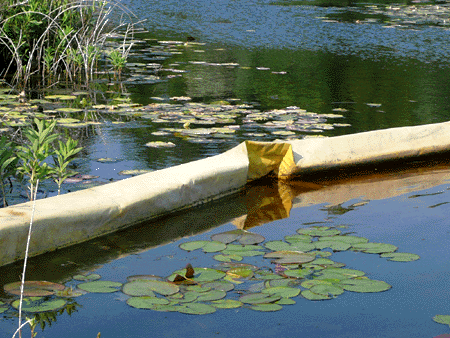 |
| June 25: Two barriers have been set to keep Sonar in the treatment area. At this barrier, between the Main Pond and the channel leading to Mill Reservoir, the herbicide is starting to trigger chlorosis in lilies within in the treated area, while those outside the target zone remain bright green. |
The June 25 "booster" treatment once again made use of one of ACT's airboats. Two formulations of Sonar were used in the booster treatment. Sonar-infused clay pellets were broadcast from a bow-mounted spreader, while liquid Sonar was pumped directly into the water through submerged hoses trailing from either side of the fast-moving craft. The liquid Sonar was used to quickly restore the Pond's herbicide concentration to the level lethal for fanwort, while the pellets will exude Sonar slowly over a longer period, maintaining the concentration at a steady level.
Before the operation began, the Pond was posted to keep swimmers, boaters, and anglers out of harm's way while the airboat was maneuvering around the treatment area.
The water will be tested in about three weeks to see whether the necessary concentration remains in the Pond. That will be dependent on weather conditions, which can affect both outflow of the chemical and how rapidly it breaks down. Another booster treatment may be needed next month.
First "Booster" Treatment Scheduled for June 25
June, 2007
The airboat will return to the Pond June 25 to administer a second dose of Sonar to the 18-acre section targeted for weed treatment this year.
The treated portions of the Pond will be closed to fishing, boating and swimming for the day. The closure is a safety precaution to give the fast-moving craft plenty of room to maneuver in the Pond's narrow coves.
The Pond received its initial treatment on June 1. The June 25 "booster" is the first of two or possibly three repeat treatments aimed at keeping the herbicide concentration high enough to kill fanwort, the non-native weed which once dominated the Pond. Sonar is the brand name of the herbicide (fluridone) being used in the treatment.
Weed Treatment is a (Noisy) Breeze
June, 2007
Treating 18 acres of Foster's Pond with herbicide is a breeze - if you happen to have an airboat. It took little more than half an hour on June 1 for technicians to spray tiny clay pellets over about 15 per cent of the Pond targeted for treatment by the Foster's Pond Corporation this year.
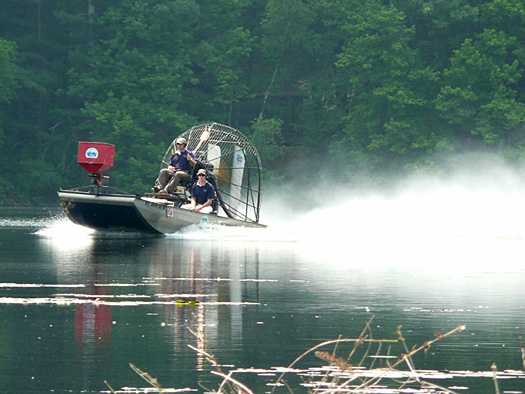 |
| June 1: Airboat, with red cyclone spreader at the bow, skims over the Main Pond on its way to the treatment area. |
First, however, they had to wrestle a pair of temporary "limno-barriers" into place. The cloth barriers, anchored to the bottom with concrete blocks and held up by bright yellow flotation collars, are needed to keep the herbicide from dissipating into the Main Pond. One barrier blocks the channel from the Main Pond to Mill Reservoir; the other, which has a small gap at one end to allow boats to pass freely, extends across the passage from the Channel to the Main Pond.
It took two hours in muggy near-90 temperatures under a blazing sun to get the barriers in place. The rest of the job was easy.
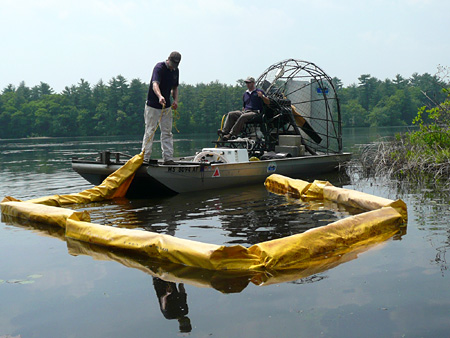 |
| ACT technicians begin to stretch a "limno-barrier" across the passage between the Main Pond and the Mill Reservoir. The temporary barrier is intended to keep the herbicide concentrated in the treated passage. |
Sporting a bow-mounted spreader to distribute thousands of tiny, herbicide-laden pellets, the airboat - the same kind that is a common sight in the Everglades - careened noisily down the Channel and around Rock Island, then circled past the dam. Those on board wear earmuffs to drown the sound. The roar never fails to bring residents down to the shore for the rare spectacle of such a powerful craft churning up a cloud of spray in its wake.
The target of all this commotion is fanwort, a nonnative invasive weed which practically took over the Pond until a 2005 herbicidal treatment nearly eradicated it. Adjacent "Dug Pond" was treated last year, and the entire watershed remained almost fanwort-free until late last summer. That's when pockets of the persistent nuisance were observed by the Corporation's volunteer "weed-watchers."
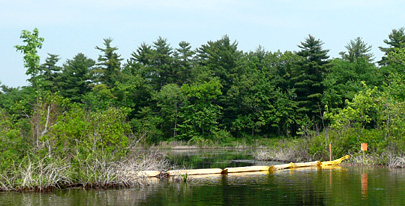 |
| Barrier across the passage between the Mill Reservoir and the Main Pond. View is from the Main Pond, looking towards the Mill Reservoir. Goldsmith reservation is in the background. |
A more formal assessment in September by the Corporation's lake management consultant, Aquatic Control Technology, picked up the presence of fanwort in much of the outlet cove (near the dam), the Channel, and the passage between the Mill Reservoir and the Main Pond. No fanwort was found in either the Mill Reservoir or the Main Pond, and the decision was made to undertake a "spot treatment" this year, hitting just the areas where the fanwort had survived from the 2005 effort. ACT experts theorized that the surviving plants were the oldest in the Pond, and their basketball-sized root structures had likely not been completely killed by the 2005 treatment.
This year's treatment is using the same herbicide - fluridone, which is sold under the brand name Sonar - that was employed in 2005.
 |
| Temporary barrier across the passage from the Main Pond to the Channel, as viewed from the Main Pond. Orange signs to the right mark a gap between the shore and the floatation collar, which will allow boats to pass easily. |
The slow-acting chemical is the only herbicide authorized for use in Massachusetts waters which works on fanwort. Fortunately, it is also the least toxic herbicide that can be used here against aquatic nuisance vegetation. At the concentrations approved for the Foster's Pond program - 10 to 20 parts per billion - it can be used in public water reservoirs right up to the intake pipe. It does not migrate through soils, and it does not bioaccumulate in fish or wildlife. It also has a short half-life.
But instead of using only liquid Sonar, as in 2005, the formulation used this year will consist mostly of Sonar-infused clay pellets. They sink to the bottom and dissolve slowly, so a higher concentration is delivered to the fanwort at its roots. The aim is to get the plants to absorb more of the herbicide so that the entire root structures die.
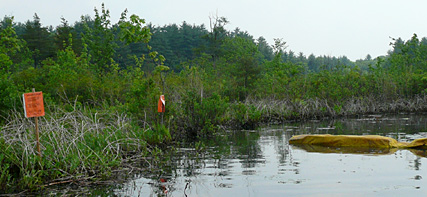 |
| Approaching the temporary barrier from the Channel, the gap is on the left. Canoes, kayaks, and bass boats should have no problem getting through - at least, under current conditions. |
Sonar works by blocking the plants' production of yellow pigments which protect chlorophyll from breaking down under sunlight. Without the yellow pigments, the plants slowly bleach out and die. The process (called "chlorosis") can take upwards of 6 to 8 weeks - an advantage, since the slow dying avoids the prospect of sudden oxygen depletion (which could result in fish kills) or nutrient release (which could result in algae blooms).
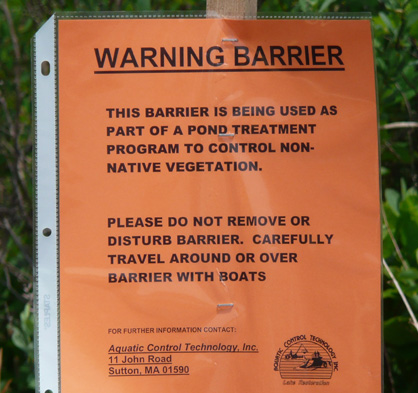 |
| Signs at each of the temporary barriers ask boaters to pass through carefully. |
The slowness of the process means that the effective 10-20 ppb concentration must be maintained in the water over a period of several weeks. Since the Sonar has a short half-life (about 21 days), one or two "booster treatments" are usually needed. That means the airboat will be back on the Pond, probably by the end of June.
The flotation collars on the limno-barriers should prove to be a minor nuisance to canoers and kayakers. The gap at one end of the barrier between the Channel and the Main Pond makes the passage easy, even for a bass boat with an electric motor. The barrier between the Main Pond and the Mill Reservoir, however, takes a bit more effort. There are flattened segments, about a foot wide, every four feet or so, and these present the easiest places to surmount the obstacle. But it still takes a bit of poling to get over - and it helps to reach over both sides at once and pull the canoe or kayak across. Bass boats may find it impossible to get between the Mill Reservoir and the Main Pond until the barrier comes out in September.
Fanwort's Up; Treatment Set for June 1
May, 2007
"There's a patch," said Marc Bellaud, pointing through the Pond's clear water to a half-dozen day-glo-green shoots of fanwort two feet below the surface.
 |
| May 23: ACT Senior Biologist Marc Bellaud examines a sprig of fanwort raked from the bottom of the Channel. |
Bellaud, senior biologist for Aquatic Control Technology, was seated in a small motorboat, plotting locations with his hand-held GPS in the run-up to this year's first herbicidal treatment of the Pond's nuisance weeds. His conclusion: The fanwort is nearing the most vulnerable point in its growth cycle, and treatment should start.
On June 1, ACT - the Corporation's lake management consultant - will launch an airboat onto the Pond, spraying herbicide-infused clay pellets on 18 of the Pond's 120 acres. The targeted areas will be closed to fishing, boating and swimming for the day, to give the fast-moving craft unimpeded room to maneuver.
The treatment areas include the outlet cove (from the dam to Rock Island), the Channel (from Rock Island all the way to the Main Pond), and the channel between the Main Pond and Mill Reservoir.
Bellaud inspected the Pond's vegetation May 23 with FPC President Steve Cotton, focusing on these "hot spots," which had been identified last fall for treatment this summer.
Bellaud, using an underwater camera and occasionally tossing out a rake to bring up samples from the bottom, found shoots of fanwort just where he expected to, concentrated in the targeted treatment areas in the Channel and in the passage between the Main Pond and the Mill Reservoir. As had been the case last fall, none was observed within either the Mill Reservoir or the Main Pond.
Fanwort is a persistent and fast-growing invader that had become the Pond's dominant plant for decades. In 2005, the Corporation, after months of study and public hearings, treated the Pond's entire 120 acres and nearly eradicated the unwelcome guest, which had choked much of the Pond to the detriment of fishing, boating, and swimming. Left untreated, a lake can become so clogged with the stuff that fish die.
Although the Pond remained practically fanwort-free during 2005 and much of 2006, by fall of last year it had re-emerged in several areas. ACT theorized that these were stands of the oldest plants, whose basketball-sized root structures had not been completely killed by the 2005 treatment.
The use of pelletized herbicide is aimed, quite literally, at the roots of the Pond's fanwort problem. The 2005 treatment used liquid Sonar (the brand name for fluridone, the only aquatic herbicide that can be used in Massachusetts to combat fanwort), which readily disperses through the water. Sonar, a slow-acting herbicide which renders submerged plants vulnerable to the bleaching effects of sunlight, must be maintained at concentrations of between 10 to 20 parts per billion for 60 to 90 days in order to do its job. The clay pellets, infused with Sonar, sink to the bottom and dissolve slowly, releasing the herbicide over an extended period - and close to the roots. The aim is to concentrate the Sonar as near as possible to the root balls of the hardy plants which survived the 2005 treatment.
Sonar is expensive. That's one reason the Corporation opted to target this year only the 18 acres where fanwort was detected. The 2005 treatment cost nearly $50,000, and this year's treatment of only 15 per cent of the pond will cost more than $16,000.
But treating only part of a pond is tricky. Sonar is not easily contained within a water body. ACT will install temporary barriers at two points - where treated channels meet the Main Pond - in an effort to keep the Sonar from dissipating into the much larger basin where it is not needed. The cloth "limno-barriers" will be anchored at each end and suspended from flotation collars. Canoes and kayaks can pass over the barriers; just push the floats down on each side of the craft and paddle over them. A gap will be left at one end of the barrier spanning the passage which connects the Channel to the Main Pond; that will allow bass boats with electric motors to get through, though they may have to be poled through the reeds.
Notices of the treatment schedule were mailed May 29 to shoreline owners of property abutting the treatment areas. The notices warn that Pond water should not be used for irrigation until September 1. The reason should be obvious: spraying treated water directly onto a tender garden plant or a lawn could set in motion the same process which kills the fanwort.
At the concentration that will be used in the Pond, Sonar has been approved by State and Federal regulators for use in municipal water reservoirs right up to the intake pipe. No one draws drinking water directly from Foster's Pond, but the Corporation wanted to be sure that the minimal necessary concentration was used.
With $ Coming In, FPC Board OKs Weed Contract
May, 2007
The Foster's Pond Corporation Board has voted to proceed with a contract to treat parts of the Pond with Sonar this Spring. The vote came at an April 23 meeting, after Treasurer Dave Brown and Fundraising Committee Chairman Marty Rabinowitz reported that fundraising efforts are on track to cover the $16,150 cost of applying the herbicide.
A biologist from Aquatic Control Technology, the Corporation's lake management consultant, is expected to visit the Pond later this month to determine the best time to administer the treatment. Sonar is the brand name for a chemical called fluridone, which is the only effective way of combating the fanwort, the non-native nuisance weed that had clogged the Pond for years until it was nearly eliminated by a Sonar treatment in 2005. It has come back in about 15% of the Pond, and this year's treatment program will target the affected areas.
Sonar works best when the plant begins its seasonal growth, usually in late May or early June. The treatment will employ a pelletized formulation of the herbicide. The Pond will close for swimming, boating and fishing the day of treatment, but will re-open the following day. Two or three treatments are anticipated to keep the proper concentration in the Pond.
Conservation Commission Approves '07 Sonar Plan
March, 2007
The Andover Conservation Commission has unanimously approved the Foster's Pond Corporation's plan to treat part of the Pond with Sonar this Spring.
The vote came at a Conservation Commission meeting on March 6. Andover Conservation Director Bob Douglas recommended approval of the plan, which was submitted to the Commission by the Corporation on February 15. With little discussion, the Commission promptly gave its okay. The Commission has a history of supporting the Corporation's efforts to combat invasive weeds in the Pond.
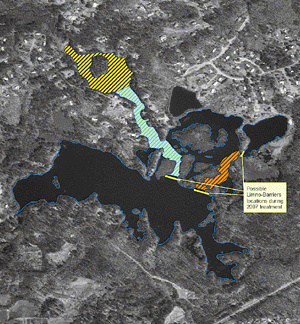 |
| Most of the Pond stayed fanwort-free in 2006. About 18 acres - 15% of the Pond, where fanwort was spotted - are slated for Sonar treatment this year. Click the image for a larger version. |
The 2007 treatment plan, developed by the Corporation's lake management consultant Aquatic Control Technology, calls for the application of fluridone - an aquatic herbicide sold under the brand name "Sonar" - to 18 acres of Foster's Pond beginning in mid-May or early June. The plan was endorsed by the Corporation's Weed Committee, approved by the Board of Directors, and presented to the Annual Meeting in January.
The areas to be treated - about 15% of the Pond's 120 acres - were found late last Summer to have experienced regrowth of fanwort, the nonnative invader that had virtually taken over the Pond until the Corporation's 2005 treatment nearly eradicated it. Inspections by volunteer "weed watchers" last August, followed by a more systematic survey by ACT in September, turned up no fanwort throughout most of the Pond but extensive stands - including a few spots with dense mats - were found in limited areas. The infested areas extended from the dam through the entire Channel, as well as the channel between the Mill Reservoir and the Main Pond.
ACT's senior biologist Marc Bellaud theorized that the infested areas, which are only 3-4 feet deep with thick sediments on the bottom, had probably harbored the oldest fanwort plants, whose large root structures - clumps that can grow to the size of basketballs - had not been fully killed by the 2005 treatment.
 |
| Fanwort in the Main Pond, before the 2005 Sonar treatment. |
Sonar is the only herbicide - indeed, the only effective control technique - approved by the State's Department of Environmental Protection for use on fanwort. It is the least toxic aquatic herbicide allowed in Massachusetts. According to information amassed by the State, it does not bioaccumulate in fish or wildlife, and does not migrate through soils. It has a short half-life - it quickly breaks down in sunlight - and so must be reinfused into the water in order to keep the concentration steady. Up to three treatments are expected during the 60 to 90 days it will take to kill the fanwort.
Sonar retards the growth of yellow pigments which protect the chlorophyll in submerged plants. Without those pigments, sunlight bleaches out the chlorophyll, and the plants die. This is a slow process - and that's a good thing, according to biologists. The slow die-off of the plants results in a lower drain on the water's oxygen than would occur if large masses of plants died suddenly.
Sonar is most effective if it is applied when fanwort is just emerging, usually around mid-May to June. ACT will inspect the Pond to determine the timing of the initial application. There is no mistaking the sprouting fanwort. It is a luminescent green, looking a bit like a test-tube brush.
Consultant Recommends '07 Treatment Plan for Fanwort
December, 2006
The Foster's Pond Corporation's lake management consultant, Aquatic Control Technology, has recommended a plan to treat part of the Pond with Sonar next Spring in an ongoing program to prevent invasive weeds from regaining a chokehold.
The plan is contained in ACT's 2006 Year-End Report on the herbicide treatment of Dug Pond, the Town-owned swimming hole adjacent to Foster's Pond treated this year to get rid of fanwort and another non-native weed, Brazilian elodea. Although
 |
| Fanwort in the Main Pond, before the 2005 Sonar treatment. |
ACT's post-treatment inspection of the 3.9-acre basin, which lies at the end of Glenwood Road, showed neither of the treated weeds appeared to have survived there, the news was not as good for the larger water body. A September 13 tour of Foster's Pond by ACT Senior Biologist Marc Bellaud turned up "robust fanwort growth" both "in the channel leading to Mill Reservoir and in the channel leading to the [dam]." No fanwort was found in the Mill Reservoir or in the Main Pond.
Bellaud presented his findings and recommendations to a joint meeting of the FPC Weed Committee, Fundraising Committee, and Board of Directors. He noted that the return of fanwort one year after an initial Sonar treatment is highly unusual, noting that most of the regrowth was found in shallow areas with thick bottom sediments. "The most logical explanation for regrowth in these areas is [that] they harbored the most mature fanwort plants prior to treatment and the herbicide treatment could not completely exhaust the starch reserves in their extensive root structures." Mature fanwort plants, he told the FPC group, have "amazingly large root balls," holding his hands as if he were cradling a basketball.
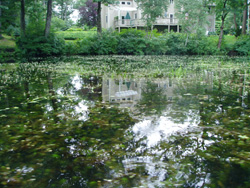 Fanwort in the channel, August 16, 2004 (above) and same location, August 5, 2005 (below)  |
The proposed plan calls for treating about half the Pond with time-release Sonar pellets, which sink to the bottom and release the herbicide over a period of several weeks. The dosage is calculated to achieve the same concentration as the 2005 treatment of the entire Pond - 10 to 20 ppb, a level which is lethal to fanwort but is approved even for use in public water supplies. The treated areas would be closed to swimming, boating and fishing on the day of treatment, but would be re-opened the following day. Three treatments would likely be needed. Bellaud proposed placing two or three impermeable "limnobarriers" - weighted fabrics suspended from flotation collars stretched across channels leading to Mill Reservoir and the Main Pond - to minimize dilution of Sonar in the treatment area. The barriers allow easy passage of canoes and kayaks.
Cost of the proposed treatment would be $16,150, about 38% of what it cost to treat the entire Pond in 2005. Under the proposal, about half the Pond would undergo treatment in 2007.
Prior to the 2005 Sonar treatment, fanwort had become the dominant plant in the Pond, even though it is not native to Massachusetts. It choked most of the Pond, leaving many areas unfit for swimming, fishing, or paddling. It has no natural enemies in the Northeast, and there is only one abatement method for large stands of it that is approved for use by State regulatory authorities - Sonar, a slow-acting herbicide which does not bioaccumulate in fish or wildlife and has proven less lethal on native plant species. The 2005 treatment left no detectable fanwort in the Pond that year, and left much of the Pond fanwort-free in 2006.
Final Report: Sonar KO'd "Dug Pond" Fanwort
November, 2006
Aquatic Control Technology has handed in its year-end report on the Foster Pond Corporation's 2006 weed management program. The conclusion: Sonar treatment of "Dug Pond" this summer was a success, leaving "no viable fanwort or Brazilian elodea" in the 3.9-acre swimming hole.
The four-page report, prepared by ACT senior biologist Marc Bellaud, was distributed at a joint meeting of the FPC's Weed Committee, Fundraising Committee, and Board of Directors on November 29. Bellaud was on hand to outline the findings and answer questions.
 |
| Dug Pond gets its first Sonar treatment June 5. |
Dug Pond, which is owned by the Town of Andover, is separated from Foster's Pond by a narrow berm, and flows into the larger water body. The FPC took on task of treating Dug Pond in order to eradicate the two non-native invasive weeds that had been found growing there. While Foster's Pond has been plagued by fanwort, Brazilian elodea was a new and potentially pesky nuisance.
ACT reported that three weeks after the initial treatment of Dug Pond in June, "both the fanwort and Brazilian elodea were showing strong evidence of chlorosis (whitening symptomatic of Sonar exposure)." A second treatment was performed on June 29. By early August, says the report, "both plants were nearly completely chlorotic." On September 13, when ACT did its final inspection, "no viable fanwort or Brazilian elodea were found in the Basin and the majority of these plants were decomposing on the pond bottom."
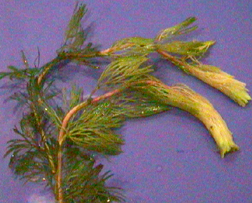 |
| Fanwort from Dug Pond June 19, showing signs of chlorosis. On untreated plants, the white tips would be bright green. |
The report indicates that white water lilies growing by the shoreline of Dug Pond were thinned by the herbicidal treatment but are expected to rebound in 2007. Other native plant species, including bladderwort and emergent pickerelweed and rushes, remained healthy, according to the report. The report states, "No adverse impact to fish or wildlife were observed following treatment."
Bellaud's report also discusses the re-emergence of fanwort in Foster's Pond, recommending that the Corporation undertake a partial-lake treatment of affected areas in 2007. The Board of Directors and the two committees will reconvene later this month to discuss this recommendation in advance of the Corporation's Annual Meeting on January 16.
Biologist: "Dug Pond" Treatment Is Complete
August, 2006
After reviewing the latest lab results and field reports, Aquatic Control Technology's senior biologist has determined that no further treatment is needed to kill fanwort in "Dug Pond".
Marc Bellaud informed FPC President Steve Cotton of his conclusion after consulting with field technicians who had inspected the 3.9-acre swimming hole on August 2 and found neither fanwort nor Brazilian elodea, the two nuisance weeds targeted by this year's Sonar treatment. The technicians also took a water sample to test the concentration of herbicide remaining in the basin, which is separated from Foster's Pond by a narrow berm.
Laboratory tests showed the Sonar concentration at 15 parts per billion - exactly midway in the target range of 10 to 20 ppb. A concentration of 10 ppb is adequate to kill fanwort; 20 ppb is the maximum allowable under the permit authorizing the FPC's weed treatment program.
With no nuisance weeds detected, and adequate levels of Sonar remaining to do in any sprouts that might have escaped notice, Bellaud concluded that there is no need for a further dose of the herbicide. The popular swimming hole has been treated twice this summer - initially on June 5, with a "booster treatment" on June 29.
"Dug Pond" Inspection Finds No Fanwort - But There's Some in the Channel
August, 2006
Technicians from Aquatic Control Technology took a slow tour of "Dug Pond" on August 2, looking for fanwort. Peering through the crystal-clear water, they found none of the pesky weed in the 3.9-acre basin. Earlier treatments with Sonar have apparently eliminated that and a second non-native invader, Brazilian elodea.
The technicians took a water sample, which will be sent to the lab to determine the concentration of Sonar remaining in the basin, which was last treated on June 29. Biologists at ACT will then decide whether the town-owned swimming hole requires a final booster shot of the herbicide.
But so far the results could hardly be better. The technicians reported excellent water clarity to the basin's full depth of 12.5 feet. From the shore, fish darting through the water could be seen as clearly as trout in a mountain stream.
The technicians also took a quick pass through the main Pond, where they reported finding fanwort in the channel and at the mouth of the Mill Reservoir. That is not such good news. The Corporation will seek more details from ACT, and discuss how to deal with the return of the weed.
"Dug Pond" Gets 2d Sonar Treatment
June, 2006
"Dug Pond" received a second dose of Sonar herbicide on June 29. Technicians from Aquatic Control Technology launched a small motorboat into the 3.9-acre Town-owned swimming hole at the end of Glenwood Road, taking about an hour to spray the basin.
 |
| Brazilian elodea taken from "Dug Pond" on June 29 showing signs that Sonar is killing the nuisance weed. Healthy plants are bright green, with no pink or white. |
The treatment came late in the afternoon, and although the two-man team arrived just after a heavy downpour had drenched the area, neighborhood kids were already back in the water. The kids had to cut short their fun, as the basin was closed to boating, fishing and swimming for the rest of the day.
The basin received it first treatment of the slow-acting weed-killer on June 5. Both fanwort and Brazilian elodea - the invasive aliens targeted by Corporation's weed-abatement program - are showing signs of ill-health. But Sonar, which has a short half-life, must be kept at concentration of between 10 and 20 parts per billion throughout a treatment period of 60 to 90 days in order to eradicate the weeds. That means applying "booster" doses once or twice during the Summer.
ACT senior biologist Marc Bellaud, who headed the treatment team, said he would return in about three weeks to assess progress. He said that if the fanwort and Brazilian elodea continue to succumb, a second booster treatment may be unnecessary.
Water from the treated basin should not be used to irrigate plants until September 6, since treated pond water could have the same lethal effect if sprayed on tender land plants.
"Weed Watchers" Train for Guard Duty
June, 2006
"We call this the 'Green Book'," said Michelle Robinson, passing out copies of a colorful pamphlet picturing on its cover a dense green mat of lily pads with a pair of cheerful yellow flowers. "It's a lot easier to remember than the full name."
 |
| Michelle Robinson (standing) gives pointers to Foster's Pond residents Kenny Tamarkin and Dick Tyler. |
That would be A Guide to Selected Invasive Non-native Aquatic Species in Massachusetts, and Robinson - an expert on the subject employed by the Department of Conservation and Recreation's Lakes and Pond Program - had come to Andover to train volunteers from the Foster's Pond community on how to identify them.
Nine area residents spent two hours in the cafeteria of South School, gently spreading the leaves of two dozen dripping specimens, holding them up to the light to look for leaf arrangements, serrations, and bladders, as Robinson guided them through the terminology and techniques of plant identification.
 |
| (L. to r.) Becci Backman, Amy Janovsky, and Lydia Cardin learn identification techniques from Michelle Robinson. |
The idea of the State "Weed Watchers" program - and the reason the Foster's Pond Corporation organized the June 19 training session - is that residents who are frequently out on a pond can be the first line of defense if they recognize a new invasive species or the re-emergence of a pest that's been around for awhile. But they need to know what to look for.
The "Green Book" is like an aquatic version of the FBI's 10-most-wanted list. After giving her students plenty of time to practice identification techniques on a range of native and non-native plants - including specimens one participant had plucked from Foster's Pond earlier in the day - Robinson rounded up examples of some of the worst offenders for what amounted to a watery "perp walk" of villainous weeds.
 |
| Fanwort taken from Dug Pond June 19, showing signs of chlorosis. On untreated plants, those white tips would be bright green. |
There was good news and bad news in the display. The good news: Sprigs of fanwort from "Dug Pond," were already showing signs of chlorosis, the bleaching effect caused by the Sonar herbicide with which the basin was treated just two weeks earlier. And more good news: The specimens of variable milfoil and Eurasian milfoil had come from another pond. Neither of these dreaded aliens has been found in Foster's Pond.
But there was some bad news, as well. One of the samples taken from Foster's Pond turned out to be curly-leaved pondweed (Potamogeton crispus), a species that had escaped detection in surveys conducted in August 2004 and September 2005.
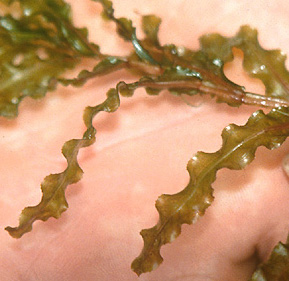 |
| ©2001 Univ. Florida Bad news: Curly-leaved pondweed was found in Foster's Pond on June 19 |
The reason no curly-leaved pondweed showed up on the biologist's rake in the earlier surveys is that both were done in late summer, and this type of pondweed has a unique growing pattern. The plant grows early and quickly, dropping seeds by late spring or early summer, then dying back by July. The seeds sprout in the fall, with the small plants emerging in September, wintering over when ice forms, then putting on a growth spurt when the water warms. Sonar kills curly-leaved pondweed, but last year's treatment obviously did not result in complete eradication.
"Dug Pond" Receives Treatment for Nuisance Weeds
June, 2006
"Dug Pond" got a dose of the Foster's Pond Corporation weed program, as technicians sprayed the Town-owned swimming hole with a slow-acting herbicide on June 5.
After months of hearings, planning, and fundraising, the treatment process caused barely a ripple in the 3.9-acre basin at the end of Glenwood Road.
Biologist Keith Gazaille rowed an 8' aluminum boat across the glassy waters of the basin, as his youthful assistant
 |
| Technicians spray a dilute solution of Sonar into Dug Pond. |
Steve Metzger aimed the nozzle of a power sprayer which sent a wispy arc of the diluted solution 30' off the stern. They crisscrossed the small, tree-ringed cove for about an hour.
Gazaille and Metzger are employed by Aquatic Control Technology, the lake management company hired by the FPC to implement a nuisance weed control program in Foster's Pond. The Dug Pond treatment used the same herbicide - Sonar, the trade name for fluridone - that last year was applied in the main pond to combat fanwort. Dug Pond, which is separated from the main pond by a narrow berm, was not treated last year, but later inspection found both fanwort and another nonnative invasive weed, Brazilian elodea, growing in the smaller basin, and Sonar is effective against both.
Indeed, Sonar is the only proven antidote to fanwort that environmental authorities allow in Massachusetts. It kills submerged aquatic plants by blocking their formation of carotene, which protects the plants' chlorophyll from degrading in sunlight. As the chlorophyll bleaches out, the plant dies - usually over a period of 30 to 90 days. The bleaching process is known as chlorosis.
Sonar is effective at a very low concentration - 10 to 20 parts per billion. At that level, it is allowed in public drinking water reservoirs. That was the concentration Gazaille was aiming for, and the dose sprayed into Dug Pond was calibrated on the basis of depth soundings, from which the basin's volume was calculated.
Prior to beginning the treatment, Gazaille and Metzger posted orange notices closing the basin to swimming, boating and fishing for the rest of the day. Water from the basin should not be used for irrigation for the next 90 days.
Sonar has a short half-life, breaking down quickly in sunlight. Gazaille will return to Dug Pond in a week or ten days to take water samples, which will be tested to determine the Sonar concentration remaining in the basin. As the concentration declines to 10 ppb, the basin will receive a booster treatment. One or two such boosters are likely to be needed during the 90-day treatment period.
"Dug Pond" Treatment Scheduled for June 5
May, 2006
Treatment of weeds in "Dug Pond" has been scheduled for June 5. The 3.9-acre basin will be closed for swimming, boating and fishing for the day, but will re-open June 6.
Technicians from Aquatic Control Technology, the lake management company hired by the Foster's Pond Corporation to combat nuisance weeds in Foster's Pond, will launch a 12-foot motorboat into Dug Pond on Monday morning, using a combination of pelletized and liquid Sonar to kill nonnative weeds in the popular swimming hole.
 |
| June 2005: Fanwort fades after 1st Sonar treatment in main pond |
The pellets will be scattered across the basin using a blower, while the liquid will be sprayed on the surface. Sonar (the brand name for fluridone) kills submerged aquatic plants by blocking their formation of carotene, which protects the plants' chlorophyll from degrading in sunlight. As the chlorophyll bleaches out, the plant is unable to produce carbohydrates, and it dies - usually over a period of 30 to 90 days. Biologists regard the slow rate of die-off as a benefit of fluridone, minimizing the risk that decaying plants will deplete oxygen in the water.
A key to the success of a Sonar treatment is keeping the proper concentration in the water over an extended period. The target concentration is between 10 and 20 parts per billion - a level sufficient to kill the target plant species but regarded by State and Federal regulators as safe even for public drinking water supplies.
Sonar has a short half-life, degrading in sunlight. So samples will be taken from Dug Pond every couple of weeks to see if "booster treatments" are needed to maintain a concentration that will kill the weeds. One or two "booster" treatments are anticipated. Heavy rains could also affect the need for "boosters" - especially if the water level in "Dug Pond" rises high enough for water (and some Sonar) to spill out into the main pond. As of May 29, water in "Dug Pond" was lapping at the top of the narrow berm which separates the small Town-owned basin from the main pond, but there was no perceptible flow.
June 19 "Weed Watchers" Class Is Almost Full
May, 2006
Become a "Weed Watcher"! It's one way you can help protect Foster's Pond from prematurely succumbing to a resurgence of fanwort - or any other nonnative nuisance weed seeking to take up residence here.
The Corporation is sponsoring a free class for volunteers on June 19 from 7 - 9 p.m. To sign up, and get the location, e-mail info@fosterspond.org. But don't wait too long! The training is limited to 15 participants, and the class is filling fast.
The class will be conducted by staff from the Massachusetts Department of Conservation's Lakes & Ponds Program, which encourages local pond associations to train members in weed identification and conduct regular monitoring. If small infestations are detected in time, there are low-cost, environmentally friendly eradication techniques that can reduce the need to resort to expensive herbicide treatments.
So sign up - and bring in your own sample of any weed you've found in the Pond! For a more detailed description of the State's Weed Watchers Program, visit the DCR web site.
FPC Signs Contract for "Dug Pond" Weed Treatment
May, 2006
The contract has been inked; the permits are all in place; and the weeds have started to grow. Now it's up to the biologists to set the date for applying Sonar, the slow-acting herbicide which will kill nonnative aquatic nuisances just beginning to emerge from the sediments of "Dug Pond."
Two biologists from Aquatic Control Technology, the lake management company which treated Foster's Pond last year and will apply the same chemical to near-by "Dug Pond", inspected the 3.9-acre basin on May 12. They reported finding that both target species - fanwort and Brazilian elodea - are actively growing but are "very small."
The first treatment has not yet been scheduled but will likely take place later this month or in early June. May's torrential rains and flood conditions are not helpful, as the key to a successful Sonar treatment is to keep a steady concentration over a period of at least 60 days - not easy to do if Mother Nature is diluting the mix.
"Dug Pond" is owned by the Town of Andover. The Foster's Pond Corporation has raised the $5,750 it will take to treat the popular swimming hole, which is separated from the rest of Foster's Pond by a narrow berm and flows into the larger water body. FPC President Steve Cotton signed the treatment contract with Aquatic Control Technology May 16.
Fund Drive Tops Goal; Look Out, Weeds!
May, 2006
With donations from area residents totaling more than $7,000, the Foster's Pond Corporation has made the formal decision to undertake the treatment of "Dug Pond" with Sonar this summer.
 The FPC Board of Directors voted unanimously May 7 to contract with Aquatic Control Technology (ACT) to apply the herbicide to the 3.9-acre basin on Glenwood Road.
Last year, ACT - the Corporation's long-time lake management consultant - found infestations of two invasive weeds, fanwort and Brazilian elodea, in the popular swimming hole, which is separated from the rest of Foster's Pond by a narrow berm. The cost of the treatment will be $5,750.
The FPC Board of Directors voted unanimously May 7 to contract with Aquatic Control Technology (ACT) to apply the herbicide to the 3.9-acre basin on Glenwood Road.
Last year, ACT - the Corporation's long-time lake management consultant - found infestations of two invasive weeds, fanwort and Brazilian elodea, in the popular swimming hole, which is separated from the rest of Foster's Pond by a narrow berm. The cost of the treatment will be $5,750.
The first step in the process will be a visit from ACT's senior biologist, who will determine the best time to apply the slow-acting herbicide. To be effective, Sonar must be infused in the water just as the target weeds begin their summer growth, usually in early to mid-June. The FPC's treatment plan was approved by the Andover Conservation Commission in February.
When the initial treatment date is established, abutters will be notified. The basin will be posted on the day of the treatment with warnings against swimming, fishing or boating on that day. Because Sonar has a short half-life - it degrades in sunlight - one or two booster applications are likely to be needed, and the basin will be posted again for each new treatment. Water in the basin should not be used for irrigation throughout the treatment period, since it will have the same lethal effect if sprayed on land that it has on submerged aquatic plants. Sonar is applied to a pond through underwater hoses, leaving emergent wetlands vegetation and land plants unaffected.
"Dug Pond" Fund
Drive at 60% of Goal
April, 2006
The Foster's Pond Corporation drive to raise funds for treating invasive weeds in the Glenwood Road basin topped 60% of the target as of April 18.
The project will cost $5,750. Contributions - most of them from residents living near the 3.9-acre Town-owned swimming hole - now total $3,500.
FPC Kicks Off Fund Drive
for "Dug
Pond" Treatment
March, 2006
The Foster's Pond Corporation has appealed to area residents for money to fund treating the Glenwood Road basin with Sonar this Spring.
The fund drive targets Andover residents in the immediate vicinity of the popular swimming hole, which is locally known as "Dug Pond."
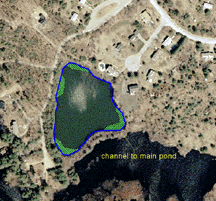 |
| Glenwood Road basin (or "Dug Pond"), showing areas infested with fanwort |
The former gravel pit, now a shallow 3.9-acre basin at the end of Glenwood Road, is infested with fanwort, a non-native invasive weed that plagued Foster's Pond for years until the
Corporation undertook a successful herbicide treatment in 2005. Dug Pond, separated from Foster's Pond by a narrow berm, empties into its much larger neighbor, carrying seeds and weed fragments that are likely to reestablish fanwort in the 120-acre main water body.
In a letter mailed to residents in the Glenwood Road/Morningside Drive area, FPC President Steve Cotton asked for contributions "to save this wonderful resource in your backyard."
The treatment plan, which has been authorized by the Andover Conservation Commission, will cost $5,750.
The treatment consists of injecting a diluted herbicide through weighted hoses just below the water surface. The herbicide - fluridone, sold under the brand name Sonar - prevents green plants from producing yellow pigments which protect chlorophyll in the plants from breaking down under sunlight. Without the yellow pigments, the plants slowly bleach out and die, a process known as chlorosis. Sonar is the least toxic herbicide approved in Massachusetts for use against aquatic weeds, and the only one effective against fanwort. (To read a technical review of fluridone, contained in the State's encyclopedic Generic Environmental Impact Report on aquatic plant management, click here.)
 |
| August 2004: Fanwort in the main pond |
Temporary water use restrictions endorsed by the Andover Board of Health for the Foster's Pond weed control program prohibit swimming, boating or fishing in the treated water body on the day Sonar is injected. Because the chemical has a short half-life, breaking down in sunlight, one or two "booster" applications may needed in the course of a 60-day period. (Two booster treatments were applied to Foster's Pond in 2005.) Throughout the treatment period, water from the treated basin should not be used for irrigation, since the treated water will have the same effect on lawns as it has on the fanwort.
 |
| June 2005: Fanwort shows signs of chlorosis after 1st Sonar treatment in main pond |
Sonar is not a permanent solution to the fanwort problem. Treatments typically hold for two or three years, though they may endure for longer periods. But there is no alternative. Leaving fanwort untreated - as was the case in Foster's Pond itself for decades - can lead to a pond-clogging explosion of growth that chokes out other plants, overtakes natural habitats, and precludes fishing, swimming, or boating. There are no biological controls, such as the weevil that eats Eurasian watermilfoil. And while some states permit the use of grass carp to control aquatic weeds, Massachusetts flatly prohibits their use - noting that they can grow into four-foot long, 100-pound behemoths, spread disease, decimate native flora and fauna, and increase algae. In its most comprehensive environmental review, the State's Department of Environmental Protection has termed the use of herbicides to control fanwort "a necessity until some other more long-term control, such as plant-eating insects, can be established."
The fund-raising drive has a deadline imposed by nature. Sonar is only effective against fanwort if applied when the weed is just starting to grow - usually, late May or early June. The first Sonar treatment in last year's successful program was on June 6. There's about a month of pretreatment paperwork required, so the money must be in hand by mid-April for the project to proceed this year.
Conservation
Commission OKs Plan to Treat Glenwood Basin
February, 2006
The Andover Conservation Commission has unanimously approved the Foster's Pond Corporation plan to treat the Glenwood Road basin with Sonar this spring.
The February 21 vote sets the stage for the FPC to begin raising the $5,750 cost of the herbicide treatment of the 3.9-acre swimming hole, which is separated by a narrow berm from the rest of Foster's Pond. If the funds are raised, the treatment will begin in late May or early June.
 |
| August 2004: Fanwort in the main pond |
Last year, the Corporation undertook a $42,500 treatment of the main pond to combat fanwort, a non-native invasive weed that had taken over most of the pond's 120 acres. By mid-summer, the weed - which in previous years was so thick it could be raked in large clumps from the surface - had all but vanished.
But the same careful survey which found fanwort virtually eradicated from the main pond
 |
| Glenwood Road basin (or "dug pond"), showing areas infested with fanwort |
And that could spell trouble not only for the smaller water body - where swimmers complained of being caught up in the weeds - but for the newly cleared main pond. Through much of year, water flows from the Glenwood Road basin into the main pond, and since fanwort spreads both by seeds and fragmentation, that flow is likely to carry the fast-growing weed back into Foster's Pond, where it will quickly re-establish itself.
The Corporation voted in January to tackle the weed problem in the Glenwood Road basin - if contributors come through with the $5,750 cost. The money must be raised quickly, because Sonar - to be effective - must be applied early in the growing season. That usually means sometime between mid-May and early June.
To contribute to this effort, download a contribution form. Your contribution is tax-deductible.
Conservation
Commission to Vote February 21 on Glenwood
Basin Weeds
February, 2006
The Andover Conservation Commission, after a brief discussion of the Foster's Pond Corporation plan to treat weeds in the Glenwood Road basin, took no action February 7, postponing a vote until the Commission's next meeting.
That meeting is scheduled for February 21.
The FPC proposal was Item #26 on the Commission's February 7 agenda, and - following a two-hour discussion of changes to the Andover wetlands regulations - a weary commission called on FPC President Steve Cotton to address the weed proposal at 10:57 p.m. Earlier, Commission Chairman Don Cooper had said that he would impose an 11:00 p.m. "curfew" on the meeting, which had been scheduled to end at ten. Cooper also announced that with so little time available, he would not put the weed matter to a vote.
Cotton asked the Commission to act at its next meeting, pointing out that Sonar - the only herbicide that works on the nuisance weeds in the basin - must be applied during a narrow window from mid-May to early June in order to be effective. He said the FPC would need time to raise the $5,500 to $6,000 cost of the project and sign a contract with the applicator - who, in turn, will need approximately a month to secure the State permit required for each use of an aquatic herbicide.
The formal issue to be decided by the Commission is whether the treatment of the 3.9-acre basin - which neighbors call the "dug pond" - represents a "significant" change to the treatment plan for Foster's Pond authorized by the Commission last year, and that new conditions are needed to govern treatment of the former gravel pit. If so, a lengthy hearing process will be required, starting with formal notices to abutters and advertising in local papers; if not, a simple majority vote will greenlight the project.
The FPC position is that a 2006 follow-up treatment is not a "significant" change in the plan - and was indeed authorized by the Commission's 2005 approval of herbicidal treatment of nuisance vegetation in the Pond. That approval, which included an Order of Conditions which was subsequently upheld by the State's Department of Environmental Protection, encompassed the Glenwood Road basin, specifically listing the book and page number at the Registry of Deeds where the Town recorded its 1990 Order of Taking of the popular swimming hole. It also allows Sonar treatments, as needed through 2009, subject to advance approval by a majority vote of the Commission.
The 2005 treatment program approved by the Commission targeted the 120 acres of the main pond - but left out the much smaller Glenwood Road basin. Now that fanwort - and Brazilian elodea, another invasive nuisance - have been found in the "dug pond," the Corporation's weed consultant has recommended treatment. The Glenwood Road basin empties into the main pond in high water conditions, and seeds or fragments of the nuisance weeds carried into the larger water body can root and spread.
Conservation
Commission to Consider Glenwood Basin Weeds
February, 2006
The Andover Conservation Commission is scheduled to take up a recommendation by the Foster's Pond Corporation to allow Sonar treatment of the Glenwood Road basin. The matter will come before the Commission at its February 7 meeting.
The 3.9-acre former gravel pit off Glenwood Road is owned by the Town. It is separated from the rest of Foster's Pond by a narrow berm, but in high water conditions, the spring-fed basin flows into the main pond. The basin was found last year by the Corporation's weed consultant to be infested with fanwort - the invasive nuisance that was virtually eliminated from the main pond by a $42,500 treatment program. The consultant warned that fanwort - as well as a second invasive plant, Brazilian elodea, which had not been found in the main pond - could spread if not treated in 2006.
FPC President Steve Cotton will present the consultant's findings and urge the Commission to authorize treating the basin with Sonar, the herbicide used in the 2005 to get rid of the nuisance weeds in the main pond. An affirmative vote on Tuesday would allow the Corporation to initiate efforts to raise the $5500 to $6000 cost of the treatment.
Corporation
Endorses Treatment of Glenwood Road Basin
January, 2006
Corporation members voted unanimously January 17 to seek Sonar treatment of the Town-owned Glenwood Road basin. The former gravel pit, separated in all but the highest water conditions from the rest of Foster's Pond by a narrow berm, was not treated in 2005.
 |
| Glenwood Road basin, showing areas infested with fanwort |
But the Corporation's weed consultant found fanwort in the 3.9-acre basin last fall, and recommended treatment to forestall reinfestation of the remainder of the Pond. The consultant, in a year-end report to the Corporation, estimated the cost at $5500 to $6000. The consultant also found a second invasive weed in the basin -Brazilian elodea - that had not been found elsewhere in Foster's Pond.
At the Corporation's annual meeting January 17, members strongly supported treatment of the Glenwood Road basin, a favorite swimming spot for residents of Glenwood and Snowberry Roads. The basin is ringed by Town conservation land. The Town acquired the area in 1990.
FPC President Steve Cotton is scheduled to discuss the matter with the Andover Conservation Commission on January 24. He will recommend that the Commission vote to approve treatment of the basin under the provisions of the same Order of Conditions which authorized the Corporation's 2005 weed program. That Order of Conditions is in force until 2010.
The next step after that: finding the money to undertake the project.
Final
Report: Sonar Worked, But Keep an Eye Out for Weeds
January, 2006
At year's end, the Corporation's weed consultant issued its final report on the 2005 treatment of Foster's Pond with Sonar.
The conclusion: "The Sonar treatment completely controlled fanwort growth at Foster's Pond, providing greater than 99% control of the nuisance weed." In August, 2004, the non-native invader had been the dominant plant in the Pond, covering an estimated 50% of its 120 acres, the most prevalent species in 34 of 39 data point locations surveyed by senior biologist Marc Bellaud of Aquatic Control Technology. After treatment of the Pond in 2005, wrote Bellaud in his report, his survey of the same data points found that fanwort had been "nearly eliminated." He described encountering one small patch that was "highly chlorotic and unhealthy" as a result of the herbicide.
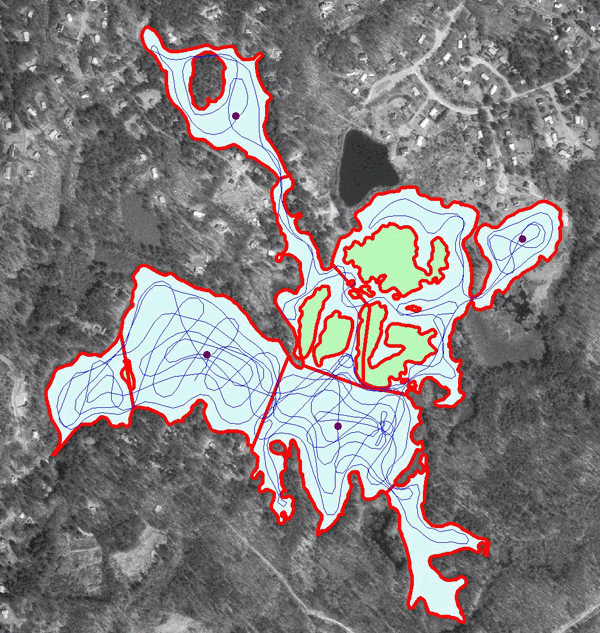 |
| Airboat treatment path, 6/6/05; untreated Glenwood Rd. basin is dark area at top |
The ACT report also documents the survival of nine submerged plant species and eight floating leaf or emergent species that were not targeted. Noting that the native submerged plants and floating-leafed water lilies had been thinned out, the report indicates that these species "typically rebound the year after treatment." The emergent species (those growing above the water line, such as cattail) were unaffected by the treatment, according to the report. The report also found no adverse effect on fish or other wildlife.
The report, which was submitted to the Foster's Pond Corporation on
December 28, makes five recommendations:
- Train volunteers on how to identify fanwort and pull it out by hand. Fanwort is easily confused with native look-alikes which are not troublesome. And it must be pulled out carefully by the roots, as floating fragments can develop roots, sink to the bottom, and regenerate. The State runs a "weed-watchers program" which sends experts out to train local groups; State personnel have offered to come to Andover to run a training session for the FPC.
- Conduct a follow-up plant survey in 2006. Under
this recommendation, ACT would return to take samples at each of the 39
data points surveyed in the prior studies, documenting conditions and
keeping track of weed growth and the appearance of fanwort or any other
nuisance plant. The cost: $1,750.
- Treat the dredged basis off Glenwood Road. This 3.9-acre pool is a former gravel pit that, at low water, is separated from the rest of the Pond by a narrow berm. At high water, it merges with the rest of the Pond. Almost all of the land around it is owned by the Town, and it provides public access (albeit, with no parking) for swimming. It was not treated in 2005. But Bellaud discovered that it does contain patches of fanwort, as well as another non-native pest, Brazilian elodea. The recommendation: spot-treatment with Sonar at a cost of $5,500 to $6,000.
- Two further recommendations, if and when conditions warrant, are for using bottom weed barriers on small, dense beds of fanwort or, if larger areas appear, spot-treating them with Sonar.
To download the full report, click here
Biologist Returns for Post-Treatment
Assessment
September, 2005
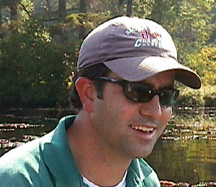 |
| ACT Biologist Marc Bellaud |
The rake told the story. Again and again, Marc Bellaud tossed it overboard, dragging it a few feet across the bottom of Foster's Pond. And again and again, it came up with a few leaves, or a handful of filamentous algae. What it didn't come up with was a huge clump of the fanwort that last year - and for many previous years - choked all but the deepest parts of the Pond.
"I'm not seeing any," said Bellaud, who is senior biologist at Aquatic Control Technology, the contractor employed by the Foster's Pond Corporation to consult on weeds and apply Sonar to the Pond earlier in the summer. "Not even remnants."
 |
| August 2004: This year, the rake was
empty |
Later in the sampling process, he dredged up sickly strands of fanwort in two spots. The larger patch was an outcropping about a foot in diameter in two feet of water in the northerly cove between Azalea Drive and Snowberry Road.
"This is in pretty rough shape," he said as he examined a decaying stem. "I don't think it's going to make it."
Bellaud, accompanied by FPC President Steve Cotton, crisscrossed the Pond in an 8-foot flat-bottomed boat on September 14, using a GPS locator to find each of the 39 points from which he had taken samples in August, 2004. That's when ACT undertook the plant survey that led to the use of Sonar herbicide to control fanwort. The 2004 survey found fanwort to be "the most prevalent [plant] species" in 34 of the locations.
Bellaud stopped at the same spots and tossed the rake in. He came up with a number of native species, including coontail, but the fanwort had all but vanished. (For some before-and-after pictures of the Pond, taken in August 2004 and August 2005, see Weeds Wilt, below.)
Bellaud raked the bottom, peered into an underwater TV camera, tested for oxygen levels, and assessed water clarity. The data will go into a written report that ACT will submit to the Corporation later this year. As he worked, he also answered a series of questions that residents had e-mailed to Cotton.
Ask the
Biologist . . . Q & A With Marc Bellaud
[Note: Some of the
questions have been slightly paraphrased. The answers are based
on notes, not an electronic recording.]
Q: Will
hydro-raking spread the cabomba
(fanwort)?
A: Not
now. I doubt very much there are any viable roots which are hardy
enough that the hydro-rake uncovering them will stimulate new growth.
Q: What
are those huge floating things that look like pineapples? Should
we try to get them out of the water? What will happen to them if
we do nothing?
A: Those
are lily roots. When they float, they're pretty severely beat up,
and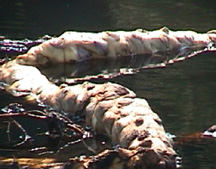 they're
dying. The decay produces gasses, and that's what
causes them to float. Eventually, they'll sink to the bottom,
decompose, and turn into muck. That will happen when we get
colder temperatures. Frost will stop the decomposition and the
build-up of gasses. A small percentage may hang on and
re-root. You can see some small sprouts in some of them.
Certainly, getting the floating roots out of the water is not a bad
thing to do. But they can smell pretty horrible when they break
down on dry land. They can give off an ammonia smell.
they're
dying. The decay produces gasses, and that's what
causes them to float. Eventually, they'll sink to the bottom,
decompose, and turn into muck. That will happen when we get
colder temperatures. Frost will stop the decomposition and the
build-up of gasses. A small percentage may hang on and
re-root. You can see some small sprouts in some of them.
Certainly, getting the floating roots out of the water is not a bad
thing to do. But they can smell pretty horrible when they break
down on dry land. They can give off an ammonia smell.
Q: What can we do to
treat the water lilies that come back?
A: I'm surprised
we saw so much impact on the lilies. Often, we don't see as much
of an effect, particularly along the shorelines. We can expect
them to come back, but in fairly reduced densities next year. You
can still see a lot of lilies growing. Where you see the sickly
leaves at the surface, you can expect to see them back. In places
where we see the lilies with more green to them [for example, the
channel and Mill Reservoir], they will certainly be back next year.
For individual homeowners, hydro-raking gets out the
lilies and the muck. Purely from a cost standpoint, for control
of the weeds, glyphosate
is cheaper and probably more long-lasting. It's a topical
treatment on the pads themselves. Typically, it's applied mid to
late summer. The active ingredient is what's in Round-Up.
Rodeo is the product that's approved for use in the water. Of
course, individuals can't use it. It has to be applied by a
licensed applicator.
Q: What's the
effect of the dead fanwort on the oxygen and pH levels in the
Pond? Has additional biomass started to decay, hastening
eutrophication?
A: The
effect on oxygen has been fairly low, because the plants die so
slowly. There isn't a great surge of plants dying all at once,
which would have greater effect. The pH is not affected. [Note: In the absence of Sonar, the
fanwort would have grown more robustly, and then, at the end of the
season, died, fallen back in the water column, and decayed.]
Q: Why has the Pond
become a Gatorade color over the past week? When can we expect
that condition to pass?
A: The
color you're seeing may be a reflection off the Pond bottom, based on
the low water level and the absence of fanwort you've seen in the
past. You're also seeing the effects of microscopic algae in the
water. Because of the low water level, no water is flowing over
the dam, so there's a lack of flushing. That affects water
clarity, too. Cooler temperatures will make a difference.
And next year, you'll see less algae and greater water clarity.
Q: What has the
effect been on native plants? Will they rebound?
A:
Native plants have taken a hit, too, but they'll come back.
You'll see recolonization of the bladderwort. The coontail will
come back. We also saw stonewart - that's a type of algae [near
the Goldsmith shoreline]. That's good to see. It's a kind
of aquatic mulch, and it provides good habitat. That may have a
chance to spread.
Q: What is your
estimate of what the Pond will look like over the next few years?
A: Next
year it's going to look great. There will be very little
fanwort. The lilies will start to come back. I expect less
algae, better water clarity. Usually, we see two to three years
of very good control [of fanwort]. After four to five
years, people begin to ask for retreatment. But predictions
beyond the second year start to get a little dicey.
Q: Could we have gotten
these results with a big drawdown and hand-pulling?
A: No
way. You couldn't draw this pond down enough. You'd have to
re-engineer your dam, and I don't think you could get State approval to
draw the Pond down far enough even then. If you have low enough
density, in a small area, hand-pulling would be a good option to keep
the fanwort at bay. In anything 4 feet deep or greater,
hand-pulling means diving. It's very slow work. You need to
take the time to get out the roots. If you break it off, you'll
spread it. Having acres and acres of high-density fanwort - like
what you had here - makes hand-pulling impractical.
Q: Would it make
sense for us to train some volunteers to look for fanwort outbreaks?
A:
Yes. If you see any next year, it will be late in the
season. If you see it when it's low enough density, you can
consider hand-pulling. That would be a good option to keep it at
bay. In '07, you may need to consider spot treatment if you find
an isolated patch in a protected cove. But spot treatment is
going to be very hard if you find it in the main Pond, because the
Sonar won't stay in one place.
Q: Why is
there increased pondweed in Frye's Brook? Is it related to Sonar?
A: The
ribbon-leaf pondweed in Frye's Brook is a good plant. It's
native, and it's slow-growing. It propagates by seeding
itself. I don't know why you're seeing more of it this year, but
Sonar would not have anything to do with the increase. It may
have something to do with siltation from the sewer project upstream;
maybe some seeds washed downstream. We've seen some ribbon-leaf
pondweed in the Pond, but it's not something to worry about.
As
Fanwort
Fades, No More Treatments On Tap
August 2005
With the Pond's fanwort invasion in full retreat, Aquatic Control Technology has concluded that the nuisance weed will continue to die without another round of herbicide treatment.
ACT was responding to laboratory analysis of water samples taken August 11, when the company's senior biologist, Marc Bellaud, toured the Pond to observe the progress of the Corporation's weed control efforts. What little fanwort he could find - even in coves that had been clogged with the stuff this time last year - was stunted and decayed, exhibiting no bright-green tips of viable growth.
He said then that even very low levels of Sonar - the herbicide which has broken fanwort's chokehold - would be adequate to finish the job of killing the non-native species which had become the dominant plant in most of the Pond.
Throughout the treatment regimen, which began June 6, the aim had been to keep the Sonar concentrations at 10 to 20 parts per billion - with 10 ppb adequate to kill healthy fanwort, and 20 ppb considered by State and Federal regulators to be safe even in public drinking water.
The newest test results show that Sonar concentrations in the main Pond - last treated on July 14 - had fallen to 11.9 ppb and 9.6 ppb at the two locations which were sampled. In the Mill Reservoir (the excavated cove near Azalea Drive, where Frye's Brook empties into the Pond, diluting the water), the concentration was 6.6 ppb. In the channel, the Sonar level stood at 13.2 ppb.
These concentrations were considerably lower than they had been in samples tested in late July, reflecting Sonar's short half-life as it deteriorates in sunlight. But in ACT's view, the levels are adequate to do in the already-weakened fanwort.
In an e-mail to FPC President Steve Cotton on August 16, Bellaud stated:
The lakewide average is still over 10 ppb. Mill Reservoir continues to be lower (6.6 ppb), but we didn't find any viable fanwort in there. Considering the condition of the remaining fanwort plants and the higher than expected Sonar concentrations, we are comfortable saying that another booster treatment is not needed. The plants should be completely controlled within the next couple of weeks.
Experts from ACT will return to the Pond in mid-September for another inspection
Biologist
Finds
Fanwort Die-Off Throughout Pond
August 2005
Aquatic Control Technology's senior biologist, Marc Bellaud, inspected the Pond August 11, looking for signs that any fanwort might have survived the herbicide treatment aimed at destroying the nuisance weed. But as an assistant dropped a rake, time and again, over the side of ACT's aluminum motorboat, dragging the bottom for weeds, what came up was some algae, a few strands of native coontail, and - occasionally - some stunted and decaying fanwort stems.
Bellaud's conclusion: the Pond will probably not need further treatment this summer as the fanwort die-off progresses. He took water samples, which will be sent to a lab, to determine Sonar concentrations, but said that fanwort in the Pond now appears so weakened that whatever Sonar remains in the Pond will likely be enough to finish the job of killing the non-native pest. Results from the lab tests will be known next week, at which time a final decision will be made about further treatment.
Bellaud noted that algae concentrations in the Pond may have increased somewhat as a result of the Sonar treatment, due to added nutrients from decaying plants killed by the herbicide. But he said that ponds throughout Massachusetts are experiencing increased algae blooms this summer as a consequence of high temperatures and sunny weather. He predicted that next year, as water lilies and other native plants rebound from this year's Sonar treatment, the algae will decline.
Weeds Wilt As Sonar Levels Hold
Steady
August 2005
 Fanwort in the channel, August 16, 2004 (above) and same location, August 5, 2005 (below)  |
To the delight of area residents, the Sonar treatment of
Foster's Pond has visibly cut the dense weed growth that last summer
choked even the deepest areas. For the first time in years,
previously impenetrable coves are now open to swimming, canoeing, and
fishing.
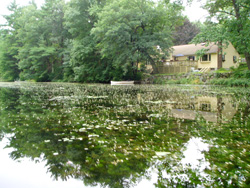 August 2004 (above); August 2005 (below) 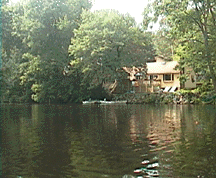 |
Dave Brown went swimming in the channel from his Glenwood Road
dock. Steve Cotton swam to the middle of the main Pond from his
dock on Pomeroy Road. And Andover Street resident Jon Richards
went fishing for the first time since last year. No big deal - except
that all three were amazed to find that they encountered few weeds.
As Jon wrote of his experience,
I was STUNNED to see the improvement! The results are nothing short of dramatic. There is very little sign of ANY visible fanwort in all the areas of the pond that we encountered. Last year on the eastern side of the pond, there was such a large mat of fanwort that we could not fish that area out to almost one-third of the way into the large part of the Pond. Yesterday we were able to fish within a few yards of shore. I never even caught a piece of fanwort on my fishing lures! . . . Oh, and by the way, fishing was better than ever. I caught six different species of very healthy looking specimens, and my friend caught and released a beautiful six-pound largemouth!
Laboratory tests of water samples taken on July 27 showed Sonar concentrations in all parts of the Pond holding steady at just the right levels to kill fanwort, the nuisance weed that is the target of the herbicide treatment program.
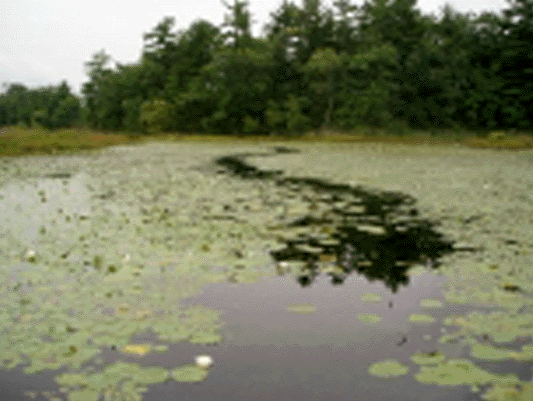 |
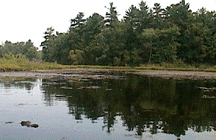 August 2004 (top);
August 2005 (bottom) August 2004 (top);
August 2005 (bottom) |
In the main Pond, two samples showed concentrations of 14.2 parts per billion and 13.9 ppb. A sample from the channel had a concentration of 15.2 ppb, while the Mill Reservoir - showing the dilution effect of the inflow from Frye's Brook - had a concentration of 12.6 ppb. A concentration above 10 ppb is effective against fanwort. The maximum concentration allowed under the Corporation's permit is 20 ppb - a level that regulators regard as safe even for such sensitive waters as public drinking supplies.
Based on the newest readings, weed control experts at Aquatic Control Technology determined that there was no immediate need for a third "booster treatment." They will visit the Pond in the next week or so to assess the condition of the weeds and decide whether further testing - or treatment - will be necessary.
But for many residents, it didn't take an expert to tell them that the Sonar has made a huge - and welcome - difference.
Fundraising Goal Topped: FPC
Raises $43,100
September, 2005
The contract for treating Foster's Pond with Sonar had a price tag of $42,500, and that was the goal set by the Corporation's Fundraising Committee back in April.
It took just four months to get there. As of the end of July, FPC Treasurer David Brown and Fundraising Committee Chairman Marty Rabinowitz reported contributions totaling $40, 850, with another $1,650 pledged. By September 10, contributions totaled $43,100.
The money came from 58 households in the Foster's Pond area - and one Andover contributor who lives a couple of miles away.
The Corporation will need more money to deal with expected weed re-infestations, and for maintaining the Foster's Pond Dam. Contributions are always welcome.
Second Booster
Treatment
Targets Pond July 14; Water Use Restrictions In Effect
July 2005
With its invasive fanwort in slow retreat, Foster's
Pond
got a second "booster" treatment of the
herbicide which has begun to kill the nuisance weed.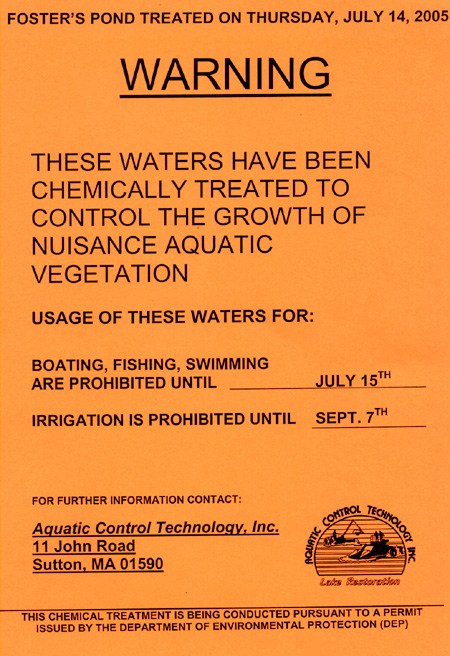
Booster treatment #2 was applied on Thursday, July 14. One-day water use restrictions took effect Thursday, July 14 - no boating, fishing or swimming until Friday, July 15. Pond water should not be used for irrigation until September 7.
Technicians from Aquatic Control Technology launched their airboat shortly before 10 a.m., then circled the Pond, dropping off warning signs for volunteers to post. Once the signs were up, the treatment began.
The entire Pond received an infusion of Sonar, which is injected into the water through weighted hoses trailing from either side of the fast-moving craft. It took about two hours to finish the job, as the airboat - the same type of craft used to navigate swampy areas such as the Everglades - careened in and out of the Pond's lily-covered coves.
Marc Bellaud, ACT's senior biologist, was at the controls.
Observing the condition of the
Pond's abundant fanwort, he said that the Sonar appears to be doing its
job. He said that healthy fanwort is bright green, but he noted
that fanwort in the Pond - visible a couple of feet below the water's
surface, each stem looking like a test-tube brush - is a dull green or
brown, with whitened tips. The sickly appearance, he said, is due
to the Sonar, which causes the plant to bleach out and slowly die.
Lab results from samples taken from four locations on July 4 indicated that Sonar concentrations throughout the Pond fell, as expected, over the previous two weeks. Sonar has a short half-life, and whenever the weather turns wet, some of the chemical is washed over the dam, further lowering the concentration in the Pond.
At two locations in the main Pond, Sonar concentrations were measured at 11.6 and 11.7 parts per billion. In the channel, the reading was 11.7 parts per billion. In the Mill Reservoir (the excavated cove near Azalea Drive where Frye's Brook feeds the Pond), the concentration had fallen to 6.5 parts per billion, below the level needed to kill fanwort.
The target Sonar concentration is between 10 and 20 parts per billion - high enough to subdue the fanwort, but sufficiently low that native plant species will recover. State and Federal regulators regard 20 ppb as safe for public drinking water, and even though no one drinks directly from the Pond, the treatment plan calls for concentrations to stay within that limit.
The booster treatment will bring concentrations back up to the 20 ppb level.
Herbicide Starts Its
Work: Fanwort Begins to Fade
June 2005
Three weeks after the initial Sonar treatment of Foster's Pond, the target weed began showing signs of succumbing to the slow-acting herbicide.
Fanwort, the non-native nuisance that has become the Pond's dominant
plant species, is normally bright green, especially at the tips from
which new growth emerges.
But those tips have faded to white, tinged with pink - the first symptoms of the herbicide's lethal effect. Sonar (the brand name for fluridone) inhibits the formation of carotene, which protects the plant's chlorophyll from degrading in sunlight. As the chlorophyll bleaches out, the plant is unable to produce carbohydrates, and it dies - usually over a period of 30 to 90 days. Biologists regard the slow rate of die-off as a benefit of fluridone, minimizing the risk that decaying plants will deplete oxygen in the water.
The Sonar is also affecting hardier plants, including native water lilies, which are fading due to the same process, known as chlorosis. The native species, however, will rebound from the low concentration of Sonar that has been applied. That concentration will not exceed 20 parts per billion, a level State and Federal regulators regard as safe enough to be allowed in public drinking water.
To be effective, the a Sonar concentration between 10 and 20 ppb must be maintained for 60 to 90 days. Since Sonar itself has a short half-life, and some is constantly being washed out of the Pond by way of the dam, periodic booster treatments are necessary.
Pond Gets Booster Treatment
#1 on June 21; Water Use Restrictions in Effect
June 2005
The weed-zappers made a return visit on June 21 after getting the lab results on the initial Sonar treatment of Foster's Pond two weeks earlier.
Under sunny skies, technicians from Aquatic Control Technology whisked
their One-day water use
restrictions
were put into effect Tuesday, June 21 - no boating, fishing or
swimming. These uses may resume on Wednesday, June 22. Pond
water should not be used for irrigation until September 7.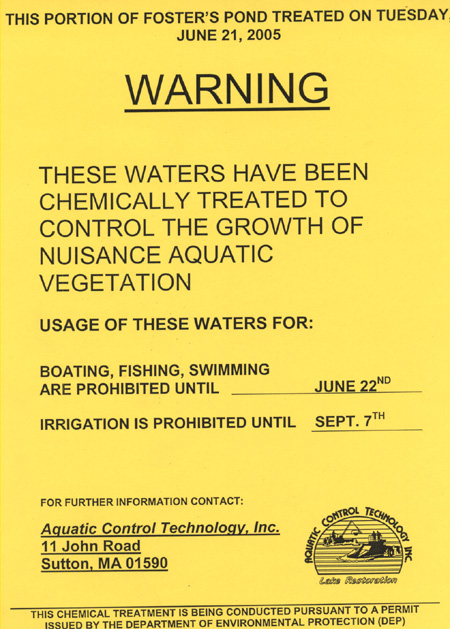 airboat from the dam through the channel, and
into the Mill Reservoir, injecting a second dose of the herbicide
into the weed-choked waters. No additional Sonar was applied to
the main Pond.
airboat from the dam through the channel, and
into the Mill Reservoir, injecting a second dose of the herbicide
into the weed-choked waters. No additional Sonar was applied to
the main Pond.
Water samples taken from two locations last Thursday - the Mill Reservoir near Azalea Drive and the channel, southeast of Rock Island - revealed that concentrations of the herbicide had fallen below what it takes to kill fanwort. These areas got the "booster" treatment, aimed at bringing the concentration back up to the 10 to 20 parts per billion range needed to vanquish the invasive nuisance that is choking the Pond.
Concentrations of Sonar in the main Pond were right at the target levels - 19.6 ppb at one location, and 17.2 ppb at another. But in the channel, which carries outflow towards the dam, the concentration had fallen to 8.4 ppb, just below the low end of the recommended dosage. And in the Mill Reservoir, where Frye's Brook - the Pond's main water source - flows into Foster's Pond, the concentration had fallen to an anemic 1.5 ppb.
The four water samples were taken on June 16 by Weed Committee Co-Chairman David Adilman and FPC President Steve Cotton, then sent by overnight delivery to a SePRO laboratory for analysis. SePRO is the manufacturer of Sonar. The samples were analyzed Friday, June 17, and the results provided to Aquatic Control Technology late that day. On Monday, ACT notified the FPC of the results and scheduled Tuesday's booster treatment.
The low concentrations in two areas are the result of rainy weather in the days following the June 6 treatment of the Pond. Although the FPC had attempted to draw the Pond down a full foot below the level of the dam's spillway, torrential rains prior to June 6 had left the water level even with the spillway. When the rains came after June 6, water again started spilling over the dam, and the outflow has continued. The Mill Reservoir and the channel are the areas of the Pond most directly affected by the flushing effect of these flows, and the lab results show the consequences.
The process of testing water samples from the Pond, and applying booster treatments as concentrations fall, is all part of the program. Sonar has a short half-life, and its concentration drops off no matter what the weather. In rainy weather, particularly where the outflow rises, dilution contributes to lowering the concentration. In drier conditions, when the Pond water evaporates and outflow decreases, the concentration may be maintained for a longer period. The objective of frequent testing is to keep the Sonar concentration within the target range over a period of 60 to 90 days.
The Pond will be tested again in about two weeks.
Sonar
Comes in With a Roar
June 2005
The long-awaited weed treatment of Foster's Pond roared to life June 6, as technicians gunned an 18-foot airboat across the calm waters for two hours, injecting an herbicide to kill nuisance vegetation that has troubled area residents for years.
Months of planning, study, hearings, and fund-raising gave away to the
spectacle of the speediest
watercraft ever to navigate the Pond's 120 acres, careening in and out
of every cove with an ear-splitting roar and churning up a fine spray
with the backwash of its massive airplane propeller. The
boat, powered by a V-6 engine, makes such a racket that those on
board must wear ear-protectors to muffle the sound..
The craft is owned and operated by Aquatic Control Technology, Inc., of Sutton, Massachusetts, the contractor hired by the Foster's Pond Corporation to study the weed problem and apply the herbicide.
The airboat arrived at the Willard Circle launch site at 4:30 p.m., and
was soon in the water. With ACT President Gerry Smith at the
helm, and senior biologist Marc Bellaud
taking readings, the boat circumnavigated the Pond to check out inflows
from Frye's Brook and outflow over the dam. A week earlier, stop
logs had been pulled from the dam, drawing water from the Pond.
Although the plan had been to lower the Pond by one foot in preparation
for the treatment, torrential rains the previous week left the water
level almost exactly at the height of the dam's spillway. As the
treatment began, the stop logs were replaced, reducing the outflow to
practically nothing. But as the water level rises, with more
rains in the forecast, Sonar will be washed out of the Pond, requiring
at least one and most likely two "booster" treatments over the next two
months.
The Sonar treatment lasted barely two hours, with the airboat out of the Pond by 6:45 p.m.
The Sonar was injected into the Pond through weighted hoses trailing alongside the boat. The quantity of herbicide was calculated to maintain a concentration in the Pond of 20 parts per billion - enough to kill fanwort, the non-native weed which has become the dominant plant species in much of the Pond, but so dilute that State and Federal regulators regard water with that level of Sonar as safe to drink.
Sonar acts on the weeds by retarding the production of
yellow pigments which  protect chlorophyll
from breaking down under
sunlight. Without the yellow pigments, the plants slowly bleach
out and die. Bellaud said that residents who closely observe the
fanwort - now visible in some sections of the Pond, with bright green
feathery branches about a foot from the surface - may see the tips
start turning white, with a pink tinge, in the next two to three weeks,
the first sign that the chemical is
working.
protect chlorophyll
from breaking down under
sunlight. Without the yellow pigments, the plants slowly bleach
out and die. Bellaud said that residents who closely observe the
fanwort - now visible in some sections of the Pond, with bright green
feathery branches about a foot from the surface - may see the tips
start turning white, with a pink tinge, in the next two to three weeks,
the first sign that the chemical is
working.
FPC volunteers will still have work to do to ensure the success of the weed program. The Fundraising Committee is continuing to contact area residents who have not yet contributed to cover the costs of the treatment. And Weed Committee members will be taking samples of Pond water, which will be tested to determine when the first "booster" treatment will be scheduled.
Sonar
Contributions Top
$38,500 from 50 Households
June 2005
Contributions to pay for treating the Pond with Sonar this Spring have topped 90% of the $42,500 cost of the project.
The Corporation has collected $36,275, with another $2,375 pledged, for a total of $38,650 from 50 households.
Stage Set for
Sonar
Treatment
June 2005
On May 31, notices went out to nearly 90 households on or near the Pond, and on June 4 orange warning signs went up on trees, mailboxes, and telephone poles near all access points. The message: Sonar is coming to Foster's Pond on June 6, and the Pond will be closed to boating, fishing and swimming for the day.
The notices and posters also advise residents not to use Pond water to irrigate plants for the next 90 days - since the treated water will have the same lethal effect on tender land plants that it is intended to have on fanwort in the Pond.
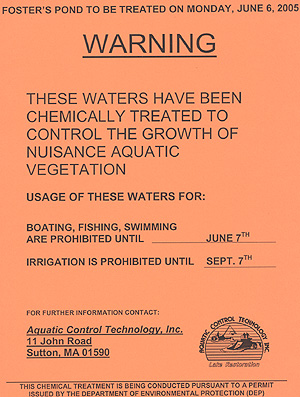 Mother Nature did not cooperate with the drawdown, however. No
sooner had stop logs been removed from the dam than the skies opened
up, and before the storms were over, the water level of the Pond had
actually risen by about 4 inches. Indeed, so severe was the rise
that, had the sluiceway not been opened, it appeared that the dam would
have overtopped - a dangerous condition that is never welcome for an
earthen dam. But, as the storms subsided by week's end, the Pond
level started to drop, with just a trickle coming over the spillway on
the Saturday leading up to the Sonar treatment. That's about 2
inches lower than when the drawdown began. With dry weather in
the forecast, Dam Committee Chairman Paul Ross and Weed Committee
Co-Chairman David Adilman estimated that a drop of another 2 to 3
inches might be achieved before the Sonar treatment begins.
Mother Nature did not cooperate with the drawdown, however. No
sooner had stop logs been removed from the dam than the skies opened
up, and before the storms were over, the water level of the Pond had
actually risen by about 4 inches. Indeed, so severe was the rise
that, had the sluiceway not been opened, it appeared that the dam would
have overtopped - a dangerous condition that is never welcome for an
earthen dam. But, as the storms subsided by week's end, the Pond
level started to drop, with just a trickle coming over the spillway on
the Saturday leading up to the Sonar treatment. That's about 2
inches lower than when the drawdown began. With dry weather in
the forecast, Dam Committee Chairman Paul Ross and Weed Committee
Co-Chairman David Adilman estimated that a drop of another 2 to 3
inches might be achieved before the Sonar treatment begins.
Aquatic Control Technology, under contract with the Foster's Pond Corporation to apply Sonar to the Pond, is scheduled to perform the work Monday afternoon, June 6. ACT will launch an airboat from Willard Circle in the afternoon, then inject the herbicide into the Pond from weighted hoses. The work is expected to be finished by evening.
Drawdown Commences Under
Rainy
Skies
May 2005
On May 23, the Foster's Pond Corporation program to control nuisance weeds made the transition from talk to action, as Dam Committee Chairman Paul Ross removed the first "stop log" from the dam, starting the first drawdown of the Pond in more than 30 years. Paul started the drawdown at 9 a.m., under a light drizzle that continued through the day, developing into a heavier rain.
The level of the Pond will be allowed to drop by a foot in the next two weeks, in preparation for the main event - the injection of an herbicide, Sonar, to combat the fanwort invasion that is choking the Pond. That will come June 6, when the Corporation's weed abatement contractor, Aquatic Control Technology, will launch an airboat on the Pond and apply a dilute solution of the chemical through weighted hoses.
At least 90% of the targeted weed is expected to die off in the following 60 to 90 days, leaving room for native plants and clearing much of the Pond's open water of a nonnative invader regarded by State regulators (and Pond residents) as a nuisance species.
Drawdown Slated to Begin
May 23 in Preparation for Sonar Treatment
May 2005
Twenty months ago, Foster's Pond area residents - meeting to revive the Foster's Pond Corporation - put weed control at the top of the organization's "To Do" list. Since then, hundreds of hours of volunteer labor have gone into studying, discussing, and devising a plan, then securing regulatory approvals and the funding to implement it. On May 23, a simple act will begin the most expansive - and expensive - weed abatement program ever attempted in this Pond: FPC Dam Committee Chairman Paul Ross will remove an 8-inch "stop log" from the dam, allowing the Pond level to start dropping gradually. In about a week, a second board will be removed, letting the Pond level fall by a total of one foot.
The aim of this drawdown - the first time the Pond level has been intentionally lowered in more than 30 years - is to retard outflow starting on June 6, when the Pond will be treated with Sonar, an herbicide that is the only effective remedy for the nuisance weed which is choking the Pond.
The drawdown, previously approved by the Andover Conservation Commission and the State's Department of Environmental Protection, received its final okay on May 18, when officials at the State's Division of Fisheries & Wildlife notified the Corporation that the drawdown could proceed. The Corporation has mailed a notice to 13 occupied Pond-area residences with shallow wells, announcing the start date and providing phone numbers to call in the unlikely event that any well loses water.
Contract Signed, Date
Set for Sonar Treatment: June 6
May 2005
On May 16, the Sonar treatment plan made the turn to the home stretch. There is now a scheduled date for the initial infusion of the herbicide into the Pond: Monday, June 6.
Technicians from the FPC's licensed applicator, Aquatic Control Technology, will launch an airboat from Willard Circle, then spend the day injecting the Pond with a diluted solution so weak that State and Federal regulators say treated Pond water would be safe to drink - but strong enough that the company has guaranteed, in its contract with the FPC, that at least 90% of the biomass of the targeted fanwort will be knocked out within 60 days.
The $42,500 contract was signed May 16. Then, ACT Senior Biologist Marc Bellaud and FPC President Steve Cotton toured the Pond, with Bellaud raking the bottom at various points to determine the state of fanwort growth. New, bright green growth was just emerging from last year's plants, leading Bellaud to settle on June 6 as the right moment to zap the invasive weed with the first round of Sonar. One, and perhaps two, "booster" treatments will be applied at intervals of about 30 days.
Later the same evening, Bellaud and Cotton, joined by Weed Committee Co-Chairmen David Adilman and Mark Florio, appeared before the Andover Board of Health to finalize the temporary water use restrictions that will go into effect on the first treatment date. The Pond will be posted with bright orange signs warning against fishing, swimming and boating on June 6 - the treatment date - and further warning not to use Pond water for irrigation for the next 90 days. New signs will go up for each "booster" treatment, with the same one-day restrictions on the day the chemical is applied. The Board of Health unanimously approved these restrictions, which will also be set out in a letter to be mailed to every Pond abutter.
Corporation
Board Says This is the Year: Votes to Start Sonar Treatment This
Spring
May 2005
The Board of Directors of the Foster's Pond Corporation voted unanimously on May 4 to proceed with applying Sonar this Spring, while continuing to raise money to pay for the project. The vote means that the FPC's weed control program could take the plunge from printed page to treated Pond by the end of the month, as the last few pieces of the complicated regulatory picture fall into place.
The nine-member Board heard first from treasurer Dave Brown and Fundraising Committee Chairman Marty Rabinowitz, who - after tallying checks brought in by some of the Board members - reported that $29,650 had been collected so far, with another $3,700 pledged, for a total of $33,350. The cost of treating the Pond is $42,500.
Rabinowitz reported that the Fundraising Committee is confident that additional contributions will be forthcoming, and other Board members echoed this view. The Board then took the formal action needed to move the treatment plan forward, voting to authorize President Steve Cotton to sign a contract with Aquatic Control Technology to apply the Sonar this Spring.
A biologist from Aquatic Control Technology (ACT) will look at the Pond on May 16, to check out the stage of plant growth and see what inflow and outflow conditions are like. A schedule for applying the herbicide will be determined then - with treatment likely to take place sometime between the week of May 23 and the week of June 6. There will be one and perhaps two "booster" treatments, to maintain the target concentration of 20 parts per billion, at intervals of about one month.
The Corporation has asked the State's Division of Fisheries and Wildlife (which calls itself "MassWildlife") for authorization to draw the Pond down a few inches to contain the Sonar, but treatment can proceed with or without this drawdown. In the meantime, the State's Office of Dam Safety has given a green light for the drawdown. The drawdown, earlier approved by both the Andover Conservation Commission and the State's Department of Environmental Protection, still requires an okay from MassWildlife.
Representatives of the FPC and ACT will also be meeting with the Andover Board of Health to determine whether the local Board wants to recommend any water use restrictions when Sonar is in the Pond. At the 20 ppb concentration that will be used in Foster's Pond, State and Federal regulators have set no restrictions on swimming, fishing, or drinking; the only advice on the product label is that the water not be used for irrigation for 30 days after each application, because treated water will kill the plants that are being irrigated.
If there are any water use restrictions, they will be set forth in notices the FPC will send to all Pond abutters prior to the application of Sonar. Also, warning signs will be posted at various access points to the Pond. In addition, if there is a drawdown, shallow well-owners will be notified in advance and given phone numbers to call if they lose water. Since, in past years, the Pond was drawn down much further with no water losses, no one is expected to lose water from this drawdown.
FPC Weed
Program Clears Final Regulatory Hurdle: Appeal Deadline Passes,
DEP Approval Becomes Final
April 2005
The Corporation's weed control program - including the use of Sonar and annual winter drawdowns - has cleared its final regulatory hurdle. The program had been approved by the Andover Conservation Commission, whose decision was affirmed by the regional office of the State's Department of Environmental Protection. The deadline for challenging the DEP action expired on April 5, with no one filing an appeal.
That means that the DEP okay is now final - or, as one DEP official put
it in an e-mail to FPC President Steve Cotton, "I would say you should
be set to go."
Aquatic
Control Technology, the company which has advised the FPC and will
apply the Sonar, must still secure a DEP license to use the herbicide
in Foster's Pond, but this is a routine process which does not involve
hearings and appeals. ACT will also meet with the Andover Board
of Health in May to see if Town health officials want to impose
stricter water use standards than those required under Federal and State
regulations.
DEP Upholds Corporation Weed
Program: Regional Office Turns Down Appeal By Area Resident
March 2005
The State's Department of Environmental Protection has rejected the
appeal of an area resident who opposed the Corporation's plan to use a
combination of Sonar and winter drawdowns to combat the spread of
nuisance vegetation in Foster's Pond.
DEP's regional office approved the proposed project, affirming the
Andover Conservation Commission's January 21 Order of Conditions, which
had paved the way for the Corporation-backed program to go forward.
In a brief letter announcing its decision, DEP officials stated, "In
the Department's opinion, the Andover Conservation Commission
appropriately reviewed and conditioned the proposed project in a manner
adequately protecting the interests of the [Wetlands Protection]
Act." The letter was signed by Richard Tomczyk, Acting Section
Chief of DEP's Wetlands and Waterways Program, and Jill Provencal, the
DEP Environmental Analyst who had earlier conducted a site inspection
to review the plan.
DEP issued a formal order adopting the earlier action of the Andover
Conservation Commission. The DEP order is dated March 22, 2005,
just one week after Ms. Provencal's site visit.
DEP Conducts Site
Visit: Decision Near on Review of Conservation Commission Order
March 2005
An environmental analyst from the Regional Office of the State's Department of Environmental Protection conducted a "site inspection" on March 15, the first step in a review of the Andover Conservation Commission's approval of the Foster's Pond weed control program.
The analyst, Jill Provencal, convened the informal one-hour meeting under sunny skies. Participants stood in the driveway of 2 Foster's Pond Road, whose owners offered the venue so that attendees and their cars would be safely off the street.
DEP's review was triggered by a Pomeroy Road resident's appeal of the Conservation Commission's unanimous vote okaying the Corporations integrated management program for Foster's Pond weed control. The Commission issued three pages of "special conditions" allowing herbicide use and annual winter drawdowns.
Provencal's role at the meeting was to hear from all concerned parties. The participants included the appellant; the Town's two conservation agents, Robert Douglas and Linda Cleary; and four FPC representatives - Steve Cotton, Weed Committee Co-Chairman David Adilman (a professional hydrogeologist), Dam Committee Chairman Paul Ross, and Gerry Smith (president of Aquatic Control Technology, which produced the report on which the FPC program is based).
The appellant summarized her opposition to the Conservation Commission order, saying that herbicides "scare the hell out of me." She said that she is "totally against chemicals" for weed control, attributing the weed problem in the Pond to lawn fertilizers and faulty septic systems. She said that use of Sonar is a "Band-Aid" approach. She also opposed drawdowns, expressing concern that the proposed 18" annual drawdowns might adversely affect her artesian well. She said that her well, shown on documents filed with the Board of Health as located 500 feet from the Pond, is 345 feet deep.
Cotton gave an overview of the proposed weed control program, noting
that Sonar is the only
control method the State authorizes for
widespread fanwort infestations. He read from DEP documents
which state that rooted weeds like fanwort
cannot be controlled by
reducing runoffs from lawns or septic systems. Adilman indicated
that there is no possibility that Sonar - which binds to organics in
the soil. then degrades - could find its way to the appellant's well;
he stated that it won't affect his well, which is far closer to the
Pond.
Sonar is the only
control method the State authorizes for
widespread fanwort infestations. He read from DEP documents
which state that rooted weeds like fanwort
cannot be controlled by
reducing runoffs from lawns or septic systems. Adilman indicated
that there is no possibility that Sonar - which binds to organics in
the soil. then degrades - could find its way to the appellant's well;
he stated that it won't affect his well, which is far closer to the
Pond.
Cleary, speaking on behalf of the Conservation Commission, noted that Sonar has been used in a pond which is in the same watershed as the Town's drinking water supply, and has also been used in Pomp's Pond, where the Town beach is located. She said that the Conservation Commission stands by its order, which she described as tightly written with more safeguards than are usually contained in such orders.
Smith described specific projects in which the State has approved Sonar use in other ponds, noting that the plan here is completely in accordance with the State's Generic Environmental Impact Report - a comprehensive document covering all weed control techniques.
A decision by the DEP regional office - in the form of a letter sent to the parties - is expected shortly.
Weed Program
Advances: Conservation
Commission Issues Its Orders, 1 Resident
Appeals, FPC Responds, and Fund-Raising Committee Is Launched
February 2005
The Andover Conservation Commission, after unanimously approving the
Corporation's integrated management program
for weed control in Foster's Pond, formally issued the final text of
the rules governing the administration of the program. The three pages of "special
conditions" closely follow State requirements for herbicide use and
winter drawdowns. For example the Corporation's contractor (Aquatic
Control Technology), will have to obtain a State permit to apply
Sonar in the Pond, a routine process which will rely on extensive
documentation which the Corporation has already assembled. And
the Corporation will also need to secure the approval of the State's
Department of Fish & Game, Division of Fisheries & Wildlife
(which now calls itself "MassWildlife") before initiating any
drawdown. The Corporation has previously been in touch with the
responsible official at MassWildlife, and this is not likely to be a
problem.
As expected, one neighborhood resident appealed the Conservation
Commission's decision, requesting a review by the regional office of
the Department of Environmental Protection. She expressed concern
that her well would be affected by an 18-inch drawdown and by the use
of Sonar in the Pond. The appeal was filed three days after the
Commission's unanimous vote on January 4 in favor of the
Corporation's plan - and a full two weeks before the Commission
released the final text of its Amended Order of Conditions on January
21. Under State regulations, the deadline for filing an appeal
from the Commission's decision was February 4. No other appeals
appear to have been filed.
FPC President Steve Cotton filed a written response to the appeal on
February 4, asking DEP to dismiss it. The Corporation, at its January meeting, had
authorized the president to intervene in
administrative proceedings to defend the Commission's order.
Cotton, in a 5-page letter, argued that under State regulations the appeal should be turned down
because the complaining resident - whose property is about 200 feet
from the Pond, and whose well appears to be about 500 feet from the
Pond, according to Town records - does not have legal "standing" to
appeal. State regulations allow ten town residents to file
appeals of Conservation Commission decisions, but a lone resident must
show that he or she is either a direct abutter or "may suffer an injury
in fact" that goes beyond something that may affect the general public.
Meanwhile, the Corporation voted at its January meeting to establish a
fund-raising committee to brainstorm ways of raising the $42,000 cost
of applying Sonar to Foster's Pond. The chairman of the
committee, and its members, are listed above.
Conservation
Commission Votes Final Approval to Corporation's Program to
Control Weeds
January 2005
The Andover Conservation Commission
voted unanimously on January 4 to authorize the Foster's Pond
Corporation to use Sonar for the control of fanwort
and to lower the level of the Pond by up to 18" each winter.
The final vote came at the end of three evening hearings on the
Corporation's plan, set out in an October report commissioned by the Corporation and
prepared by its weed consultant, Aquatic
Control Technology, Inc.
The Commission, as part of its vote okaying an "Order of Conditions,"
approved a three-page set of procedures which will govern the
application of Sonar and the scheduling of drawdowns. The final
text will not be released until the Order is formally issued, a process
which could take up to three weeks.
The Order of Conditions requires the issuance of a permit by the State
Department of Environmental Protection's Division of Watershed
Management prior to the use of Sonar. This permit - which is
routinely issued by DEP - is obtained by the contractor which
will apply the Sonar.
The contractor, under the Order of Conditions, will also meet with the
Andover Board of Health prior to the initial Sonar treatment, to review
the treatment schedule, application procedures and temporary water use
restrictions. The FPC will be required to mail notices to
abutters before Sonar is used, containing the treatment schedule and
any temporary water use restrictions. (At the low concentrations of
Sonar that would be used, there are no State-imposed restrictions on
using well water or swimming, but the notices will likely advise
residents to stay out of the water for a limited time and not use water
from the Pond for irrigation for at least 30 days.)
The Order of Conditions also requires the FPC to notify the Department
of Fish & Game's Division of Fisheries and Wildlife prior to any
drawdown of the dam and to mail advance written notices to occupied
residences which depend on shallow wells for their drinking
water. Based on the Corporation's well survey (see box below), a
dozen occupied homes around the Pond would be notified. Although
the hydrological estimates of the Corporation's Weed Committee indicate
that no one will lose water (and some shallow well users have said that
they don't care, as long as it's for the good of the Pond), any
drawdown will be done slowly, so that the stop logs can be restored if
a problem develops.
Technically, the authorization approved by the Commission applies to
the Commission itself, which undertook the burden (and expense) of
being the applicant. But the Order designates the Foster's Pond
Corporation to implement the "integrated management plan" for weed
control. Under the plan, individual shoreline owners may continue
to have hydro-raking done (following the same procedures which have
been in effect, under the same permit, since 1992). The use of
Sonar and annual winter drawdowns are now added to the program - along
with a requirement that the FPC maintain its on-going program of
educating pond abutters, other area residents, and the general public
on watershed management practices to reduce the
introduction of nutrients to the pond.
The Order also specifically authorizes -and indeed requires - the
Corporation to maintain the dam, keeping it clear of woody brush and
working with the Andover Department of Public Works to ensure that the
Rattlesnake Hill Road culverts are clear of debris.
The Order approved by the Commission will expire in five years, and may be further extended.
Conservation
Commission Votes Preliminary Approval of Corporation's Weed Program
December 2004
The Andover Conservation Commission gave a preliminary thumbs-up to the Corporation's multi-pronged weed control program, in two votes taken at a Commission hearing just before Christmas.
The votes followed a presentation by FPC president Steve Cotton, Weed Committee Co-Chairman Dave Adilman, and two representatives of the Corporation's weed consultant, Aquatic Control Technology, Inc. - its president, Gerry Smith, and senior biologist Marc Bellaud.
The Commission's preliminary votes - a unanimous endorsement of the FPC plan for winter drawdowns, followed by another unanimous vote to allow the use of Sonar for treatment of fanwort - set the stage for a final approval, in January, of an "Order of Conditions" detailing the procedures that will govern the weed-control efforts.
Still to come is a decision by the Corporation on whether to try to raise the estimated $40,000 cost of applying Sonar.
The Commission's preliminary votes came on the second of two evening sessions at which the FPC plan was discussed. At an introductory hearing on November 16, the FPC representatives introduced the plan, contained in a report commissioned by the Corporation in May and completed in October. The report was prepared by Aquatic Control Technology (ACT).
At the November hearing, one area resident objected to any drawdown and to the use of Sonar; two others opposed the use of Sonar. About 15 residents came to show their support for the program.
At the second session, a roomful of area residents raised their hands to show their backing for the FPC weed control program. The Commission noted that it had received one letter opposing the entire program (from the resident who had spoken at the earlier hearing); one of the other residents who had earlier opposed Sonar asked questions of the ACT representatives and indicated that she took some comfort from the efforts that would be made to minimize Sonar use and monitor the concentrations.
The FPC weed control plan, in addition to winter drawdowns and Sonar use, will continue to facilitate mechanical weed removal through hydro-raking. And the Corporation will renew its efforts to encourage the use of phosphate-free dishwashing soaps, laundry detergents, and fertilizers.
Weed
Study: Drawdowns and 'Sonar' Recommended to Fight Fanwort
October 2004
Weed control experts hired by the Foster's Pond Corporation in 2004 surveyed the vegetation in the Pond and recommended an integrated program including winter drawdowns and chemical treatment to fight the fanwort - a non-native invader that has spread throughout the Pond and is now our most prevalent plant.
The report, prepared by Aquatic Control Technology, Inc., was commissioned by the Corporation in May and completed in October, with a draft submitted in time for consideration at the Corporation's September meeting. To read the entire report, click here.
The report examines all of the alternatives for managing the fanwort
problem, including the
option of doing nothing. "Leaving the
fanwort growth unmanaged will result in increased fanwort densities and
additional displacement of native species," says the report. It
also states, "On-going management will be required for the foreseeable
future to maintain adequate fanwort control to preserve suitable fish
and wildlife habitat as well as recreational uses of the pond."
including the
option of doing nothing. "Leaving the
fanwort growth unmanaged will result in increased fanwort densities and
additional displacement of native species," says the report. It
also states, "On-going management will be required for the foreseeable
future to maintain adequate fanwort control to preserve suitable fish
and wildlife habitat as well as recreational uses of the pond."
The report notes that, because Foster's Pond owes much of its area to damming, it has "fertile bottom sediments that can support abundant aquatic plant growth." This means that our efforts to control nutrient inputs - for example, the Corporation's educational efforts to inform homeowners about using phosphorous-free detergents and organic fertilizers - are important to preserve water quality, but these efforts "will do nothing to control nuisance fanwort growth." The reason: rooted plants like fanwort draw their nutrients from bottom sediments, and even the complete shut-off of point and non-point nutrients from other sources won't suppress the spread of fanwort.
The report recommends chemical treatment as "the most effective and commonly employed means of controlling nuisance fanwort growth."
Fluridone (sold under the brand name Sonar) is the only herbicide now registered in Massachusetts for the control of fanwort. The State has approved only six active ingredients for use as aquatic herbicides, describing fluridone as "the least toxic" of those allowed in the State's lakes and ponds. This quote appears on page 4-91 of the Final Generic Environmental Impact Report (GEIR): Eutrophication and Aquatic Plant Management in Massachusetts, published in June, 2004, by the Department of Environmental Protection and Department of Conservation and Recreation. The 514-page GEIR represents the State's definitive position on the environmental effects of all management techniques.
How does Sonar work? It prevents green plants from producing yellow pigments which protect chlorophyll from breaking down under sunlight. Without the yellow pigments, the plants slowly bleach out and die. The process (called "chlorosis") can take upwards of 6 to 8 weeks - an advantage, since the slow dying avoids the prospect of sudden oxygen depletion (which could result in fish kills) or nutrient release (which could result in algae blooms).
Is there much experience with its use? Sonar was introduced in 1979. In 2002 (the most recent year for which data are provided in the GEIR), its use was approved for 60 water bodies in Massachusetts.
What will the effects be on shallow wells? At the concentrations that Sonar would be used in Foster's Pond for fanwort control - 20 parts per billion -
Well survey
The Weed Committee, during November and December, 2004, surveyed residents to determine the location and depth of all wells in the vicinity of the Pond. Most residents have deep wells or are supplied with Town water. In all, 15 properties are served by shallow wells; two of these are on properties unoccupied much or all of the time, and one is used only for irrigation. On average, the shallow wells are located 60' from the Pond. Even the wells closest to the Pond are - in the view of hydrogeologist David Adilman, Co-Chairman of the FPC Weed Committee - highly unlikely to be affected by a drawdown or to suck Sonar-treated water from the Pond. |
Are
there
swimming or fishing restrictions? There are no swimming
or
fishing restrictions associated with use of fluridone in Massachusetts
(though New York prohibits swimming for 24 hours after
application). The Andover Board of Health will be given an
opportunity to add restrictions on swimming or fishing , and if it does
so, these will be posted before fluridone is used in the Pond.
Fluridone has not been identified as a carcinogen
or a mutagen. The Washington State fact sheet says, "Fluridone
does not significantly bioaccumulate or biomagnify in fish."
Water from the Pond should not be used for irrigation for 30 days after
application (unless filtered through a charcoal filter), since it may
have the same effect on the plants you're watering as on the target
weeds.
Is Sonar a permanent solution? No. Sonar use is likely to provide 2 to 3 years of effective control, after which spot treatments of "hot spots" might prolong control for another year or two. The cost of the initial treatment has been put at $32,250 to $42,500. The Corporation will carefully monitor the Pond, with trained volunteers and systematic vegetation surveys, to ensure a prompt response to the re-emergence of fanwort infestations.
Drawdowns
The report also recommends lowering the Pond over the winter months by
12 to 18 inches. The principal reason for winter drawdowns is dam
safety. At least twice in the last three years, the Foster's Pond
dam has overtopped - that is, water flowing over the dam has exceeded
the capacity of the concrete spillway, rushing over the earthen top of
the dam on both sides of the spillway.
Overtopping is the most
common
cause of catastrophic failure of an
earthen dam, and the
remedy is simple: draw down the water level
of the Pond during the winter, so that there is room for the Pond to
accommodate the combination of snow melts and spring rains without
overtopping.
As the report notes, winter drawdowns can also help control nuisance weeds. Exposing aquatic plants to freezing and drying conditions can kill them, and fanwort is one species that is susceptible to this treatment. The report says:
It would enable homeowners to remove leaf litter and other debris from their immediate shorelines, as well as providing access for dock or wall maintenance. Limited drawdowns should provide an added benefit of flushing suspended debris, sediments and nutrients out of the pond and help to preserve water quality.
Drawdowns used to be an annual ritual for Foster's Pond residents. The last drawdown was apparently conducted in 1973, when the level was dropped by about a foot.
The recommended drawdown could be achieved by repairing the "stop logs" in the dam - removable planks which allow the water level to be dropped in stages. The Corporation's plan, approved at the September 2004 meeting, is to implement the drawdown as soon as permission is received from the Town's Conservation Commission - while closely monitoring shallow wells, to ensure that no one loses water. Historically, it appears that drawdowns did not result in water loss when shallow wells predominated around the Pond. Shallow wells would normally be expected to have their intakes at least 3 or 4 feet below the level of the ground water, so that a modest drawdown would not affect them.
Hydro-raking is not recommended for the control of fanwort in the densities we now have in Foster's Pond, although individual homeowners may continue to find the hydro-rake useful for removing lilies and muck from their shorelines. Thus, hydro-raking will continue to be a part of our integrated management strategy.
The Corporation should continue its efforts to educate residents about using phosphate-free dishwashing soaps, phosphate-free clotheswashing detergents, and organic fertilizers. These measures - together with septic system upgrades as homes change ownership and Title V requirements kick in - will keep down the nutrients which fuel algae blooms in the Pond. However, as the report states, "Rooted plants derive the majority of their nutrients from the bottom sediments, which watershed management cannot address." That is why, as the report states, the control of nutrient inputs "will do nothing the control the nuisance fanwort growth." But it is part of a sound integrated management strategy, which includes preservation of water quality.
 Read the complete report from Aquatic
Control Technology. Aquatic
Plant Survey and Development of a Nuisance Aquatic Plant Management
Plan for Foster's Pond (October, 2004). This is the basis for
the Corporation's weed management plan.
Read the complete report from Aquatic
Control Technology. Aquatic
Plant Survey and Development of a Nuisance Aquatic Plant Management
Plan for Foster's Pond (October, 2004). This is the basis for
the Corporation's weed management plan.
 Here are the most relevant sections of the State's Generic Environmental Impact Report,
which contains the Department of Environmental Protection's evaluation
of alternative strategies for managing aquatic weeds:
Here are the most relevant sections of the State's Generic Environmental Impact Report,
which contains the Department of Environmental Protection's evaluation
of alternative strategies for managing aquatic weeds:
Herbicides and Algaecides. An overview of all the products permitted in Massachusetts and their appropriate uses.
Fluridone. A detailed discussion of the herbicide recommended for use in Foster's Pond.
Fluridone Toxicology. Technical information from the Appendix of the GEIR.
Drawdown. A detailed discussion of the use of drawdowns to control weeds.
Corporation Votes for Weed Study; Biologist
Collects Data
August 2004
"That's fanwort," said biologist Marc Bellaud, as he dipped his hand into Foster's Pond and pulled out a small, white flower, trailing a couple of feet of delicate, bright-green stem resembling a green test-tube brush.
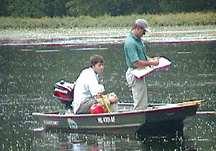 Bellaud was just starting an afternoon of data collection, the
cornerstone of a study to determine
what weeds are clogging the water and what remediation techniques may
work.
Bellaud was just starting an afternoon of data collection, the
cornerstone of a study to determine
what weeds are clogging the water and what remediation techniques may
work.
From the bow of a 12-foot aluminum boat, with an assistant manning the 4HP outboard motor, Bellaud crisscrossed the Pond on August 16, taking soundings, observing weed concentrations, and sampling bottom sediments.
The results of the study, together with recommendations, will be presented to the Corporation in September. The report is critical for any recommendations the Corporation may make to the Andover Conservation Commission, which has jurisdiction to decide what remediation measures may be used in the Pond.
Following an afternoon of sampling, Bellaud found no surprises. He reported that fanwort is the "dominant submerged species - actually, it's the dominant plant overall." Next in order of concentration, said Bellaud, are coontail, bladderwort, and water lilies.
Bellaud hopes to incorporate in his report data on pond depths put together in an earlier study by Weed Committee Co-Chairman David Adilman.
On the recommendation of the Weed Committee, the Corporation voted unanimously at the May, 2004, meeting to fund a study to determine what weeds are in the Pond, and their relative concentration.
The Corporation engaged Aquatic Control Technology, Inc., to perform the study. Bellaud is senior biologist at ACT, which has performed hydro-raking on the Pond since 1992 and has advised the Corporation on past weed-control efforts.
The field work was scheduled to be done in August at the height of the summer weed growth.
Here is ACT's formal description of the scope of the work:
This survey will involve collecting data at sampling points along several transects that will be established in the pond. All sampling points will be recorded with Aquatic Control’s Differential GPS Unit, which is accurate to within one meter. At each sampling point, Aquatic Control will record water depth; bottom type; percent bottom cover for all plants; record and list all plant species observed at the site, in decreasing order of abundance; and assign a biomass value from 0-4 (low to high) based upon height or volume of the plant growth throughout the water column.
Deliverables from this task will be one map showing the distribution and relative cover/biomass the overall plant assemblages throughout Fosters Pond, including and native plants as well. These maps shall be drawn using Aquatic Control’s ArcView GIS system. The data from each data collection site will also be presented in tabular form to allow for statistical comparison in the future. We will also interpret the data and provide you with a narrative of the conditions in the pond and outline management recommendations complete with cost estimates.
Read the Weed Committee's report to the Corporation at the January 13, 2004 meeting.
Committee Hears from Expert
At its second meeting, the Foster's Pond Corporation Weed Committee heard a detailed overview of weed control alternatives from one of the foremost experts in the region.
Gerry Smith, president of Aquatic Control Technology, Inc., spent two hours with the committee on December 8, reviewing the cost and effectiveness of a wide range of weed control methods. His company engages in weed control on more than 500 ponds annually in New England and Eastern New York. The company has performed hydro-raking for Foster's Pond residents since 1992. The company also sold the FPC a weed harvester which the FPC operated successfully for several years in the 1980's.
One key recommendation Smith made was that the FPC should conduct an
aquatic plant survey to identify which weeds are in the pond and where
they are concentrated. He said that any control strategy will depend on
the information gathered in such a survey, and the the Andover
Conservation Commission is likely to require the information prior to
granting a permit to implement a weed control program. He also
recommended that the FPC, at the same time, perform some water sampling
and consider a study of the Pond's "phosphorous budget" - essentially,
an estimate of the sources and levels of phosphorous (a nutrient which
stimulates algae growth) coming into the Pond.
concentrated. He said that any control strategy will depend on
the information gathered in such a survey, and the the Andover
Conservation Commission is likely to require the information prior to
granting a permit to implement a weed control program. He also
recommended that the FPC, at the same time, perform some water sampling
and consider a study of the Pond's "phosphorous budget" - essentially,
an estimate of the sources and levels of phosphorous (a nutrient which
stimulates algae growth) coming into the Pond.
Answering the committee's questions in a lively give-and-take, Smith discussed herbicides, dredging, harvesting, hydro-raking, biological controls, and winter drawdowns, providing information on the pros and cons and the cost ranges of each approach. Click here for a 2-page chart of weed control techniques Smith prepared; it lists methods targeting specific plants, how the methods work, concerns relating to each method, and ballpark costs.
This was not be the first time Smith has offered advice to the Foster's Pond Corporation. In 1981, he toured the Pond, examined the weed growth, and met with the FPC committee (then called the Condition of the Pond Committee) which was trying to come up with a weed control program for that era. For a report of the 1981 committee meeting, with its survey of alternative strategies, click here. Smith has also provided advice to the FPC informally over the ensuing years.
The Weed Committee held its first meeting on October 22, reviewing several strategies for dealing with the weed problem in the Pond. There was also discussion of performing a watershed survey, a weed assessment, and a geochemical assessment.
The Committee has established an ambitious research agenda, with plans
to investigate five pond-restoration alternatives: harvesting,
winter draw-down, herbicides, dredging, and grass carp. The
Committee hopes to gather information on past and current projects on
other ponds (particularly in Massachusetts), and the results and costs
of these projects.

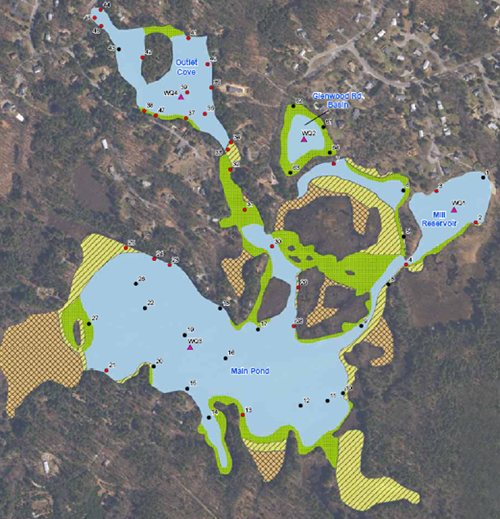

 Questions? Comments? Contact us at
Questions? Comments? Contact us at